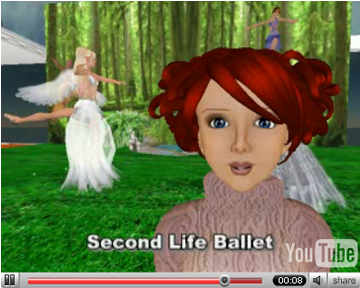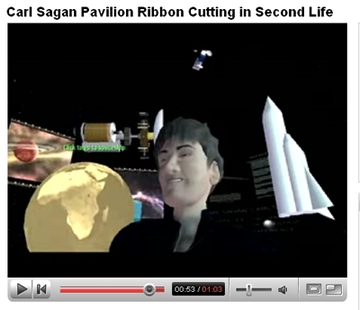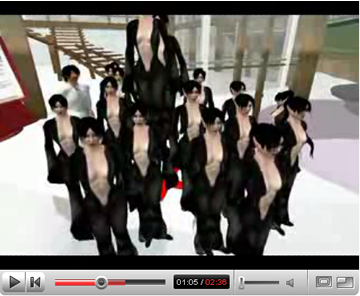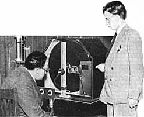July 11, 2007
Placeholder: Voiceholders and Voicemarks

Brenda Laurel writes: "[...] Rachel has described our interest in how people leave marks on places. We wanted to give people the ability to "mark" the virtual environments, and we arrived at voice as a convenient modality for doing so. Voice offered several advantages over writing or drawing. Through prosody, voice permits greater expressiveness and personalization than writing; it is also more immediate. Most people are less self-conscious about speaking than about drawing. While drawing would require that we build special virtual drawing tools, capturing voice was relatively easy to implement.
Where and how could voices be stored and re-played? We designed the Voiceholders as virtual record/playback devices. A Voiceholder would capture and store an utterance, called a Voicemark. A "full" Voiceholder (that is, one containing a Voicemark) would play its contents when touched. In order to encourage people to play with relationships among Voicemarks and between Voicemarks and landscape features, we made the Voiceholders moveable, exempt from gravity, and able to be placed anywhere one could reach. Voiceholders could be moved by grabbing them (closing the grippees while the points of light were "inside" the rock), dragging them to the desired location (they would stick to your hand), and releasing the grip.
We wanted people to think of the Voiceholders more as tools or agents than as devices; machines (including tape recorders) were inconsistent with the fantasy context. We designed them as rocks with faces, using the facial expressions to indicate the state of the Voiceholder. This was as close as we came to an iconic or symbolic interface element..."
Image: When a voiceholder was empty, its eyes and mouth were closed and it was dark. When a person touched an empty voiceholder, its eyes would open and it would light up from the inside (rather like a jack-o'-lantern) and a voice (emanating from the voiceholder) would say "I'm listening." If a person spoke when a voiceholder was in that state, their speech would be recorded. When the voiceholder became "full" (i.e., ran out of space in the sound file it was creating) the inner light flickered and then went out (rather like a guttering candle), the yes would close and the mouth would open to indicate that it was ready to speak. If a person touched a voiceholder in this state, it would open its eyes, light up and play back its contents, then it would "go to sleep" again.
From Placeholder: Landscape and Narrative In Virtual Environments :: ACM Computer Graphics Quarterly Volume 28 Number 2 May 1994 :: Brenda Laurel, Rachel Strickland, Rob Tow, Interval Research Corp :: Copyright © 1994 by the ACM. Videos available here.
Posted by jo at 07:34 PM | Comments (0)
July 06, 2007
Art makes a scene on Second Life
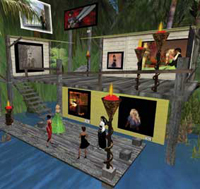
"One of the Best Places for Artists, Curators and Dealers to Meet"
With over 7m registered users, Second Life—an online virtual world complete with land, residents and a growing economy—is developing one of the largest art communities on the internet. The site’s money-making and marketing potential to reach a new, younger audience is already being tapped by major corporations such as BMW, Adidas and Sony, which all have a presence there. Entire countries have also established virtual outposts. The Maldives was the first nation to open an embassy on Second Life’s “Diplomacy Island”, where visitors can consult an ambassador about visas, trade and other consular issues. It was quickly followed by Sweden, while online embassies for the Philippines and Macedonia are under development.
Museums, universities and non-profit organisations are getting involved as well. In the art world, the Andy Warhol Foundation has helped fund exhibitions and projects in Second Life, such as “Mixed Realities”, an annual juried competition set up in 2004 with Turbulence.org, a group that has supported art on the internet since 1996, to commission five new online art works. Each winning proposal receives $5,000." Continue reading Art makes a scene on Second Life: The online virtual world is becoming one of the best places for artists, curators and dealers to meet, by Helen Stoilas, July 4, 2007, The Art Newspaper.
Posted by jo at 12:10 PM | Comments (0)
June 26, 2007
Ars Virtua Presents: We are the Strange
Ars Virtua is proud to present the Second Life premier of We are the Strange :: June 29 at 6:00 pm SLT [SLURL].
M dot Strange takes us into the new realm of video game structured and inspired storytelling with his character's harrowing quest for ice cream. The variety of animation styles, game and cultural references and distopian beauty of this work make it important to modern filmmaking. Add to this that m dot strange created this virtually single handedly and had it selected for Sundance based on his YouTube audience and you end up with a very powerful piece of contemporary media.
We are the Strange is an animated feature film in which two diametrically opposed outcasts fight for survival in a sinister fantasy world. After meeting in the somber Forest of Still Life, an abused young woman (Blue) reluctantly follows a care free dollboy (Emmm) to Stopmo City on his unreasonable quest for ice cream. They're lives are constantly in jeopardy after they're caught in the middle of a deadly battle between bizarre monsters on their way to the ice cream shop. A flamboyant ultraviolent hero(Rain) appears and effortlessly dispatches all the horrible monsters in his path. Blue meets Rain before he partakes in an impossible battle against the source of all that is evil in Stopmo City. When it seems as if darkness will have the last laugh a gleaming fist made of aluminum foil bursts through the ground thus starting the final showdown
between mega_good and hyper_evil.
We Are the Strange is its own imaginative and immersive universe. M dot Strange spent three years painstakingly creating this film, using a range of animation techniques: traditional, stop-motion, computer, and his own unique blend of 8-bit graphics and anime, dubbed "Str8nime." The stunning visuals are complemented by a soundtrack that is both beautiful and harrowing. The end result is a freaky technocarnival ride that climaxes with a momentous battle between innocence and darkness.
Posted by jo at 12:17 PM | Comments (0)
June 20, 2007
[iDC] game culture (?) (!) (%#@)
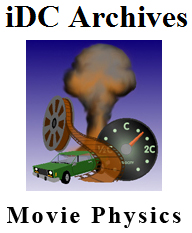
Game Physics
[...] I am at the beginning of some research into the area of game physics (that is, the simulation of physics in video games) ... The research is somewhat motivated by several observations:
Physics has an interesting split personality in that it is viewed as very fundamental in the sciences with a lot of 'prestige' (Einstein is a folk-hero), but at the same time Physics seems to be largely rejected as a discussion topic by non-science educated folks. As soon as it gets a bit more detailed and mathematical, most people will react try to avoid Physics. The current state of physics education (low number of graduates, etc.) confirms this.
Games on the other hand are well on the way (if not already there) to become the most used, most influential, most profitable entertainment medium. Therefore one can safely assume that they exert a significant influence on our culture. This trend which will continue in the years to come, especially as graphics capabilities reach photorealistic levels.
Game Physics is an element in video games that was always present and is even at the root of games (SpaceWar, the first video game was a physics simulation). It is becoming even more common due to the 3D and immersive nature of todays video games, because it makes games 'playable'. Generally it is a very important aspect of games since it is directly linked to the interactivity and 'feel' of the gameworld, but as a topic of game theoretical analysis, it is often overlooked.
As for some specific questions, I am currently interested in a discussion on how games affect the relationship we have with the real world. Obviously there are social implications to video game play as we can see from the whole "violence in games" debate. In relationship to Physics, I am looking at more fundamental changes in how we construct truths: Does video game physics create a form of "folk physics" (my immediate answer would be yes) and does that change the way we think or even act? For readers unfamiliar with video games, think of the 'Movie Physics' - which todays games largely adopt - such as the engine roar of a space ship flying by the camera (... this should be silent in vacuum).
So in some sense, the question extends the common "does it matter that movies have pseudo physics?" discussed extensively on site like http://www.intuitor.com/moviephysics/ to "does it matter when video games have pseudo physics?" (and believe me they do!). Why don't game developers try harder and game players expect more?
If one looks critically at mass media today, are we not creating a whole new "church of entertainment" especially with video games, where - at least as far as physical simulations are concerned - the scientific method and precision becomes irrelevant or at best secondary over the goal of implementing the next, better implementation of a game as 'VR drug' or 'consentual hallucinations' as W. Gibson puts it?
Could the trend we see in the popularity for 'documentaries' - especially ones with a scientific slant such as 'An Inconvenient Truth' be extended to mainstream video games? Personally I feel sad to see that Physics is typically reduced to animating ragdoll-enemies, chaingun-bullets and flamethrower-particles ... so why not extend game physics to include more quantum-mechanics? Maybe this would allow us to bridge the gap between game-cultures and science-cultures.
--AS
Corrado Morgana wrote:
Andreas,
I think you may be misinterpreting the notion of physics within games...it is not to demonstrate science, but physics as in physicality..objects have weight, mass and motion similar to real life objects and are used as ludic elements..that which foster gameplay..check out Half life 2 et al and much indie gaming which, for a while seemed to be obsessed with physics based gaming..it is simulation within set parameters
Folk physics..yup agreed, but you have to consider the role of games, Freelancer is a damn sight more fun than Orbiter, a very realistic, space flight simulator
There are few games which address scientific issues, OK Prey and the soon to be released Portal may look at disjointed physicality (that word again)..but talking about games and quantum mechanics may be more about pedagogic simulation; difficult game premise
However there may be an answer..
Check out Garry's mod for Half life 2...a physics based sandpit that could ideally be used, I think in your terms
Corrado Morgana...games researcher
iDC -- mailing list of the Institute for Distributed Creativity iDC[at]mailman.thing.net http://mailman.thing.net/cgi-bin/mailman/listinfo/idc
List Archive:
http://mailman.thing.net/pipermail/idc/
iDC Photo Stream:
http://www.flickr.com/photos/tags/idcnetwork/
Posted by jo at 12:29 PM | Comments (0)
June 19, 2007
Second Life Machinima
My Second Life: Episode # 1 was shot entirely in the popular online world Second Life. On one of his visits in SL, Filmmaker Douglas Gayeton came across a series of seven video dispatches by a character named Molotov Alva. It appears that a man by the same name mysteriously disappeared from his real world California home in January 2007. Gayeton put Alva's dispatches together into a documentary of seven episodes. Will he find the answers he's looking for? Go here for the hi-res version.
China Tracy: i.Mirror part 3
[via New World Notes]
Posted by jo at 04:03 PM | Comments (0)
June 08, 2007
Second Life Spaces: Machines
Ars Virtua Artist-in-Residence Brad Kligerman: An in-world exhibition made from interactive hyper-spaces --images, ideograms, models and text-- filling the gallery, an «Image-Space» (rather than a space for images or a space with images).
Images project space, space becomes image, resonating on its surface, through its envelope and beyond its physical reach, to project atmosphere. Avatars merge in image, emerge through image, losing themselves in an image, of art, only to reemerge through it. The colors, lights and forms, the tensions and compressions of the space's force, superpose to project «Image-Space» as its primary atmosphere and not as background noise.
Second Life Spaces: Territories
Reviewed at New World Notes.
Posted by jo at 03:24 PM | Comments (0)
June 05, 2007
Ars Virtua's Second Artist in Residence
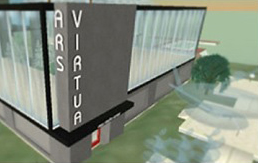
Alana Perlin
Ars Virtua is pleased to announce the appointment of our second artist in residence (AVAIR). Alana Perlin has been selected to work on a project tentatively called Interactive Interiors. Over the coming weeks we will have a reception to welcome Alana and introduce her to the AV community.
AVAIR is an extended performance that examines what it is to be a resident in a place that has no location. The residency is 11 weeks long and will culminate in an exhibit in this new medium. Brad Kligerman's residency is documented here.
“AVAIR” is a 2006-07 commission of New Radio and Performing Arts, Inc., (aka Ether-Ore) for its Turbulence web site. It was made possible with funding from the Jerome Foundation.
Posted by jo at 01:42 PM | Comments (0)
June 04, 2007
The Bush Soul + Emergence
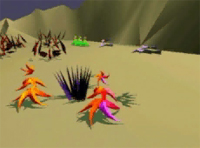
Embodying our Avatars
"We are told that in the not so distant future we will spend hours immersed in three dimensional virtual worlds. These worlds will include "avatars", virtual representations of ourselves in the form of computer generated characters. Our soul, our consciousness, will somehow be embodied in an avatar. The avatar becomes our other body, another container for our spirit.
What is the relationship one has with his or her avatar? Do we control it like a puppet, or is an avatar like a child, containing the spirit of its parents but with its own set of behaviors? What part of "us" is in our avatar? Is part of our soul in this computer generated character?
The psychologist C.A. Meier, equates the soul to our most intimate identity, our conscious ego (Meier 1986). When writing about the localization of consciousness Meier refers to the observations of Mary Kingsley, an ethnologist who lived with West African tribes in the 1890's.
Kingsley stated that the West Africans believe that a person has more than one soul and that there is a certain type of soul, called the "bush soul", that dwells within a wild animal of the bush. A person's bush soul lives inside an animal though that animal also has a life of its own (Kingsley 1899).
An avatar could serve as a place for the bush soul; following the guidance of the person attached to it, but "alive" with is own set of behaviors. I am leading a research project that is exploring the role of the avatar and other issues of aesthetics in cyberspace design. We are building a PC-based system, called "Emergence", that will support an active, responsive, networked, virtual world.
Environments and their inhabitants are rendered in real-time as three dimensional, texture-mapped polygons. The users (called "participants") are represented as avatar models. The virtual inhabitants' unique behavior emerge from a set of parameters. In the case of the avatar, its behavior is combined with input from the participant.
We are experimenting with forms of communication that rely on symbolic gestures, movements and behaviors. Our focus is on motion, the "life" of the environment, and the role of artificial life in the creation of an art form which includes the interactive experience.
Many cultures believe that everything has some form of a soul. We carry this idea into our virtual world where every object is instilled with some form of artificial life. Driven by its internal code or in response to its environment, an object may change its shape and color, make a sound or begin to move.
In our virtual world relationships can be formed between all elements. Movement and interaction enhance the emergence of a rich environment populated by engaging inhabitants. An intriguing place for a traveling bush soul." -- Rebecca Allen
Emergence is a PC-based software system, designed for the creation of interactive art. In this system, three dimensional, computer generated environments and autonomous, animated characters are displayed in real-time. People who enter this world are represented as "avatars".
Through a scripting language one can utilize techniques of Artificial Life to specify behaviors and relationships between characters and objects. This system allows for the creation of muliparticipant virtual worlds that are "alive", responsive and interactive. Complex social environments can evolve from the interaction of simple behaviors.
Additional animation and sounds such as voice, music or ambient effects can be attached to objects and characters in the environment. Activities and events emerge, including performances and non-linear stories and music, depending on the relationships and interactions between the avatar and the artificial life forms.
With this system, we are experimenting with forms of communication that rely on symbolic gestures, movements and behaviors. The focus is on the "life" of the virtual environment. Through the avatar a person enters a world that encourages exploration, participation and the development of relationships.
"Emergence" provides the opportunity to explore the role of artificial life and human presence in the creation of an art form which includes the interactive experience.
Posted by jo at 11:06 AM | Comments (0)
May 29, 2007
For any reason or no reason
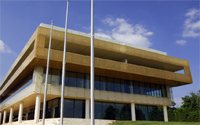
on virtual (extra-)territoriality
"Second Life is an exciting development of the virtual world. A country that wishes to show that it at least has the ambition to be at the forefront of development of course has to be in it." [1] Swedish minister of foreign affairs, Carl Bildt
The 30th of May, Sweden will be the first country in the world to open an official Embassy within Second Life, the online 3D multi user environment owned by Linden Lab. The project is initiated by the Swedish Institute [2] (a culture and marketing department of the Swedish ministry of foreign affairs, and according to the official blog even Sweden's "road warrior for peace" the minister of foreign affairs as well as former head of state, Carl Bildt, himself will attend the opening [3]. But what happens when a specific mode of representation is transferred to a new context? In this case a building for bilateral governmental representation is transferred to a private corporation.
I'll use the Embassy in Second Life as a case study of mediation between global web-based corporations and the notion of participation in a time where privatized service platforms are becoming a standard that most people (in this case even states!) uncritically are subscribing to.
My starting point will be an examination of the embassy and its representation, from an architectural perspective in relation to the Swedish Government's Politics of Architecture on state representation as well as from the point of view of the conflict between conventions of diplomatic missions and the terms of use regulating the virtual world.
P o l i t i c s o n r e p r e s e n t a t i o n
According to the Vienna Conventions on Diplomatic Missions from 1961 embassies are established on mutual consent [4]. The function of an embassy is to represent one state in another state by negotiation between governments and protecting the interests of the sending state and its inhabitants within the receiving state [5]. This is achieved through reporting on the conditions and the development of the receiving State to the sending State and by creating friendly relations and developing the two States economic, cultural and scientific relations [6].
In 1998 the Swedish government adopted a new policy on architecture politics [7]. The Proposition was the first initiative to establish a politics of architecture with an integrated plan and law on architecture, crafts and design. The changes touched on a variety of levels from the establishment of infrastructure, to city planning and individual buildings.Basically this meant the addition of strings such as 'aesthetically shaped' and 'should be aimed' into the existing laws [8]. One chapter, though concerned the representation of the public sphere and the state, "Public Sphere as Exemplary - the State as Exemplary" [9], focusing on the importance of confirming the role of the State through its representation. This also concerned embassies, which are representations of the State in other States. The new architecture politics added a new aspect to the embassy. It was not enough to be an institution with the main function to represent the State, now the institution itself (including its own representation) had to be representative of the State - the representation of the representation became representative. In this way a Swedish Embassy would have to architecturally express what Sweden stands for [10]- or at least what Sweden would like itself to stand for.
A H o u s e o f S w e d e n
The virtual embassy in Second Life will be a copy [11] of a real world embassy: The House of Sweden, situated in central Washington DC next to a big park and a river. The embassy was developed as a consequence of the new politics on architecture. A competition was announced by the Swedish National Property Board (SVF) in 2002 and the winning proposal, designed by Gert Wingårdh and Thomas Hansen opened 2006 [12].
House of Sweden is a concept developed in collaboration between the Swedish National Property Board and the Swedish Ministry of Foreign Affairs [13]. The house is a conglomerate that besides the actual embassy consists of corporate apartments for the business industry and an event center with conference rooms and exhibition space.
The building stands as a postmodern paraphrase of Scandinavian modernism. It is a wooden glasshouse. Its facades consist of backlit opaque glass with printed patterns of pressed wood and the interior a romantic/nostalgic choice of materials associated with Swedish nature and traditional Swedish craft like wood, granite and water [14]. The reception desk is made of glass and a massive wooden door is opened whenever the embassy is open for visitors [15]. Also it is possible for 'anyone' [16] to rent the exhibition center and the conference rooms of the house for events. As House of Sweden describes themselves in a pamphlet with information about the building: "Some have said that this type of open embassy is what the Americans themselves should build, but cannot. [...] modern American embassies are instead usually large, closed-off buildings located a safe distance from everything else. Despite its openness, the House of Sweden has the same level of security as other Swedish embassies, neither lower nor higher." [17] - Open and relaxed, though under control. This is the House of Sweden, the building as well as the concept marks itself in opposition to the traditional embassy with openness, relaxation space and an interweaving of the arts and the business world. Although it is obvious the art is but a layer of the design branding the concept of Sweden and the business environment. As a matter of fact even the diplomatic mission itself seems to be there, in order to brand the corporate apartments which take up most of the space in the whole building [18], with apartments at the size of 70-250 m2 and a rent of 40-60 USD/m2. The renters include Volvo group, Saab and Lars Thunell, the vice president of World Bank [19]. A Swedish embassy's original function was to take care of governmental negotiations, official representation and the protection of Swedish people and their interests within the USA. House of Sweden mirrors a shift in the role of diplomatic missions, where the new embassy is rather an official high end 'tourist bureau'. It serves the function of an exclusive promotion platform - a show room for the darlings of the Swedish business industry.
A S e c o n d H o u s e o f S w e d e n
The original embassy is designed for the human scale in relation to the use of the building, the surroundings, the economical framework and the politics of cultural representation. The final layout of the floor plans and the materiality of the house reflect these conditions [20]: office spaces are situated along glass facades in order for people to enjoy the view of the park and the river, interior stairs are covered with sound absorbent maple [21], elevators are integrated for disabled people and things to move unhindered between the floors, and the exhibition space is especially designed so that big vehicles are able to enter when setting up a new exhibition [22]. In this way the entire building may be seen as a narrative product of human scale and experience interweaved with the above mentioned factors.
By shifting the medium or context from the real world to a 3d simulated environment presented on a computer screen the elements are changing. Even though the user is represented by a (if she wishes humanlike) figure - the avatar, any navigation within the environment is reduced to the four arrow-keys on the computer's keyboard and the world is experienced through the screen with the image of one's avatar's neck in the foreground [23]. One perceives the environment in layers of resolution according to the graphic card and the capacity of the processor of the computer that is being used. Patterns of movements are radically different. The avatar itself doesn't get exhausted, it is rather like a goal-less torpedo in constant pace as long as the arrow-key is pressed down, it is only when the user behind the screen gets tired that it stops and 'falls a sleep'. This makes the planning of experience within the virtual embassy rather different than from its real-world model. In the real House of Sweden, breaks and pauses are implemented in the house according to the function. An example is the sculpture of running water greeting you as you exit the conference space [24], placed there in order to somehow refresh your mind. In Second Life it is not the avatar who would be tired or need a break after a long seminar, but rather the user behind the screen and keyboard. An equivalent break could therefore be an interruption, letting the screen go black and thereby forcing the user to shift perspective from second to first life.
Compared to traditional closed off and mono functional embassies the "real" Swedish embassy in Washington DC surprises at a first glance by its openness allowing new activities to unfold within the house and by being a glass house [25]. The glass house has a strong tradition in modernism. It is an almost supposedly invisible trespass between the outside and the inside. On the one hand it is a monument of building technology's victory over nature's forces and modernism's reaction against Victorian style, but on the other hand it is also implementing an openness that paradoxically signifies control and surveillance. The glass house offers the insider visual access and to a certain degree the illusion of being part of the outside while at the same time being protected from it. It gives the outsider visual access to the inside, stating: "there is nothing to hide here". Using the representation of glass in a virtual world though, is merely pointless. In a virtual world there is no difference between interior and exterior. One needs no protection from any weather situation or nature forces and intrusion is not about closing the access by building a wall or a window, but rather to alter and implement the security into the code behind the representation. As a matter of fact this is very easy in Second Life: Different security options are incorporated into the 'land'. The land owner is able to decide which level of security is active on her property,for instance making it possible for the avatars to 'die', denying other users to build or move objects on the property, or denying any access to the property without permission. So if the owner i.e. wishes to give other users only visual access to at part of her property she doesn't need to build any transparent simulation of glass, but can implement this in the code. A glass building in a 3d world is rather clumsy and annoying: when trying to navigate through it and accessing visible things, you constantly bump into the transparent walls.
One aspect of the original House of Sweden which might have a chance to be more successful in a 3D online environment is concept of making the embassy a platform for different events and activities. This might be a case where the virtual world has an advantage since it overcomes the difference of time-space in information technology by allowing users who are spatially separated to experience the same environment together in real-time. In Second Life most places give an impression of being empty, but by establishing in-world events this is exactly what the Swedish institute wants to avoid [26]. It is worth noting though that the emptiness in Second Life is not only due to a lack of visitors, but rather is connected to the scale of the 3d environment and its relation to the capacity of the servers. Due to server restrictions it is only possible to be 40 people at a time on each island [27]. House of Sweden in Washington DC is 7500 m2 large. The rooftop terrace alone is built to host 200 people at a time - just for a cocktail party [28]. The diplomatic activities takes up 30% of the spatial area of the house which has 50 people are working there daily[29]. But considering the fact that only 40 people is capable of accessing the whole island at a time, all of the employees wouldn't even be able to meet in the virtual embassy. No wonder why SL feels like suburbia - it is suburbia. The low density is exactly the same problem that suburbs are struggling with. Considering the scale of the building, no matter how many events they make the embassy will always feel empty until a solution is found for increasing the capacity of the servers and thereby making it possible for more people to access it at the same time.
T h e D i p l o m a t i c B a g m a y n o t b e o p e n e d
"The premises of the mission" are, according to article 1 of the conventions of Diplomatic Missions" the buildings or parts of buildings and the land ancillary thereto, irrespective of ownership, used for the purposes of the mission including the residence of the head of the mission" [30]. The actual premises of the Swedish mission in Second Life will be a chunk of data stored on Linden Lab's servers. The servers are computers physically placed in the state of California, USA [31]. Visitors of the embassy will be able to access the premises of the Swedish mission, the data on the servers via a viewer (also called the client). This is a piece of software that the users download and install on their own computers enabling them to access data on Linden Lab's servers real time together with other users, and thereby accessing the virtual diplomatic mission and the rest of Second Life. But in order to access any aspect of Linden Lab's Second Life the user has to agree with the terms of service [32] - a virtual layer to the virtual world.
Second Life's Terms of Service consists of a 7000 words document presented to the users as a click and agree contract after having downloaded and installed the viewer and just before accessing the service for the first time. The contract is un-negotiable. If you disagree with parts of the terms you'll have to disagree with all by clicking disagree at the end of the document. This in return means that you are not allowed to enter the service at all. The code behind the world is generating the environment, setting the parameters for it and thus being the world. While the Terms of Service rather is a regulative framework defining what-could-be or what-shouldn't-be, thus governing the company in order not to be able to hold it responsible for anything that might occur within its framework and giving it absolute control of in-world decisions [33]. This is not necessarily to be understood as a police state which wants to keep the control by controlling anybody anytime. The control is rather latent 'in-case-of' control, where the company in case something unexpected happens can wash its hands saying "Oh, no! This is not our responsibility" or "This was not our intention." The Terms of Service text is dense, the document would take an average reader about 35 minutes to read [34], which makes most people skip reading and just agree in order to access the service immediately. General Director of the Swedish Institute, Olle Wästberg describes his idea of establishing the embassy in Second Life as the following: "I got myself a user account, this avatar as it is called and logged in and it seemed to be a good marked place for us. In collaboration with the ministry of foreign affairs we have now decided to open an embassy" [35]. In the process of logging in Olle Wästberg properly skipped reading the terms of service, because if he would have read them he would have been aware that agreeing with the terms of service is to violate the Vienna Conventions of Diplomatic Missions and thus making it impossible to establish any embassy whatsoever in Second Life.
There are three aspects of the Conventions for Diplomatic Missions which are violated by Second Life's Terms of Service: (i) the first regards the inviolability of the Diplomatic Mission itself, (ii) the second is the inviolability of the premises of the Mission including its property, furniture, archives and documents and (iii) the last concerns the inviolability of Diplomatic Agents.
(i) A Diplomatic Mission is inviolable [36]. It means that the receiving state is not allowed to enter the embassy without permission. The receiving state is even obliged to protect the embassy as best as it can. But in Second Life any kind of data stored on Linden Lab's servers (for instance the embassy itself, accumulated items like Linden dollars, content, scripts, objects, account history or account names) are subject to deletion or alteration at any time for any reason or even without a reason in the sole discretion of Linden Lab [37].
(ii) Premises of a Mission are "immune from search, requisition, attachment or execution" [38]. But in Second Life the user must authorize Linden Lab to disclose any kind of information the corporation finds "appropriate to investigate"[39] to "private entities, law enforcement agencies or government officials"[40] Furthermore Linden Lab has the right to follow, track and record any of the user's activities within the service [41] this includes activities taking place within the premises of the virtual embassy.
(iii) "The person of a diplomatic agent shall be inviolable. He shall not be liable to any form of arrest or detention. The receiving State shall treat him with due respect and shall take all appropriate steps to prevent any attack on his person, freedom or dignity[42]." In Second Life the user is represented by an account name. It is the name of the character that represents the user and whereas the character itself can be changed and remodeled immensely the account name is static. The account name is equivalent to the representation of a diplomatic agent, and "Linden Lab reserves the right to delete or change any Account Name for any reason or no reason." [43]
By being located within the Linden Lab Corporation the Swedish embassy in Second Life is subordinate to the terms of service conducted by Linden Lab and thus breaking with the conventions related to diplomatic missions. This is recursive since any future visitor of the embassy will be forced to do the same[44]. In this way the notion of participation in this kind of virtual world is uncritically accepted and without getting acquainted with the conditions that the users are agreeing with in order to be allowed to participate. There is no consular service provided at the embassy in Second Life, instead it will link to 'real' web-sites where you can get info about how to obtain visa etc. But why do the users need to access second life and subscribe to the terms of service in order to exit Second Life to get the information that the virtual embassy provides?!
F o r a n y r e a s o n o r n o r e a s o n ?
In order "to make sure it [edit: the virtual Swedish Embassy] exudes "Swedishness" [45] the Swedish Institute has hired the design bureau Söderberg A/S to manage the layout of the virtual copy of House of Sweden and its surroundings in Second Life. But is it really possible for a design bureau "to manage the overall look and feel of the sim (or "island")" [46] for it to signify Swedishness? According to the architecture politics the answer seems to be yes, and the initiators are obviously thinking of the look of the Swedish nature. But is Swedishness only a semiotic layer wrapping up the structures by making a realistic simulation of the Swedish landscape? Doesn't the representation go beyond the aesthetical layer and isn't it rather a matter of inscription into context? Let me give an example: In the official announcement the Swedish Institute is motivating the set-up of the virtual embassy by the following:"Reaching out internationally, to an increasingly selective crowd, calls for an inventive and progressive way of working with communication. It is of great importance that we find our target groups where they are most likely to be open to our information, in their own context." [47] But it is certainly difficult to imagine the Swedish government approving any kind of set-up of an embassy within a real world private corporation - a Disney-like amusement park, no matter how well any designers would have managed to give it an overall look and feel of "Swedishness", or no matter how good a market any Disney world whatsoever would be for targeting progressive individuals where they are most likely to be open for Sweden's promotion.
It is obvious that the Swedish Institute is not familiar with the structures they are inserting the virtual embassy into. At the official announcement at their web-page the description of Second Life says: "Second Life is a 3-D virtual world and is built and owned by its residents." [48] It is an exact copy of how Linden Lab describes themselves in "What is Second Life?" [49] on their webpage. But as we have already seen Second Life is not owned by its inhabitants. It is a private space owned by the corporation Linden Lab. The users are able to create content with reserved intellectual property rights within the environment, but any content stored on Linden Labs servers (which every part of the users environment are) are according to the terms of service owned by Linden Lab and subject to deletion. The empty phrase is adopted by the Swedish Institute without reflection. The establishing of a diplomatic mission in Second Life is a continuation of the pattern that the House of Sweden already is a part of - an embassy as a show case for the Swedish brand, the nation state in competition with global corporations. So far Second Life has been the arena of big global corporations as MTV, NIKE, Reuters, but now the state is trying to compete with the corporations as if it itself was a corporation - a brand. From August 2006 to January 2007 the media coverage related to Second Life had increased by "nearly 150%" [50] and when the Swedish Institute in the end of January announced their intentions of opening the virtual embassy they immediately got worldwide media coverage everywhere, from BBC News to India news [51]. But the Swedish Embassy in Second Life is a media stunt with very little critical reflection behind it. Eventually the Swedish Institute is surfing waves of a media attention, which finally most of all is branding Second Life itself.
A kind of excuse for this argument is be found on the blog of Second House of Sweden where Stefan Greens writes: "Ironically, once concern we had was that the decision to go ahead with the project amid the hype might make it look like we were taken in by the hype, when in fact we were going in despite the hype, because we felt we really wanted to figure out now how to use virtual worlds as a place to tell people about Sweden." [52] Virtual worlds have been around for more than 15 years. Already 7 years ago the environment Online Traveler had sound [53], an aspect which Linden Lab is just now trying to develop. If the Swedish Institute was interested in using virtual worlds and had decided to take a political stand point with an awareness of the user's position within these worlds, a non-profit open source version as for instance Croquet [54] would have been an obvious choice. Of course there would not be so many users or so much hype around it, but maybe Sweden could have started a discussion related to the public sphere of information technology. However there is no reason for establishing embassies in an open source network.
A b r i d g e d s o f a r
Second Life is a centralized structure. It is a closed network of servers all under the domain of Linden Lab, much like a state. Second Life and Sweden are separated entities. The usual way for a state to establish relations with another state is for the sending state to create a representation of itself within the otherness of the receiving state - the embassy. But in an open source structure where the servers are connected in a distributed network it would not be necessary for Sweden to enter this otherness and establish a representation there, rather it could create its own server, with its own set of rules interlinked with the other servers - much as a country, but not as an embassy.
Now is a time where standards are introduced, people are inhabiting the net. This should be done not by establishing embassies, but through critical discussion and reflection on and understanding of the public sphere which is possible within the information structures. A sphere which is being hi-jacked by private corporations without anybody noticing. The Sweden which eventually will be represented in Second Life is a state where all critical reflection is put aside on the behalf of elevating Sweden's profile - and no matter how well designed it might be, it is but a brand lacking any content - - since the representation is not representing any thing but the representation itself.
Linda Hilfling - MA Media Design Student Piet Zwart Institute , Rotterdam, May 2007
R e f e r e n c e s:
[1] From Carl Bildt's personal blog from the 30th of January 2007. The blog entry was Bildt's response after for the first time acquiring the news about the Swedish embassy in Second Life via a BBC-news article. The entry is called 'Heja Olle Wästberg" and is aimed at the director of the Swedish institute Olle Wästberg: http://carlbildt.wordpress.com/2007/01/30/heja-olle-wastberg/ [my translation from Swedish]
[2] Official announcement by the Swedish Institute, Jan 2007:
http://www.si.se/templates/CommonPage____3052.aspx
[3]
http://secondhouseofsweden.com/2007/05/20/may-30-is-launch-day-for-the-second-house-of-sweden/
[4] Article 2, Vienna Conventions on Diplomatic Missions, 1961: http://untreaty.un.org/ilc/texts/instruments/english/conventions/9_1_1961.pdf
[5] Article 3.1a; 3.1b; 3.1c - Vienna Conventions on Diplomatic Missions,
1961: http://untreaty.un.org/ilc/texts/instruments/english/conventions/9_1_1961.pdf
[6] Article 3.1d; 3.1e, Vienna Conventions on Diplomatic Missions, 1961: http://untreaty.un.org/ilc/texts/instruments/english/conventions/9_1_1961.pdf
[7] Handlingsprogram för arkitektur, formgivning och design: http://www.regeringen.se/content/1/c4/25/65/e36cce6d.pdf
[8] Suggestions to alterations of existing laws Framtidsformer - Handlingsprogram för arkitektur, formgivning och design, pp 5-9 http://www.regeringen.se/content/1/c4/25/65/e36cce6d.pdf
[9] "Offentligt som förebild - Staten som förebild" Framtidsformer - Handlingsprogram för arkitektur, formgivning och design, pp 25-3 - http://www.regeringen.se/content/1/c4/25/65/e36cce6d.pdf
[10] "New expectations for future embassies" - Background material - House of Sweden, page 2 http://www.sfv.se/cms/showdocument/documents/sfv/engelska/house_of_sweden/background_material_the_building_the_artwork_etc_.pdf
[11] Official announcement by the Swedish Institute: http://www.si.se/templates/CommonPage____3052.aspx
[12] "The architecture competition" - Background material - House of Sweden, p 3 http://www.sfv.se/cms/showdocument/documents/sfv/engelska/house_of_sweden/background_material_the_building_the_artwork_etc_.pdf
[13] "A new concept is born" - Background material - House of Sweden, p 2 http://www.sfv.se/cms/showdocument/documents/sfv/engelska/house_of_sweden/background_material_the_building_the_artwork_etc_.pdf
[14] See photo of facades: http://www.sfv.se/cms/showimage/images/aktuella_projekt/washington_dc/foton_30_maj_06/hos_fasad_mot_flaggstanger_och_grasmatta_.jpeg?mime-type=image/jpeg - more photos from interior to be found at:
http://www.wingardhs.se/php/flash.html | under projects - 2006
[15] "The various parts of the building - a tour" - Background material - House of Sweden, p 4 http://www.sfv.se/cms/showdocument/documents/sfv/engelska/house_of_sweden/background_material_the_building_the_artwork_etc_.pdf
[16]
[17] "The various parts of the building - a tour" - Background material - House of Sweden, p 6 http://www.sfv.se/cms/showdocument/documents/sfv/engelska/house_of_sweden/background_material_the_building_the_artwork_etc_.pdf
[18] All together the house consists of five floors of which 1½ floors belongs to the embassy, 1½ floor belong to the event center and 2 floors makes space for 19 corporate apartments. This means that 70% of the building is reserved for activities related to business and events, and only 30% of the space of the whole house is related to traditional diplomatic activities.
[19] "The various parts of the building - a tour" - Background material - House of Sweden, p 6 http://www.sfv.se/cms/showdocument/documents/sfv/engelska/house_of_sweden/background_material_the_building_the_artwork_etc_.pdf
[20] Floor plans: http://www.sfv.se/cms/showdocument/documents/sfv/aktuella_projekt/washington_dc/infor_overlamnandet_till_ud/hos_wdc_8_ritningar_maj_06.pdf
[21] "The various parts of the building - a tour" - Background material - House of Sweden, p 5 http://www.sfv.se/cms/showdocument/documents/sfv/engelska/house_of_sweden/background_material_the_building_the_artwork_etc_.pdf
[22] "The various parts of the building - a tour" - Background material - House of Sweden, p 4 http://www.sfv.se/cms/showdocument/documents/sfv/engelska/house_of_sweden/background_material_the_building_the_artwork_etc_.pdf
[23] If not 'mouse look' is enabled, which is an alternative navigation mode where the mouse is used for all navigation and the user have first perspective view, but this mode is rather difficult to control with a mouse and is probably better suited for a joystick.
[24] "The various parts of the building - a tour" - Background material - House of Sweden, p 5 http://www.sfv.se/cms/showdocument/documents/sfv/engelska/house_of_sweden/background_material_the_building_the_artwork_etc_.pdf
[25] Compare for instance with the photos of different American embassies published at Wikipedia: http://en.wikipedia.org/wiki/American_diplomatic_missions
[26] Stefan Geens at:
http://secondhouseofsweden.com/2007/04/04/division-of-labor/
[27] Alvar C.H Freude: "Warum Second Life kein Web 3.0 ist" p.24 - a power point presentation
http://alvar.a-blast.org/vortraege/webmontag/second-life/second-life-vortrag.pdf
[28] "The various parts of the building - a tour" - Background material - House of Sweden, p 7 http://www.sfv.se/cms/showdocument/documents/sfv/engelska/house_of_sweden/background_material_the_building_the_artwork_etc_.pdf
[29] "The various parts of the building - a tour" - Background material - House of Sweden, p 5 http://www.sfv.se/cms/showdocument/documents/sfv/engelska/house_of_sweden/background_material_the_building_the_artwork_etc_.pdf
[30]Article 1, Vienna Conventions on Diplomatic Missions, 1961: http://untreaty.un.org/ilc/texts/instruments/english/conventions/9_1_1961.pdf
[31] General Provisions - Terms of Service: http://secondlife.com/corporate/tos.php
[32] First paragraph - Terms of Service: http://secondlife.com/corporate/tos.php
[33] The string "no liability" appears 3 times, "any reason or no reason" appears six times and "sole discretion" appearing 17 times in the Terms of Service.
[34] According to http://mindbluff.com/askread.htm#5
[35] Olle Wästberg as quoted by in Alexandra Hernadi in Svenska dagbladet - http://www.svd.se/dynamiskt/inrikes/did_14523659.asp [my translation from Swedish]
[36] Article 22.1 and 22.2 - Vienna Conventions on Diplomatic Missions, 1961: http://untreaty.un.org/ilc/texts/instruments/english/conventions/9_1_1961.pdf
[37] 5.3 Terms of Service. See also similar statements in 1.4; 1.6; 2.6 and
3.2b: http://secondlife.com/corporate/tos.php
[38] Article 22.3 and 24 - Vienna Conventions on Diplomatic Missions, 1961: http://untreaty.un.org/ilc/texts/instruments/english/conventions/9_1_1961.pdf
[39] 6.1 Terms of Service: http://secondlife.com/corporate/tos.php
[40] 6.1 Terms of Service: http://secondlife.com/corporate/tos.php
[41] 6.2 Terms of Service: http://secondlife.com/corporate/tos.php
[42] Article 29 (see also 30.2) - Vienna Conventions on Diplomatic Missions, 1961: http://untreaty.un.org/ilc/texts/instruments/english/conventions/9_1_1961.pdf
[43] 2.3 Terms of Service: http://secondlife.com/corporate/tos.php
[44] Second Life's Terms of Use, first paragraph: http://secondlife.com/corporate/tos.php as of 29th of April 2007 [45] Stefan Geens at http://secondhouseofsweden.com/faqs/
[46] Stefan Geens at http://secondhouseofsweden.com/faqs/
[47] Olle Wästberg quoted at the webpage of the Swedish Institute - http://www.si.se/templates/CommonPage____3052.aspx
[48] http://www.si.se/templates/CommonPage____3052.aspx
[49] http://secondlife.com/whatis/
[50] Factiva: Percentage increase comparisons of media coverage about Second Life between months of August 2006 and January 2007 as quoted by Joel Cere: http://blogs.hillandknowlton.com/blogs/ampersand/articles/7359.aspx#footnote1
[51] BBC: http://news.bbc.co.uk/2/hi/europe/6310915.stm ; India News: http://www.indiaenews.com/europe/20070130/37547.htm
[52] Stefan Geens at: http://secondhouseofsweden.com/2007/03/20/more-faqs-were-in-it-for-the-long-haul/
[53] We used Online Traveler in 2000 as a platform for online access to the electrohype2000 conference in Malmö, Sweden: http://www.electrohype.org/electrohype2000/rapport/rapport.pdf
[54] In croquet both server and client are open source in opposition to Second Life which only has opened the source code to the client - the viewer, but not to the servers: http://www.opencroquet.org/index.php/Main_Page
p d f - f o r m a t:
- ------------------------- http://pzwart2.wdka.hro.nl/~lhilfling/documentation/for_any_reason_or_no_reason_hilfling.pdf
Posted by jo at 12:47 PM | Comments (0)
May 22, 2007
Synthetic Performances
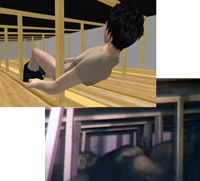
Second Life Re-enactments
While virtual environments like Second Life offer artists a new platform for the creation of original works, it's always interesting to see the past being reinterpreted. I'm pretty sure it was Marshall McLuhan who said all new media consumes its predecessor's content before settling on a new form, and we have witnessed his observations unfolding with the Radio > Television > YouTube evolution.
Eva and Franco Mattes (of 0100101110101101 fame) have taken this ethos of appropriation to heart in their ongoing Synthetic Performances. Seminal performance works from the 1960’s–80’s have been re-staged in Second Life and exhibited in-world and on their web site. Re-performances to date include Joseph Beuys' 7000 Oaks, Valie Export's Tapp und Tastkino, Vito Acconci's Seedbed (he was a bad boy) and Chris Burden's Shoot.
More images after the jump, or you can skip right to their site. If you have an SL account, click here to visit the 7000 Oaks performance in Second Life. More images >> [Posted by christo on selectparks]
Posted by jo at 05:28 PM | Comments (0)
May 19, 2007
404 FESTIVAL - ON TOUR / EUROPE 2007
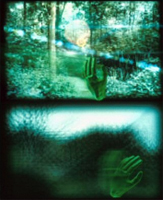
Einstein's Brain Project
[left: Alan Dunning, Paul Woodrow, The Einstein's Brain Project: The Errant Eye, 1997-2001. Virtual reality installation. The participant navigates around a recognizable visual environment, a forest whose outline faded into an abstract visual universe reflecting the variations in biological signals processed in real time by a computer module.]
Astas Romas & 404 Festival decided to launch a European Tour that begins on May 31, 2007. Directors and team of the "404 Festival" will be visiting cultural centers, public and alternative places performing live concerts, projections and conferences, also presenting "404 selected" artworks from international authors. Artists from different countries will join this tour, such as SadMb (Japan), Synchdub (Belgium), Sample Mousse (Finland), Guillermo Giampietro & Lara Baracetti (Italy), Einstein's Brain Project (Canada), Vladimir Manovski and Aleksandar Secerov (Serbia), Miha Ciglar (Slovenia), among others.
"...The cycle of installations in The Einstein's Brain Project (1995-2001) is a major technological detour for Dunning that, nonetheless, re-examines his past conceptual concerns. In this long-term project begun in 1995 with Paul Woodrow and a team of scientists from different fields, Dunning probes the new epistemological models that have developed thanks to technological advances in virtual reality.
The artificial worlds summoned up by the immersive universes often rekindle the presuppositions of a naturalistic project whose aim is to simulate familiar experiences. The interfaces created by Dunning and Woodrow propose a critical counterbalance to the withdrawal to the Cartesian universe. In the wake of recent research in cognitive science, the two men are interested in how biological and brain processes shape our perception of the world.
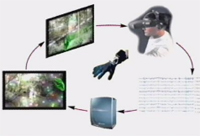
[Left: Diagram showing the way biological data gathered in real time on the participant's body is altering the display parameters of a three-dimensional virtual universe.] An initial series of installations completed between 1997 and 2001 explored popular culture's fascination with the human brain. Evidence of this fascination is found in Roland Barthes's essay on the fetishism of Einstein's brain, a reflection that serves as a critical point of reference for the installations in this body of work. By reactivating obsolete systems of representation (phrenology, eugenics, etc.), this series also underlines the impact of pseudo-scientific projections on our knowledge of the body and psyche.
In The Fall, The Furnace, The Flesh (1997), (7) participants underwent a sort of ritual as they crossed through a curtain made up of thin vinyl strips. These strips served as a screen for projecting an image of a blazing fire. Participants found themselves in a cubic space defined by four screens. In the middle of the space was an anatomically correct model of the human head covered with touch-sensitive pads (audio-digital). The location of the 55 pads replicated the brain map developed by the phrenologists Franz Joseph Gall and Johann Spurzheim. In the Victorian age, studying the skull's contours over these zones supposedly revealed a person's character traits and psychological predispositions. Dunning recycled the paradigm of phrenology as a means of accessing the installation's touch-sensitive interface. As participants pressed the pads, a series of video segments were projected on the wall. These segments, which came from various sources, showed irreconcilable objects and events that evoked the series of random associations produced by the brain as it assembles fragments of stored memory. Here, the unconscious content could not easily be distinguished from fragments of images from the media sphere. Images appeared erratically: a lunar eclipse, close-ups of the body, a political demonstration, a hall in a museum, a text flashing at a dizzying speed, barely perceptible abstract images. With the combination of images almost infinite, the screen constantly offered new sequences of juxtaposed images.
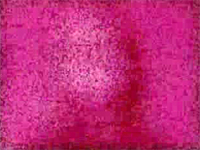
[Left: Alan Dunning, Paul Woodrow, The Einstein's Brain Project: The Furnace, 1997-1999. Video and sound installation with interactive components. Segments, from various sources, showing irreconcilable objects and events evoking the series of random associations produced by the brain as it assembles fragments of stored memory. Excerpt of the video documentary The Einstein's Brain Project, The Errant Eye, The Furnace, 1998-1999. Go here and click on the first segment under "Multimedia."]
The virtual environment installations The Errant Eye (1997-2001) and The Madhouse (2001) delved into Dunning and Woodrow's premise that the image captured on the retina doesn't always converge with brain activity. In The Errant Eye, the biological data gathered in real time on the participant's body altered the display parameters of a three-dimensional virtual universe. The participant donned a head-mounted display equipped with encephalogram electrodes that recorded the changing amplitude of brainwaves from the brain's right and left sides. The participant then navigated around a recognizable visual environment, a forest whose outline faded into an abstract visual universe reflecting the variations in biological signals processed in real time by a computer module. Once the feedback process reached the balance sought, the participant could recognize recurring motifs that corresponded to certain types of reactions and perceptions.
The Madhouse (2001), which was presented at the gallery Oboro (Montreal, Canada) in 2001, allowed participants to pool their individual perceptions as they experimented simultaneously with feedback. A luminous life-size cast of the human body lay in the centre of a room and was surrounded by participants in an immersive state. The participants touched the surface of the body, which stored and displayed their handprints and fingerprints as if which stored and displayed their handprints and fingerprints as if the body's material presence were providing them with a kind of anchorage in the physical world. Behind their displays, the participants were catapulted into a virtual world, while viewers on the periphery could observe their erratic gestures, which resembled the spasms of mental patients (hence the work's title). Through this sharing of the immersive experience, which is often deemed autarchic, Dunning and Woodrow's project created a more complex model of a virtual community that didn't exclude the body of the participants.
A series of installations in development will further explore technological and conceptual aspects begun within The Einstein's Brain Project. Under the working title (WIW), Worlds in Worlds, Dunning plans to put together an immersive environment whose boundaries will be defined by the real dimensions of the room the participant is in. Dunning is also interested in the Anatomically Lifelike Biological Interface, which operates via a model reproducing certain bio-anatomical functions. In this vein, he is pursing research on the properties of ferrofluids, liquid matter that can be altered by an electromagnetic field and modified by biological signals from the human body.
V.B. © 2002 Fondation Daniel Langlois
Posted by jo at 01:37 PM | Comments (0)
April 27, 2007
Second Front - Spawn of the Surreal (Live at NMConnect)
Posted by jo at 05:49 PM | Comments (0)
April 20, 2007
Brad Kligerman Ars Virtua Artist-in-Residence (AVAIR)
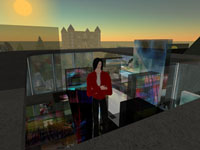
Determining Image-Space
Brad Kligerman Ars Virtua Artist-in-Residence (AVAIR) « Organizing light in the time and space of the projected image » (the determination of an Image-Space) :: Opening TONIGHT April 20 (23:59 SLT) & April 21 (12:00 SLT - noon) :: Go Here >>
Artist and Architect Brad Kligerman has turned the idea of art making upside down or rather inside out in his AVAIR exhibit. Kligerman questions the idea of materiality in the rendered environment and the nature of image. He successfully blends the idea of moving through "space" with the idea of moving through image in his new multi-sim installations.
Over the course of Kligerman's eleven week residency he has collected images from various experiments in SL. These images have been deftly applied to objects which form a path through three "machines." Kliger uses these machines to extract data from SL in order to understand materiality, quote the history of art and painting and contrast with what has become "traditional" Second Life architecture. The end result is a series of places where image and space become one.
"In contrast to projects that view virtual worlds as simply another node in a communication strategy, this project attempts to find another creative and productive scenario by interrogating the physical and material extents of SL."
"This project recognizes synthetic space not for its faculties of communication, but rather for its potential as a representational, sensational medium. "
"Image resonates on its surface, through its envelope and beyond its physical reach, to capture, through the distribution of space, its tangible atmosphere. Avatars merge in image, emerge through the image, we lose ourselves in the image, of art, only to reemerge through it. The colors, lights and forms, the tensions and compressions of the space's force, superpose to project an «Image-Space »."
AVAIR is an extended performance whose purpose is to investigate the nature of art making in the 3D synthetic environment of Second Life. It is an examination of policy and institution, as well as a reflection on place and art. Artists are given a stipend and technical support. They are expected to have an open studio, produce an exhibition, and make a public presentation. Their methodologies are documented here. Orchestrated through the classic structure of the gallery, the performances run at any time of the day or night, and create a platform for exchange between artist and audience.
“AVAIR” is a 2006-2007 commission of New Radio and Performing Arts, Inc., (aka Ether-Ore) for its Turbulence web site. It was made possible with funding from the Jerome Foundation.
Ars Virtua is a new media center and gallery located in the synthetic world of Second Life. It is a new type of space that leverages the tension between 3-D rendered game space and terrestrial reality, between simulated and simulation. Ars Virtua is sponsored by the CADRE Laboratory for New Media.
Posted by jo at 10:19 AM | Comments (0)
April 13, 2007
Henry Jenkins' Interview with
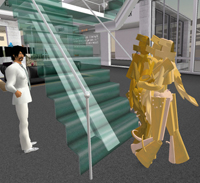
Wagner James Au
[Image, left: Wagner James Au with Marcel Duchamp's Nude Descending a Staircase.] "I have been using this blog, off and on, across the past few months, to focus attention and generate debate about Second Life as a particularly rich example of participatory culture. Those who have followed this blog over time will have read my response to Clay Shirkey's critique of Second Life, my conversation with Peter Ludlow, the editor of the Second Life Herald and the co-Author of a new book on virtual worlds, and my response to questions about the relationship between Second Life and real world politics. Today, I want to continue this consideration of Second Life with an interview with Wagner James Au, the author of a forthcoming book, New World Notes, which describes his experiences as an "embedded journalist" covering the early days of Second Life. Au had contacted me in response to some of my earlier posts on this topic and I asked if he'd be willing to share some of his thoughts to my readers." Notes from a New World: Interview with Wagner James Au (Part One) and Notes from a New World: Interview with Wagner James Au (Part Two) (For our readers in Boston, Wagner James Au will participate in "The Art of Living a Second Life" panel discussion at the Museum of Science on April 25. More information here.)
Posted by jo at 05:55 PM | Comments (0)
April 12, 2007
Gazira Babeli: Collateral Damage
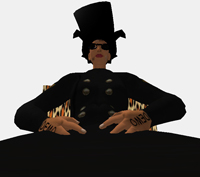
A Comprehensive Survey, 2006-07
On April 16t, 2007, 6:00 pm SLT, the ExhibitA gallery (38,30,23) on the Odyssey simulator within the online virtual world called Second Life, will present the first comprehensive look at the pioneering work of Gazira Babeli. Gazira Babeli is an artist creating works within Second Life and a member of Second Front - the first performance art group in Second Life.
Gazira labels herself a "code performer" and indeed the code is at the heart of her work, tying it to the system at a deep level and reaching out to the viewer in ways that inherent to the SL platform. Her pieces are alive with scripts created using the Linden scripting language - a core component of Second Life. A Campbells soup can that is a trap, and a self proclaimed menace disguised as pop art, encases the viewer and takes him on a ride proclaiming "you love pop art, pop art hates you" until the unsuspecting avatar manages to run fast enough to escape. The sky filled with question marks, a vengeful tornado, these are a few of Gaz's signature works that can be seen on her site. In the spirit of opensource - Gazira has licensed much of her code via creative commons, and you can download it for your own use on her site.
Gazira Babeli: Collateral Damage - a comprehensive survey of works from 2006-2007 :: location: Odyssey (38,30,23)
Please join us for the opening of this exhibit. Press are invited to attend at 1pm SL time. The general opening is at 6pm SL time. Inquiries may be directed to Beavis Palowakski: rushchris[at]mac.com, or to Sugar Seville: sugarseville[at]gmail.com.
Posted by jo at 08:52 AM | Comments (0)
April 07, 2007
Turbulence Commission:
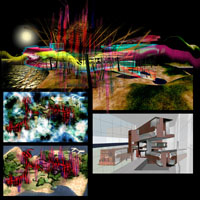
AVAIR: Brad Kligerman
Ars Virtua Artist-in-Residence (AVAIR)--a project of James Morgan, Amy Wilson and Jay van Buren--is an extended performance whose purpose is to investigate the nature of art making in the 3D synthetic environment of Second Life. It is an examination of policy and institution, as well as a reflection on place and art. Artists are given a stipend and technical support. They are expected to have an open studio, produce an exhibition, and make a public presentation. Their methodologies are documented here. Orchestrated through the classic structure of the gallery, the performances run at any time of the day or night, and create a platform for exchange between artist and audience.
Brad Kligerman, Ars Virtua's first AIR, is winding down his 11 week tenure. He is fabricating three machines capable of extracting in-world data pertinent to discovering the rules of materiality inherent to Second Life: (1) the Calibration Machine for reading the world; (2) the Analogy Machine for learning about it; and, (3) the Mutation Machine for writing, inventing and transforming it. His exhibition will consist of interactive hyper-spaces made of images, ideograms and holograms. Join us for the opening on April 20 at midnight (SLT), and April 21 at noon (SLT). If you do not have an avatar, go to Second Life and register for a free account; download the client and launch it. Teleport to http://slurl.com/secondlife/Dowden/42/60/52.
"Ars Virtua Artist-in-Residence (AVAIR)" is a 2007 commission of New Radio and Performing Arts, Inc., (aka Ether-Ore) for its Turbulence web site. It was made possible with funding from the Jerome Foundation.
BIOGRAPHY
Brad Kligerman is an architect, artist and teacher. Previous projects include the design of astronaut work and habitation spaces that address the body's physical and psychological adaptation to the temporal and spatial environment of low orbit space for the NASA space station, Grumann Corp; and the design of large scale architectural projects, for instance The Bibliotheque de France (Dominique Perrault Architects); and 544 Park Avenue (SOM). Kligerman also produces gallery installations and multi-media projects.
Posted by jo at 02:07 PM | Comments (0)
March 30, 2007
The Schism Around Voice:
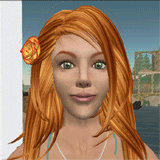
Multicasting vs. Broadcasting
"Imagine that you would have an awesome technology that allowed you to create an universe you have just pictured in your mind, to the extent of detail you wish, and that you could get realistic characters walking around your universe, so perfect in its minutiae that their behaviour and looks would be completely impossible to distinguish from real human beings. Now imagine if that technology were available to everybody in the world and that anyone, anywhere could have access to it.
Actually, that technology does, indeed, exist. It’s even quite old, having first been developed over 6,000 years ago. It’s called a book.
Nevertheless, a “book” is not perfect — there is an author, and there is an audience. The author can do with their book whatever it wishes; but you, the reader, cannot. All you can do is read and imagine with the author, but not contribute to the book.
Enter the Internet, and its many social environments: from the old bulletin boards, through FidoNet, later the USENET, finally to IRC, and to webchats, we come to things like, well, Second Life. Here a new paradigm has emerged: the notion of a collaborative environment, where readers and authors alternate roles, and both contribute, at the same time, to a collective work. Early analysts of the “Internet revolution” have touted this as the primal change in the way we think about the ancient roles of author-editor-publisher-audience; the old “broadcasting” paradigm (one sender, many receivers) has been replaced, on the Web, by a new model: multicasting (all are senders and receivers) and the notion of collaborative environments, where all are readers and authors at the same time." Continue reading The Schism Around Voice: Multicasting vs. Broadcasting by Gwyneth Llewelyn.
Posted by jo at 05:58 PM | Comments (0)
March 25, 2007
NOEMA
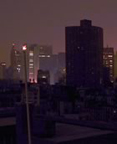
Ideas + Survey
Generic Infrastructures [2] by Rob van Kranenburg: Today we are in the worst situation imaginable. Our global and undisputed computing paradigm posits that computing processes are successful only in as much as they disappear from view. Our design focus is ever more following Philips untenable but seductive ‘sense and simplicity’ resulting in the-bug-as-a-feature-design of the Ipod Shuffle. Our educational system is following this systemic hide-complexity strategy that favors the large industrial labs, IT conglomerates and above all their clinging to notions of IP and the patent that are firmy tied to their notions of doing business and making money. And our users, us? We are YOU, the most influential person of the year 2006, according to TIME Magazine. You fill the Wikipedia entries in your spare time, you blog your daily activities, you co-bookmark on de.l.i.c.i.o.u.s, upload your photos to flickr, you buy mating gear in Second Life, and mark your position on Plazer or Google Earth. You fill out the forms. Isn’t it time you start questioning the principles behind the formats? And, to make matters even worse, your naïve ideas of sharing are corrupting notions of privacy, transparency and informational architecture symmetry.

Ludium II - Synthetic Worlds and Public Policy by Edward Castronova: Synthetic worlds – million-player online environments with genuine markets, societies, and cultures – are exploding in size and significance. Real world governments around the globe are beginning to grapple with their implications in the areas of taxation, intellectual property laws, consumer rights, addiction, violence, and more. Should synthetic worlds be controlled by developers, or by governments, or both? What about the rights of users? What general norms should legislatures and courts follow? More NOEMA >>
Posted by jo at 01:33 PM | Comments (0)
March 23, 2007
Interview with Gazira Babeli by Tilman Baumgärtel
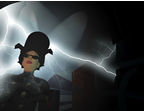
My body can walk barefoot, but my avatar needs Prada shoes
Tilman Baumgärtel: Is Gazira Babeli your real name? If not, tell us a bit about your existence outside of SL.
Gazira Babeli: Yes, it's my real name in Second Life but most of people call me Gaz'. Outside SL, my existence is not so different from yours... drinking, eating, sleeping, meeting people, looking at a computer monitor and working the least possible.
Tilman Baumgärtel: You mess around with the code in Second Life. Can you give me a non-technical description how you insert your code into the system?
Gazira Babeli: Codes are just instructions, imperative verbs. An example: PUSH-IT-FAR... a box, a Museum, a Church, an avatar-person... or an entire avatar audience. The result could be spectacular and/or create social troubles. I found it easier to call these instructions "performances" or "actions". It makes sense in SL frame-space 'cause the results look more like a sensible real space than a computer output.
Tilman Baumgärtel: Why do it at all? Isn't Second Life fun enough as an imitation of the real?
Gazira Babeli: Yes, imitation is fun, but it's only the "background color" of every possible behavior. I'm exploring that.
Tilman Baumgärtel: Why intervene into Second Life, if there is a whole world out there. What is difference between a performance in SL and in the real world?
Gazira Babeli: I would say that the term "whole world" itself is more or less virtual. There's a whole world of people working in call-centers and one hand-making shoes. There's a whole world considering itself privileged because it can have access to information and spends a great deal of its life idling on Office or on a Web Browser. We keep forgetting that what we call Real Life has been a virtual frame for a long time. Second Life offers the chance to build and deconstruct this space in the form of a theatre performance. What's the difference? I'm trying to find out. For the moment I like to say: my body can walk barefoot, but my avatar needs Prada shoes.
Tilman Baumgärtel: Are you familar of the net.art of the 1990s, and is your work influenced by the likes of Jodi et al?
Gazira Babeli: COME.TO.HEAVEN actions are inspired by Ives Klein and JODI. Weird mix, don't ask me why. I also loved Alexei Shulgin 386DX shows and some extremely conceptual stuff by Florian Cramer. RTMark net.prankster projects was really weird. It has been a very meaningful scene. For me net.art is like a wild middle-age of Internet.. Second Life seems to offer a Renaissance Perspective.
Tilman Baumgärtel: Do you create any work outside of SL? Have you shown your work in the real world and if yes how?
Gazira Babeli: This is an interesting problem. First: I cant get out of Second Life because I exist only thanks to Second Life. Two: I saved thousands of high-resolution images and videos that some people, in the physical world that u call RL, are willing to publish. An interesting solution would be the one I experienced with the PEAM festival. I simply offered the curator the digital images and a very detailed license with all the print specifications. At present Im finalizing the shooting of a movie which draws inspiration from "Simon of the Desert" by Bunuel and from the early Buster Keaton. The set is a portable desert, as big as 16 regions, and very likely the title is going to be "Gaz' of the Desert". I hope it will reach somehow physical world, because the only thing I really cant stand in SL is going to the movies. I find it very disturbing for an avatar who is already living in a film-like environment.
Tilman Baumgärtel: Did Linden labs approach you or even try to kick you out due to you actions, especially the "Grey Goo" performance? Or did the builders of the Virtua Art Center come down on you?
Gazira Babeli: During "Second Jesus", one of my first performances, I have been contacted by a Linden. I believe it only wanted to understand if my aim was to offend Christian beliefs; I did not want to offend anyone, of course. "Grey Goo" was a trivial trick, quite amazing but totally harmless. Media probably misunderstood some information, spreading the "grey goo bandits" panic. I do not believe Lindens want to interfere as "virtual cops", they have more substantial problems and aims. I think Lindens would prefer residents to solve their internal troubles instead of filing a "Report Abuse". The Artwork "DONT say" is the result of this consideration: it allows to register those words we consider abusive and when someone pronounces them is seized by a tornado and shaken up until he apologizes. The effect is very cartoon-like.. Wile E. Coyote and Road Runner. After "Singing Pizza" (the symbolically abusive installation in Ars Virtua), the director Rubaiyat Shatner wanted to talk to me, he was worried and amused. We became friends though maintaining different views on SL-Art. Most SL residents believe they can build only visible "objects", but the range of behaviours and the margins of freedom are wider than most people think.
Tilman Baumgärtel: Most of your works seem to focus on manipulation of the technology of SL rather than e.g. intervening into the social conventions. Why?
Gazira Babeli: It's strange.. some people asked me the same question reversed. From my point of view, we are talking of two elements which are complementary, not divisible. SL is a complex society and without a univocal final aim. It includes heterogeneous social forms and conventions. The social-symbolic exchange is generally based on a sort of parody of the consumer-oriented western world... in brief, gadgets on which to build up one's identity. This happens in a fairly anarchic and pacific way, thanks to a "dictatorship" of the technologic protocol, strictly defining properties and utilization concessions. Now we consider Google as a friend but even Google is a strange phantom-dictatorship on information. It this good or bad? Try to imagine internet without Google. Now, SL is a smaller environment compared to the Web, but I think it is a step ahead. My art consists in experimenting in an ironic and "pop" way the complementary and often contradictory aspects of a "whole world" which, despite being inhabited by "puppets", it hosts at least a million people. Real people.
Tilman Baumgärtel: A lot of people are put off exactly by the consumerist or capitalist leanings of SL, and - unlike you - not every body sees them as a satire, but rather as a confirmation of the status quo. Can you imagine a more utopian system (without money, without exchange value, without work...), and would you prefer it?
Gazira Babeli: We are mixing up two different issues: anthropological observation and ethical judgement. Of course Id love to login in a space called "First Utopia"! I can even imagine it but only from a technical point of view peer-to-peer protocols taught me a lot. Would I prefer it? I honestly cant answer to this question, first I should live in it a few months. Second Life, on the contrary, is an accomplished fact. If I like SL? I never said that and I dont want to say it. You talk about satire, I repeat parody. The distorted and conscious imitation of a model is something concerning theatre or literature.
If you have grandeur manias you can buy a castle and crown yourself King even if you are connected from a small flat in the suburbs; if you feel antisocial you can become a black box there are the headquarters of the French National Front and of the Anti National Front. The majority of the people I met are aware of this imitation-distortion the parody of what we call real life. ["My body can walk barefoot, but my avatar needs Prada shoes" Interview with Gazira Babeli by Tilman Baumgärtel via nettime] Related 1, 2.
Posted by jo at 01:18 PM | Comments (0)
March 21, 2007
Virtual actors take to the stage
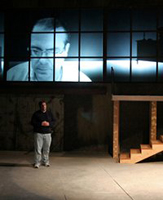
"Beamed" from Florida to Illinois
"Actors working in real time from remote locations have been beamed onto a stage where they performed with live, in-the-flesh actors, US researchers say. The broadband-enabled experience allowed the audience to watch a seamless, 3D performance, according to the University of Central Florida. The technology could mean future theatergoers might attend plays where one or more actors are working outside the venue, even in a different country, or from their own homes. "We are not talking about holograms yet or the kind of imagery that requires funky glasses," says Professor John Shafer, a member of the cast. "[But] what we have done for this production has indeed pushed the envelope significantly. The production is a small historical step forward on several levels."
Shafer was hooked to a receiving and transmitting broadband-connected computer that can pull 130 megabytes of data in an instant. Although he performed in Florida, his body was 'beamed' onto a stage at Bradley University in Illinois, where he performed 'with' live actors there, as well as with actors beamed in from the University of Waterloo in Canada. Both 3D and 2D sets consisting of multiple screens and special-effects lighting that helped to give the impression that all the actors, remote or not, existed in a single space." Continue reading Virtual actors take to the stage by Jennifer Viegas, ABC Australia News In Science. [via]
Posted by jo at 08:41 AM | Comments (0)
March 16, 2007
Giselle Beiguelman's nowhere/anywhere/somewhere
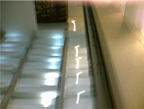
The Cinematic Experience of Space in Second Life
Yesterday, NOEMA opened its doors with Giselle Beiguelman's nowhere / anywhere / somewhere which highlights the cinematic experience of space in Second Life. The show runs until April 30, 2007. nowhere / anywhere / somewhere intensely exploits its resources of zooming, camera movements and ways of displacement in the environment. The visualization resources give / create / invent meanings for the artist's images. Fragments of daily life, captured with a mobile phone, the images in this exhibition are a permanent remix process, rendered by the avatars it interacts with.
NOEMA is the world's first nomad art gallery. Specialized in digital art, it is based on Second Life and promotes varied, different-size actions, in physical reality. NOEMA is cutting edge. It proposes a pioneering experience, connected with the boldest concepts of contemporaneity. It is cybrid, because rather than suggesting a media hybridization, Noema proposes (and performs) experiences among on and off-line networks, in concrete and virtual spaces. It is cinematic, because it is located in an immersive and interactive environment that allows new image constellations.
More than a hub of marketing and representation of artists and events, Noema is an innovative project, a creation plant that gathers from the start some of the major names in the digital art scene, such as Mark Amerika, Giselle Beiguelman, Lucas Bambozzi, Vera Bighetti, Gilbertto Prado and Rick Silva, among others.
Not just an exhibition venue, Noema is a space for the launching of films, DVDs and books, performances, lectures and workshops, acting in a partnership with audio/video streaming and e-business companies, which guarantee the quality of its actions.
Giselle Beiguelman is a new media artist and multimedia essayist who teaches Digital Culture at the Graduation Program in Communication and Semiotics of PUC-SP (São Paulo, Brazil). Her work includes the award-winnings "The Book after the Book" "egoscópio" and Landscape0 (with Marcus Bastos and Rafael Marchetti). She has been developing art projects for mobile phones ("Wop Art", 2001), praised by many media sites and the international press, including The Guardian (UK) and Neural (Italy), and art involving public-access, by the web, SMS and MMS to electronic billboards like "Leste o Leste?" and "egoscópio" (2002), released by The New York Times, "Poétrica" (2003) and "esc for escape" (2004). Beiguelman's work appears in important anthologies and guides devoted to digital arts including Yale University Library Research Guide for Mass Media and has been presented in international venues such as Net_Condition (ZKM, Germany), el final del eclipse (Fundación Telefonica, Madrid), Desk Topping - Computer Disasters (Smart Project Space, Amsterdan) Arte/Cidade (São Paulo), The 25th São Paulo Biennial and Algorithmic Revolution (ZKM).
Posted by jo at 11:48 AM | Comments (0)
March 14, 2007
Networked Proximity - Section 7:
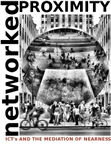
Virtuality and the Near
"[...] The fact is that the opposite of the virtual —as we will see— is not the real, but the actual. But before getting into that, we should acknowledge that setting up virtuality as a threat to reality has served an important function in critical theory. As part of a discourse on the shortfalls of modernity, virtuality has served as a powerful metaphor for describing the detachment we feel from ‘real’ life, the desire to reintegrate to a reality that seems to have been lost in the midst of simulations. Virtuality has frequently been the scapegoat for the anomie and alienation that accompany the lack of opportunities for meaningful social participation. But impugning virtuality in this way has prevented us from realizing its true value. Virtuality, as I intend to show with help from the work of Gilles Deleuze (b. 1925, d. 1995), can be employed to affirm the real, not devalue it —increasing our understanding and therefore our engagement with it. Furthermore, I also intend to show that networks do not really promote virtuality by creating a separate online social realm, but in fact obstruct references to virtuality, which can only be recuperated through the paranodal." Continue reading Networked Proximity - Section 7: Virtuality and the Near by Ulises Mejias.
Posted by jo at 09:04 AM | Comments (0)
March 08, 2007
Second Life web 2.0 tools

Twitter and Sloog
The Beautiful Simplicity of Twitter (and BlogHUD): Second Life resident Koz Farina, creator of the very popular BlogHUD tool for blogging from within SL, is developing a system to allow you to cross-post your BlogHUD posts to your account on Twitter, the hot new social site that lets you miniblog along with your friends. Koz is already feeding all BlogHUD posts to a Twitter BlogHUD page. This is just the latest entry into a growing pool of Twitter-to-SL mashups from people like Ordinal Malaprop and Kisa Naumova, among others. And in fact, there’s been a huge flowering of ancillary Twitter apps since the service launched last fall. Why? Because Twitter is incredibly compelling, for a number of reasons. One of the most important, in my opinion, is the almost complete lack of button-based features that Twitter offers to its users. (Although I’d love for someone to build the wish app described at the end of this post.) More » [posted by Mark Wallace on 3pointD]
![]()
Sloog Gets its Tags Up in Second Life: I’m going to go ahead and call Sloog the best Web 2.0-style site for the virtual world of Second Life that I’ve seen yet. Sloog lets you tag locations in Second Life, storing them in the Sloog system so you can access them later on the Web. It’s a bit like del.icio.us tagging or Digg-ing virtual places, and it’s not a new function for SL users, but this is the best implementation of it I’ve seen yet. More » [posted by Mark Wallace on 3pointD]
Posted by jo at 12:15 PM | Comments (0)
CTHEORY: 1000 DAYS OF THEORY

The Spirit of Jean Baudrillard
CTHEORY: THEORY, TECHNOLOGY AND CULTURE, VOL 30, NOS 1-2 :: 1000 Days 052 :: 07/03/2007 :: Editors: Arthur and Marilouise Kroker :: 1000 DAYS OF THEORY: The Spirit of Jean Baudrillard, In Memoriam: 1929-2007 by Arthur Kroker.
"Like his intellectual predecessors -- Nietzsche, Artaud, and Bataille -- Jean Baudrillard was that rarity of a cultural philosopher, a thinker whose reflections, refusing to be simply culturally mimetic, actually became a complex sign of the social reality of the postmodern century. In his thought there was always something simultaneously futuristic and ancient: futuristic because his theorization of the culture of simulation ran parallel to the great scientific discoveries of our time, specifically the radical transformation of culture and society under the impact of the speed of light-time and light-space; and ancient because Baudrillard was haunted by the enigma of pataphysics, namely the magical ascent of the reality-principle itself into the language of artifice, seduction and terror.
Not since Nietzsche's _The Gay Science_ has the secret of reality itself been so fully exposed. Neither referent nor signifier, social reality from Baudrillard's perspective always had about it the hint of a "referential illusion," a "fatal strategy," a "mirror of production," a "spirit of terrorism," a "desert of the real." Refusing the political closures of political economy as much as the social strictures of sociology, Baudrillard made of his thought a theatre of the medieval artistic practice of anamorphosis. Here, the desert of the real would be spun all the more wildly in order to draw out in reverse image the trace of its always hidden qualities of seduction and terror." Continue reading >>
Posted by jo at 10:05 AM | Comments (0)
March 06, 2007
Ars Virtua Artist in Residence (AVAIR)
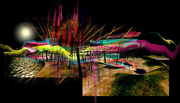
Brad Kligerman
Brad Kligerman, Ars Virtua's first artist-in-residence, is an architect cloaked as an artist and teacher, who, by assuming this disguise, is trying to better understand what it actually means to make architecture. What, how and why we inhabit virtual worlds is the most important question he is addressing at this time in his work and life. He is Kliger Dinkin in Second Life. He blogs about all this at Metaverse Territories (Building with immaterials); Metaverse Architecture (Architectural Ideas from the Metaverse); Image Cloud…

He does both gallery scale installations and projects at the scale of a territory. Of interest is the generation of spatial fragments that emerge from logical machines built by and for the project, and are necessary for its conception, its fabrication and its force. As a teacher, he leads a studio in an architecture school. Both of these activities (architect + teacher) are tied together by a strong emphasis on the invention of intelligent, interactive space that is respective of and emergent from its integral representational media, its local and global context and integrated constructive technologies.
Kligerman lives in Paris, France. He works in Paris, throughout Europe, the US and in the virtual world of Second Life, secondlife@Huchu/230/239/57/. See Kligerman's Ars Virtua Artist-in-Residence blog.
Posted by jo at 03:14 PM | Comments (0)
March 01, 2007
Solipsis [via iDC]
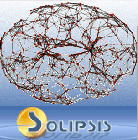
A Massively Shared Virtual World
Solipsis is a pure peer-to-peer system for a massively shared virtual world. There are no central servers at all: it only relies on end-users' machines. Solipsis is a public virtual territory. The world is initially empty and only users will fill it by creating and running entities. No pre-existing cities, inhabitants nor scenario to respect... Solipsis is open-source, so everybody can enhance the protocols and the algorithms. Moreover, the system architecture clearly separates the different tasks, so that peer-to-peer hackers as well as multimedia geeks can find a good place to have fun here! Current versions of Solipsis give the opportunity to act as pionneers in a pre-cambrian world. You only have a 2D representation of the virtual world and some basic tools devoted to communications and interactions. But it just works, so, come on and enjoy!
Continued from [iDC] Second Life and activism"
Ana Valdez wrote:
I have been reviewing computer games for the largest Swedish newspaper (400.000 copies every day) since 1984, when the computers were Atari, Commodore Amiga, Sinclair, Amstrad. At that time there were some small European companies trying to make themselves a spot, Infogrames, Cocktail Soft, Mindgames, Tati, it was France, Spain, Germany and Sweden who created some small companies. (I am explicitely taking out Japan because Japan is making games for console, Nintendo, etc, but was never a big player in the PC gamesmarket.)
Today the market is almost 100 procent owned by American companies who have bought the European companies. It's one Arabic company in Syria, Akkad media, who makes Under Ashes and Under Siege, the two only Arabic made and Arabic produced computer games.
In Sweden we have only one company, Mindark, producing the online world Project Enthropia, where the players can earn wages in real money, a big changing in the online worlds economy. And the company who makes Battlefield 1942 is Swedish but it produces it's games for the American market and makes games for Warner Brothers and others.
The computer games has evolved in the same way than the film movies, started with some young enthusiastic people making games in the cellars and garages (Myst was produced in a garage, Tetris by a lonely Russian mathematician who didn't earn revenue at all from Tetris, etc) to the big productions of today, where huge studios and hundreds of artists and programmers make the widespread games.
We don't have "indy games" yet, we should.
Ana
ps: online worlds, War of Worldcraft, Ultima Online, Everquest, Second Life, are all produced and developed in the US. In Corea Lineage, the highly popular online world, is produced and developed by Corean and American engineers.
Simon Gwendal wrote:
About the initial comment of Ana Valdes (the lack of freedom in current virtual worlds), I think that it emphasizes the little introduction to Virtual Worlds I wrote last year: http://p2pfoundation.net/Introduction
The book of Peter Ludlow give other examples of dictatorial decisions in virtual worlds.
As said in this introduction, the "free and distributed" alternatives to Second Life exist but they haven't succeeded in creating a "buzz" and, without community of players, a virtual world has few interest... We can only hope that people will eventually "understand" that the life proposed by Linden Lab in Second Life does not deserve any contribution because the power is not distributed. I personaly advocate for the Solipsis project (in France), which is now officially granted by the national research agency (from 09/2006 to 09/2008) --> http://solipsis.netofpeers.net
-- Gwendal
Joshua Levy wrote:
Thanks all for your insightful and thankfully skeptical takes on Second Life! While SL should never be intended to replace real life (some people actually criticize it for try to do so) people are finding that it offers us empathic experiences previously only found when people occupy the same physical space.
Scott Kildall hit on what I've been trying to articulate for a while -- that SL "offers re-spatialization of activity and a feeling of presentness... unique experiences that make people laugh and form deeper bonds -- this is where Second Life can excel." This ability to help people have deeper experiences that mimic physical closeness gives us the opportunity to connect in unforeseen ways. The first time I went into SL I had an experience that I think others of have had -- I couldn't stop laughing. I wanted a new shirt and asked the first avatar I found to help me find one, and she did. The naturalness of the interaction, the embodied nature of it, the seeming closeness -- it all felt so weird.
In response to Trebor's question about "inconvenient youth" and whether or not this fantasy world can "fertilize politics" in the real world, Brian Holmes reminds us that art in general often creates fantasies that enable us to "suss out all the connections to or disjunctions from the rest of lived experience." Fantasies have always served a purpose as spaces in which we can look out real life from a distance, or model life as we'd like to live it.
Andreas Schiffler points out the frustrating reality of it all -- SL requires so much bandwidth and CPU as to make it completely impractical for the kind of daylong use we associate with IM. He says that "if we are looking at it as a medium to disseminate information, the shortcomings outweigh the benefits," but I wonder if we aren't misguided to think of it as a "medium to disseminate information," which suggests a mass medium; many users already understand the true value of SL is in the quality of interactions it enables among small groups, not in its ability (or inability) to help people spread a message far and wide.
I've noticed that whenever I try to tell someone about my work in SL their thoughts quickly turn to money. "People are making money there, aren't they?" they always ask. Steven Shaviro extends this capitalistic obsession to networked media and the explosion of "user-generated content." "I fear that the call or incitement to participate, to get involved, to be creative, largely means that we are being asked to be entrepreneurs of ourselves, and thus work ever harder to facilitate our own exploitation." That's assuming that entrepreneurship equals exploitation, of course...
A few people brought up the fact that SL environments are often simulacra of real-world environments. Many of our computer interfaces also suffer from this lack of transcending their origins; it's struck me as strange that, for example, among the tools in Final Cut Pro are a "razor" and "reels." As Josephine Dorado points out, the real fun happens when real life imitates SL. I agree; like Josephine, I too want to fly and wear high-heel boots all the time! (Maybe not all the time...)
But Charlie Gere gets to the point; let's quote him a bit here:
"It would seem to me obvious that trying to make some sense of and find ways of mitigating the violence and unjustice in the complex world and culture we already necessarily inhabit, not least bodily, is far more pressing and considerably more worth defending than any supposed capacity to 'design and inhabit our on worlds and construct our own culture'. This seems to me to be at best a license for mass solipsism and at worse something like the kind of thinking that undergirds much totalitarianism, as well as an evasion of our responsibilities to the world as we find it."
Patrick Lichty is interested in the phenomenology of SL, as am I: the unique experience you get in SL that, while possibly solipsistic, gives us the chance to experience our world from a distance. But take Gere's critique that the real world contains problems far more pressing and dangerous than anything that could be happening in SL. Is there a place for this kind of mass solipsism -- can it connect it us to the pressing issues of our time -- or by laboring over building an island with orcas and moose living in the same space, or worrying about what shirt our avatar is wearing, or bombing a Reebok store and vandalizing John Edwards' SL space, are we evading our responsibility to fix a seriously broken world?
-Josh Levy
Posted by jo at 04:54 PM | Comments (0)
February 28, 2007
Architecture's Second Life
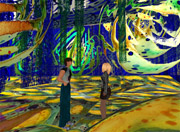
Replication of 1st Life or More?
"Who wouldn't enjoy the opportunity to change all the things about your life that you most yearn to change? This is the question the designers of Second Life had in mind when they built their successful massively-multiplayer online world. Second Life is not premised upon the completion of quests, doesn't require you to have a job, doesn't demand that you defeat any alien races or slay any dragons. The whole idea of Second Life is that you have, well - a second life in all of its minutiae. Starting with the creation of a new you, the Second Life world offers opportunities for the designing and construction of virtual clothing lines, virtual cars and yachts, and even virtual villas. There's been loads of hype, so much so, that celebrities make appearances, and big business has taken note.
For all the grand dreams of what life could be in Second Life (SL), this metaverse, as it's called, is decidedly more geared towards the exploration of post-silicon body modifications than the possibilities of spatial experience free of gravity, budget, and all those persnickety details. When it comes down to it, from an architectural perspective, Second Life just sort of replicates suburbia. In a universe built from free and easily manipulated virtual building units, there is a surprising lack of interesting work going on. Evidence, perhaps, that spatial banality is not just a symptom of something larger, but an affliction in and of itself." Continue reading Architecture's Second Life.
Posted by jo at 12:48 PM | Comments (0)
February 27, 2007
BREAKING NEWS:

MAN MICHINAGA SELLS THE BITFACTORY PROPERTY!
BREAKING NEWS: The Arts community in Second Life suddenly lost one of its most prized and established arts institutions late last night. The Bitfactory was the official rehearsal space for the performance art group, Second Front as well as serving as a location node for Intelligent Agent Magazine. The Bitfactory (formerly known as the Lichty-Michinaga Arts Center and Atelier Michinaga) had an equivalent reputation to the contemporary art museum, Ars Virtua. The Bitfactory's founder and owner Man Michinaga of Second Front will now devote his time and energy towards performance art and other creative endeavors... [blogged by Jeremy O. Turner aka. Wirxli Flimflam]
Posted by jo at 10:08 AM | Comments (0)
February 22, 2007
[iDC] Second Life and activism, etc.
![]()

Activism + Social Transmission
Second Life may or may not be overhyped, and may or may not be the future of the web, but I thought I'd share my experiences with it as I've worked on a documentary about political activism in SL. I've been surprised at how much I'm starting to appreciate its possibilities.
I've taken to heart Clay Shirky's critique that SL has been overly hyped by its creators, and I've been especially interested in Ethan Zuckerman's criticisms of a virtual Camp Darfur, which he argued is an inadequate tool for publicizing such a large scale tragedy; last May he wrote, "given that roughly 100,000 people log into Second Life in a given month - compared to roughly one billion using the Internet as a whole - I suspect people trying to call attention to global issues are better off making a website than a 3D space."
Nevertheless, many people are finding SL useful as a space for activists and organizers to model behavior and create idealized versions of things that are, in reality, broken. The folks I know best that are doing this are associated with RootsCamp, a progressive group/conference that emulates the open-source BarCamp idea of the "unconference."
Ruby Sinreich and Andrew Hoppin developed RootsCampSL, a weekly meeting in Second Life for RootsCampers. You might wonder why people would want their avatars to meet once a week when listservs, online groups, or wikis seem like suitable tools for helping us collaborate (and maybe we haven't even really figured out how to squeeze the best uses out of them yet). But as Ruby explained it at a RootsCamp conference in Washington, D.C late last year, Second Life is different even than instant messaging or IRC or wikis in that it offers embodied collaboration. Instead of getting frustrated with people talking over each other, or wondering if you or someone else is being addressed, in SL you can simply turn to an avatar and address them directly, or initiate a private chat, or walk away from the group.
A group called Doctors for Clark -- doctors who supported Wesley Clark for president in 2004 -- meets this way. They're spread all over the country so it's impossible for them to meet in the flesh, so they do the next best thing and meet in SL.
On the day the new Congress was sworn in I attended a press gathering at the Virtual Capitol Hill (it's a transparent building), and before a congressman from California swooped in (well, his avatar did) I chatted with people who really think that SL is turning into a legitimate platform for political communication and organization. Some of them were at a war protest at the same spot a few weeks later, dancing around and waving signs and typing slogans of protest and peace. It was wacky, but it was sincere.
I met a man who runs a peace and justice center at Better World Island that was one of the most moving pieces of protest art I've seen since the start of the Iraq war. The center is actually a semi-transparent, two-level house with images of children, deserted shoes, and ruins on its walls. When you touch these images you are given notecards with emails written to and received from Iraqis that the curator, Bruce Wallace, has befriended. They tell terrible stories of daily life in Baghdad, and they are personal and heartfelt. It's an art installation that moves beyond the space of Second Life and resonates strongly in the real world.
I also met a woman who runs the Center for Water Studies, also on Better World Island. The purpose of the center is to model endangered habitats to call attention to their real-world counterparts; it's actually quite beautiful and magical. The woman, who's avatar's name is Delia Lake, took me on a tour of the place and I saw moose and small animals on the ground, birds in the sky, and schools of fish in the water. She even took me for a ride on a giant Orca! The more I describe this, the crazier it sounds; I know this. It sounds crazy to me. But I think that this platform has helped me experience a certain empathy for these causes and the people behind them that I've never felt viewing standard web pages.
Although I haven't experienced it myself, I know that educators have had similar kinds of breakthroughs in SL as well. They describe being able to model behavior and situations in a way that lets students have a closer, truer experience than other mediated teaching methods allow.
I'm doing my best to maintain a healthy skepticism about it all. Is Second Life really a social platform that could eventually rival MySpace in size and outdo it in scope and influence? Is it paving the way for future apps that will change our relationships with technology and our assumptions about social media? Right now only about 40 avatars can be in any one place at any time or else the whole things crashes. Most people are there for sex or to dress up like gothic tigers or whatever. All of this serious stuff happens on the periphery and may be a passing fad. But what if it isn't?
I would love to hear about your experiences with SL -- your triumphs, failures, or complaints.
-Josh Levy
www.personaldemocracy.com
www.techpresident.com
www.levjoy.com
I've been using in Second Life for about 8 months now. I first became interested in it as one model of online relational communities with MySpace/Friendster/Facebook being another dominant style. Since then, I've been very active in it as an artist -- generating 2D prints and also a member of an 8-person performance art group called Second Front.
Overhyped or not, hard to tell. But, it holds promise in pushing new social transmission models.
Consider this: Second Life has an appeal that MySpace doesn't in that it breaks with the standard (including Web 2.0) style of online activity. These involve a passive or semi-active webspace with content that gets updated on an hourly, daily, weekly basis. Any sort of immediacy is done through IM. Old hat.
SL becomes useful in that it offers re-spatialization of activity and a feeling of presentness. The universe it creates is similar to ours in the local sense: avatars consume space; only one can be in a doorway at a time, etc. But, it also offers super-hero powers: you can fly, teleport, etc. The technology is crude and does hit huge lag points. But, intuitively, it resonates.
Creating a sense of space that we are familiar with, yet with expanded exploratory powers offers something unique. The Orca ride that Joshua talks about pushes ourselves into chance encounters that draw people into environments like Second Life.
As far as social activism, its hard to tell how this will pan out. Mass publicity is still best done through e-mails and websites. But, unique experiences that make people laugh and form deeper bonds -- this is where Second Life can excel.
Back to social transmission. One aspect of SL that I find interesting is that people create their unique avatars and after a little while, they pretty much stick with the look of their character. They develop communities and friendship networks -- places to go and things to do. But in a world where you can change skin color, gender and even species, you'd think there would be more experimentation. But, not so much.
The other transmission element is from the SL user to the non-user. I find in personal conversations that many people are fascinated by the descriptions I provide. I've demonstrated the Second Life in a couple of talks and afterwards, there are always a few who immediately sign up. Many more ask questions. Others remain skeptical. It certainly provokes a reaction.
There is something to Second Life: linked to attachment to a simulated-physical being in re-spatialized zones and the immediacy of information flow. Any sort of successful social/political activism will have to address the inherent characteristics of Second Life vs. websites, emails and more traditional forms of fundraising and awareness.
~ Scott Kildall
website: http://www.kildall.com
Second Front blog: http://slfront.blogspot.com
More proof I suppose that secondlife is the model T of virtual space. Not as fast or slick as some of the other options available... clearly not as good on gas. (Although I note that the KWH comparison was made against a worldwide average and not the average of someone who is currently using said computer and has the financial support to purchase broadband.)
But this model T is making it so that every (well connected and video encarded) computer user can, for most I would guess just once or twice, go in and consume some '3D' space. I'm also interested by the Wii talk, and with the motion sensor controller (the first of many no doubt) it does offer the chance to meld first and second life as it were.
The issue with many of the critiques that i've seen of our model T is that they criticize the first real success of a new way of doing things for having all the failings of a trailblazer.
Yes. It is bloated. It runs on too much power. The interface and designs are limited. It is run by a company which profits (one would assume) from running the environment. It slows down, depending on who you talk to somewhere in between 15,000 and 38,000 concurrent users. It's proprietary. The things created inside are not portable. All true.
But it does win at being first to come to the public domain. It's allowing people like me to apply for research grants that are going to explore how to interface 2D and 3D digital domains. (if you'll pardon the expression) We are going to take some students in and see what they do... It's a project that no one would have funded for me in Croquet. No matter how good that particular dream promises to be.
I'm not sure what the value of 'virtual space' will be pedagogically. In the interim its greatest value is allowing us to try out a few ideas, to get some funding and some leeway to poke our noses in. To talk to some people about their experiences. To help, perhaps, in the development of the next generation of 3D spaces, by contributing what we've learned.
I wonder, finally, if there is a research group that is accepting educational research from virtual space already out there... if not... I'd be more than willing to start one.
cheers. dave.
Very Interesting conversation...
As a researcher, teacher, (and until yesterday - just a hiatus) an art center administrator in SL, I have the following reflections:
I think that SL is part success, part Ponzi scheme. If you read the Official Guide, there is pretty exaggerated optimism across the board, and it is inherent across the media, website, etc. Linden has done a great job of evangelism.
This is not to say that, phenomenologically speaking, that SL is not a significant moment in net society. In many ways, SL mimics the early Web and art community the early Rhizome list, with a fairly tight-knit bunch of early adopters (I have had an account for 4 years, but only active on since November). There are interesting possibilities going on out there, and whether it is lasting isn't really mo concern. The fact that SL has hit a Gladwellian Tipping Point is important itself.
As one of the co-founders of the Second Front (of which Scott is as well) performance group, we have been doing very interesting things with gestalt, happenings, and identity manipulation. The tension between people and their avatars is something amazing to look at and manipulate. In many ways, I feel very Duchampian about recontextualizing my own identity in terms of avatar and location. It's very strange that at one moment, I'm talking to people like Alan Sondheim and folks connected to groups like General Idea, and then on the next breath, you have a horny newbie soccer mom who is asking for a quick romp in the hay. Really surreal.
As an educator, I think that I like to stick closer to things that SL is especially good at, like Machinima, spatial narrative, algorithmic experiments. Although I am learning a lot of new tools, like scripted podiums and viewscreens, the thing that I think has the most potential are things like live videocasts, avatar performance, streaming audio, and external links. In this way, I think that people do get a better haptic feel for 3D space, and once you get the hang, it's really intuitive. I do think having a concurrent distance environment can be really useful, but there is no way I want to have a solely SL-based classroom.
Overall, I think that SL has mastered the micropayment, has integrated scripting, animation, real-time navigation, and so on in a way that has gotten compelling enough in its open-endedness to make it really robust. The thing that I wonder about is why it took off and not There.com or AlphaWorlds - perhaps toolset. And although Second Front members first met in places like The Palace and OnLive Traveller years ago (therefore not the 'first' of its kind, even if you consider There) SL is at a convergence point, and is at the right time, with a robust enough set of tools, seamless economics (that get a little too ubiquitous at times), and a really compelling social component.
Two major beefs with SL are that it can be an immense money/time sink, and that I feel like the time dilation in-world is pretty toxic. What I mean is that a week feels like a month - so much tends to happen. I went in to talk to a friend one night, and she chided me that I had not said hello for weeks, when it had been 5 days. Secondly, people tend to want you to IM Immediately, and if you're buying property, doing a performance, we need to do it tonight, tomorrow or the next day - next month is unthinkable. It creates an environment in which the virtual world takes increasing parity with the physical, and I personally do not want to sit in front of a monitor all my nights chatting - keyboarding day and night is just not healthy. It promotes the Partial Attention problem, and further chains us to our chairs.
I want to go bicycling once in a while.
Therefore, SL has a great set of tools, an amazing PR campaign, but the big argument I have with any 'early adopter' story like mine is that I have found that we keep hoping that the next technology will solve our problems. I feel like technology often begets more technology and although it has true use value, it's still the human equation that makes the difference.
Activism? As far as dissemination of info, in a multi-modal way, SL can be incredibly compelling. Possibly, due to its current visibility, it could be a tactical media tool (the National Front has a zone, o_0 ). But as far as activism is concerned, I think that feet-on-pavement is still superior to just about everything. To say that we're going to be terribly effective on a fairly elite private net with fairly specific technical and educational requirements leaves that project rather circumspect - more so than protestors negotiating with the police in DC about where they could protest. I feel like protest in SL is too much in the Fishbowl.
The real power of it is when it starts bleeding out into RL. That might seem like a contraditction from my last sentence, but I'm already seeing memes pop out here and there.
I'll leave it at that.
Off to RL-heavy New Orleans for the weekend.
Welcome to the crash zone.
Patrick Lichty
- Interactive Arts & Media
Columbia College, Chicago
- Editor-In-Chief
Intelligent Agent Magazine
http://www.intelligentagent.com
Dear Colleagues, the following event might be of interest to you:
Massively Multi-Learner , 22 March, 2007
Location: University of Paisley, Paisley
http://www.ics.heacademy.ac.uk/events/displayevent.php?id=142
Growing numbers of people now spend large parts of their leisure time inhabiting immersive on-line 3D virtual worlds, known variously as MMOs (Massively Multiplay Online), MMORPGs (MMO Role-Playing Games) and MUVEs (Multi-User Virtual Environments).
A growing number of academics and practitioners are realising that such environments also have strong potential as the Virtual Learning Environments of the future. This workshop aims to showcase the emerging theory and practice of teaching and learning in MUVEs - from studies of how users engage socially in virtual worlds to practice based case-studies of teaching and knowledge transfer and the emergent pedagogies of the 3D internet, and its relation to the web-based learning technologies of the present.
The role of learning within guilds
Carl Potts, University of Salford
The significance of community within MMORPGs. I share the view of Mulligan and Patrovsky that 'players come for the game and stay for the community'. My talk will explain briefly how players are organised with these communities using World of Warcraft as an example. It will focus on the role of learning and dissemination of knowledge within these communities, and potential for the development of transferable skills.
Putting the Real in surreal - How scientific simulations can be used in a
virtual world
Mike Reddy, University of Wales, Newport
This presentation is not about how to reproduce the real experience of f2f or campus based learning. Rather, this discussion is about how to use situated simulations as a teaching tool in a wide variety of scientific disciplines: Games development students are using Second Life as an adaptable prototyping tool for 1st/3rd person games; Design students are engaging in product trials and aesthetic design, such as wearble technology; Science students are attempting to recreate scientifically plausible scenarios, such as our Nasa CoLab sponsored Mars terraforming simulation, Project Aria. The aim of this and future work is to enable students to get their virtual hands dirty. Building is the best way to learn.
Programming Playground
Mike Hobbs, Anglia Ruskin University
The explicit aim is to get second year computing students to design and implement interactive artefacts in Second Life to demonstrate simple programming concepts for use by novice programmers. The hidden agenda is to kindle a sense of discovery, ownership and fun in a subject that can seem abstract and remote.
Integrating Second Life into Design for Digital Media
Annabeth Robinson, Leeds College of Art and Design
How second life can help to directly support or simulate art / design progression of skills and profesionalism throughtout a 3 year degree program. Annabeth will also discuss virtual worlds from her perspective as a practicing artist in Second Life.
Developing visions of schome (the education system for the Information Age)
Peter Twining, Open University
Peter will briefly explain what schome is (not school - not home - schome - the education system for the Information Age), before going on to outline why and how we are using Second Life to enhance our thinking about schome. See http://www.schome.ac.uk/ for further info.
Virtual Learning Environments and Virtual Worlds: The Sloodle Project
Jeremy Kemp, San Jose State University
As mainstream educators slowly get to grips with the enhanced potential of using web-based virtual learning environment, others are forging ahead with 3D virtual environment. This presentation will outline where the web-based environments provide support for learning that may be lacking in richer 3D environment - and introduce the Sloodle project which aims to integrate the web-based and the 3D virtual learning environments.
Social Networking in Virtual Worlds
Aleks Krotoski, University of Surrey
Much has been made about the marketing potential of social networks in virtual worlds (the popularity of branded advertising in Second Life attests to that), yet how do participants learn from one another in casual and social contexts in online environments? This presentation explores what it means to be "close" in a dis-proximate space, and how the ethics of analysis must take into consideration the meanings of networks in these conceptual places.
Integrating Games Based Learning into the Classroom
Helen Routledge, TPLD
This session presents a case study on the educational game EDUTEAMS and shares Routledge's experiences of integrating the software into class times of 50-minutes or less with the effect of delivering understandable bit size chunks and visible learning gains among pupils as well as how the games are assessed by teachers along national curriculum guidelines. Both the pupil and teacher perspective will be discussed as well as the essential elements required to make effective use of games in the education system and the benefits of TPLD's approach. The ideal scenario will be explored and real life examples presented from schools around the UK that used this methodology.
Knowledge Transfer and Public Engagement in Virtual Worlds
Dave Taylor, National Physical Laboratory
Dave has been working on the use of Second Life for Scientific Communication and Technology Knowledge Transfer. He will describe Second Life's three emerging Knowledge-based continents: Info Islands, NMC Virtual Worlds and the SciLands where NPL are one of the founder members. He will also examine the extraordinary effectiveness of Second Life for facilitating collaboration between small and large organisations and the general public, and the benefits for technological knowledge transfer between researchers and industry.
You can find information about travel and accommodation at the following
link: http://cis.paisley.ac.uk/livi-ci0/paisley-travel.html
Dr Andy Miah | email[at]andymiah.net | http://www.andymiah.net
Reader in New Media & Bioethics
School of Media, Language & Music
University of Paisley
Ayr Campus, KA8 OSR, Scotland, UK.
[t] +44 7962 716 616 [f] +44 1292 886371 [e] email[at]andymiah.net
The Second Life (SL) buzz sounds just like the tech-salvation propaganda that surrounded the telegraph, the BBS, and later mailing lists. Rheingold and Lessig gave lectures in SL, 70 universities built a "campus" on the island, non-profits are storming in, businesses are opening up, avatars are exchanging "real life books" in SL, people set up galleries (but where is the audience?), performance groups do their thing, and avatars demonstrate against the war. It's a stunning social experiment.
But not for a second do I buy the argument that synchronous virtual worlds like Second Life are the future of the net. Nevertheless, I'm quite interested in SL as a model for civic participation and cultural production. Environments like Second Life are one emerging aspect of networked sociality and I am curious to hear more about the amateurs who, on the proprietary grounds of SecondLife, are willing to give their immaterial labor away for free. We discussed that before with Amazon.com.
The always amazing Henry Jenkins writes: "I take my good news where I can find it and for the moment, the coverage of SL, bad though it often is, is helping Americans in general adjust to the idea that there may be something positive to be gained by having an active fantasy life on line." But SL is not just an all-American phenomenon. Just look at attempts of re-branding Africa, for example. There are, of course, obvious limits to the use of such environments in developing countries as it takes high-powered computers and a whole lot of bandwidth to have a decent experience in SL.
Particular examples of participatory culture may fade but networked participation will not go away.
Jenkins: "And for the moment, the debate about and the hype surrounding SL is keeping alive the idea that we might design and inhabit our own worlds and construct our own culture. That's something worth defending."
My main question to Jenkins and all of you concerns the relationship between this virtual world and "first life." Do these virtual worlds merely provide an inconvenient youth with a valve to live their fantasies of social change (elsewhere), or do they, in some measurable way, fertilize politics in the world beyond the screen?
Trebor
Second Life
http://secondlife.com/
Get A First Life
http://www.getafirstlife.com/
Teaching experiments in SL
http://www.cnn.com/2006/TECH/11/13/second.life.university/index.html
A Western shot in SL
http://bellsandspurs.com/_video/
"More than 70 universities have built island campuses in Second Life"
http://news.com.com/2100-1032_3-6157088.html
Lynn Hershman screens new film in SL
http://lynnhershman.com/newprojects.htm
Avatars Against the War
http://lotusmedia.org/post-protest-processing
Re-branding Africa in SL
http://annansi.com/blog/2007/01/africas-second-life/
Images of Activism in SL
http://www.flickr.com/photos/venicevandal/sets/72157594474252794/
from giselle beiguelman:
But not for a second do I buy the argument that synchronous virtual worlds like Second Life are the future of the net.
I agree. Nevertheless is a very interesting art space. SL has a curious cybrid format. I mean a space between on and off line networks that can be used as new layer of our territorial experience. I'm working now on a new project conceived for SL, exploring its potential as a cinematic space and the resources its inhabitants can use in order to get different points of view (flying, zooming etc).
It seems to me that the cinematic experience you have there announces in some ways what can be the the migration from machines of motion to machines of vision, or the new cinema. Peter Weibel wrote some years ago a long essay on digital images that could be a point of departure for that discussion:
"The nineteenth century was obsessed with motion - with illusions of motion, and with machines of motion. There were two kinds of machines of motion: the first tried to analyze motion, the second to synthesize motion. The analysis of motion was the task of the camera; the synthesis of motion was the task of the projector. The evolution of cinema in the nineteenth century can be attributed to two major trends: firstly, to the progress in experimental physiology and psychology leading to the Gestalt psychology, and secondly, to the advances in machines attempting to adapt and transfer the physiological mechanism of perception into machines capable of the visual simulation of motion and - herein lies the problem - not into machines of perception.
Therefore, what we know as cinema today is in fact already a reduction of the nineteenth-century principle that began to investigate machines of vision, but finally reduced them to machines of motion. There is the moving-image industry with its motion pictures, that is to say: the Hollywood system. Its code is a legacy of the nineteenth century, and reduces the initial exploration of machines of vision to machines of motion. Only the avant-garde cinema of the 1920s, 1950s and 1960s maintained the original intention of creating machines of vision. Classical cinema, therefore, already diminished the initial enterprise, which was about perception. Perception was reduced to the perception of motion, and remained on the retinal level because there was no pursuit of the question of how our brain perceives the world. People constructed machines with a kind of graphic notation - "la methode graphique" (Etienne-Jules Marey) - of motion. This method can be said to be still valid, tragically enough, today.
What Marey did was to analyze, and deconstruct, motion with his famous graphical method. It made no difference whether a drawing machine was used or, as in the case of Eadweard Muybridge, a photographic machine. Both Muybridge and Marey soon realized that it is not enough to analyze motion, but many other machines had to be used in order to project, to synthesize, motion. We may conclude this interpretation with the fact that cinema was invented in the nineteenth century. The twentieth century merely turned the nineteenth-century inventions into standardized mass media - including television, which became a consumer apparatus. As a side-effect, we simultaneously turned this machinery not only into mass media, but also into art, an individual approach.
Cinema is a writing of motion (cinematography); it is just a machine that simulates motion for the eye. The avant-garde, from Dziga Vertov to Steina and Woody Vasulka , kept to the initial idea: machine vision - not machine motion. Vertov gave us the term Kinoglaz , the camera eye. With the advent of video (Latin: I see), it was clear that we had to make a paradigmatic shift from imitating and simulating motion to imitating and simulating vision with the help of machines. We had to change from cinematography (the writing of motion) to what I would call the writing of seeing: opsigraphy, from the Greek word opsis (as in "optics"). Or even to opsiscopy, the seeing of seeing - in other words, the observing of observing mechanisms. In cyberspace, for example, when you see yourself and your actions as an image, you are already in opsiscopic space. You are observing yourself in a picture that you observe; it is an observation of the second order. In fact, cyberspace is the beginning of opsiscopy: of machines that see how we see."
In short, I think SL can be considered an opsiscopic space that allows to transcend sometimes the basic descriptive movements we do in our FL (First Life) and because of this points to new directions in the digital arts field in general and digital images in particular.
giselle beiguelman
from Steven Shaviro:
This past week, I gave a brief-talk-plus-demonstration at my University, to an audience much of which was librarians, about the educational potentials of Second Life. I painted a picture that was not untrue, but that perhaps was rosier than is fully justified. As the real-life audience in an auditorium watched it all on a big screen, I conducted a lively but quite short discussion with a bunch of folks within Second Life about how new media were changing both what was being studied and learned, and how it was being studied and learned. People in both the RL audience and the virtual audience seemed to like it; though in the former case this was probably more due to the wow! factor than to anything I (or anybody else) actually said (or typed).
I only bring this up by way of approaching Trebor's question: Do these virtual worlds merely provide an inconvenient youth with a valve to live their fantasies of social change (elsewhere), or do they, in some measurable way, fertilize politics in the world beyond the screen?
I think that we are reaching the point where people can do pretty much any of the things they do in their "first lives" in virtual worlds like Second Life as well. This is not to say that the two are the same, of course; there are obvious and vast differences (e.g., people in different physical locations can engage in real-time interaction in Second Life, and have the sensation of a sort of shared 3D space -- though it's cartoony, it still gives a certain feeling of 'thereness' that other media, even more naturalistic ones like two-way video chat, fail to do; on the other hand, and just as obviously, a conversation in Second Life is likely to consist mostly of one-liners, rather than the extended essayistic reflection we can indulge in on a mailing list like this one; not to mention that the anonymity, combined with the ability to simulate actions that you could never do in "real life" contribute to a kind of puerile and feverish fantasy atmosphere).
But still, overall, Second Life is connected enough to "first life," and mirrors it closely enough in all sorts of ways, that we can pretty much do "there" the same sorts of things -- especially collaborative, social things -- that we do "here." The virtual libraries in Second Life, for instance, are quite interesting and might even, at some point, become truly useful (though of course, a lot less people use them than use the SL sex clubs or combat simulations). Some of the artist exhibitions in Second Life, as well as some of the spaces which are themselves, in effect, art works, are quite good and worth exploring.
As for politics: a protest against the Iraq war in Second Life is little more than an empty symbolic gesture; but one might cynically argue, especially given the tendency of the media to ignore them, that real-world protests against the war , however many people they draw, are at this point little more than empty symbolic gestures either.
On the other hand, I don't think that one could find any equivalent in Second Life of political organizing that takes place in "first life": if only because the people in Second Life are a fairly narrow, self-selected and affluent, group.
But beyond this, the thing that really gets me about Second Life, and that seems to me to be the most important thing one can say about it, is how *commodified* the whole experience is, and how SL is dominated by notions of creativity, coolness, entrepreneurship, and so on... all of which relate undamentally to advertising and commerce and making money. It seems to me that Second Life, and other MMOs (massively multiplayer online worlds or games) need to be understood in the terms of political economy (of an at least quasi-marxist sort) before they can be made sense of in any other way. And that, in this sense, they are little different from any other aspect of what has variously been called the society of the spectacle, the network society, or the new world order of neoliberal globalization.
Yes, the new media are many-to-many instead of one-to-many like the mass media that dominated most of the twentieth century; but I fear that the call or incitement to participate, to get involved, to be creative, largely means that we are being asked to be entrepreneurs of ourselves, and thus work ever harder to facilitate our own exploitation.
I am being rather hyperbolic, perhaps. But if anyone is interested, I've put online a recent essay of mine in which I address these points in (hopefully) less of an off-the-cuff manner:
http://www.shaviro.com/Othertexts/MMOs.pdf
S
Steven Shaviro
http://www.shaviro.com
THE PINOCCHIO THEORY:
http://www.shaviro.com/Blog/
from Charlie Gere:
Trebor
I think your invocation of previous new media hype in relation to SL is very timely, and your question about whether it is a safety valve for fantasies of social change most pertinent. But I think the problem of academic hype about SL is even worse than you suggest and seems to be encapsulated by the statement from Henry Jenkins you quoted to the effect that "... for the moment, the debate about and the hype surrounding SL is keeping alive the idea that we might design and inhabit our own worlds and construct our own culture. That's something worth defending."
To be honest I don't see why. It would seem to me obvious that trying to make some sense of and find ways of mitigating the violence and unjustice in the complex world and culture we already necessarily inhabit, not least bodily, is far more pressing and considerably more worth defending than any supposed capacity to 'design and inhabit our own worlds and construct our own culture'. This seems to me to be at best a license for mass solipsism and at worse something like the kind of thinking that undergirds much totalitarianism, as well as an evasion of our responsibilities to the world as we find it. Such a fantasy seems to be at play in both the relentless construction and assertion of 'identity', a drive that militates against proper social solidarity, and thus plays into the hands of those sustaining the status quo, as well as the fantasy entertained by the Bush government that the Middle East can just be redesigned as if in some video game
Apart from anything culture is not something that can simply be constructed. It is something we are thrown into and which we can only at best try to negotiate our relationship with. Culture necessarily involves other people and prior existing structures. Has Jenkins considered what it would mean if everyone felt free to 'construct their own culture'. Even if such a thing were possible, it is certainly not desirable, especially if we have any hope to produce a properly participatory culture.
Frankly as far as I am concerned SL is really just a kind of cultural pornography, and is to the real business of culture what masturbating is to sex with another person. I like masturbation as much as the next man, or indeed woman, but I don't make the error of mistaking for something it isn't. Apart from anything else it lacks precisely the element that sex has, that of involving a proper, embodied, responsibility to someone else and to the potential consequences of the act itself.
Charlie Gere
From A. G-C:
On the Second Life, I would want to say four things:
1. The question is not to know what it is worth "symbolically" but the influx and the variety which compete as ubiquitous society to it indeed deserve to ask questions from fields such as: ergonomics, simulation, digital sociology, languages (linguistics and semiotics).
2. Nevertheless, the second critical point, without going to the psychology either in the sociology, or in the languages, is simply the question of the real time because the time all the contrary of the space, is not double, it is barely unit (on earth). The time spent by playing an executive simulation of the life, raises a true problem of entropy of fictitious time in the material life; And thus results a lack of time to face the material conditions of the life, except for the persons among whom it is the job or the position to navigate and to create on Internet.
It defines an expert frame of the researchers, not the release to the empirical research (what is the only available way of research more the help of the stochastic disposition into our randomized actual times -- that one being reinvented by the researchers of exact sciences with impact in the
life): it is thus even there a dissolution of the democracy including of meta politics (according to which the agreed fact would be that the fantastical passage to the playful virtual act would be an increased reality
-- that is not sure in matter of power). The only very power in such a game can being who know the tech languages and observe the digital abstract tracks.
3. It is maybe interesting that left the communications censored on Internet can hide in such a device, under the shape of a feigned community which does not look like the one who hides under these features, or then economic observers for the study of markets?
Why not also secret services, for example - and blow: who observes as fake player or fake artist? Who thinks that he/she is anonymous under his mask? Otherwise the one who puts a lot in an addictive way.
4. There is a macro phenomenon which succeeds the micro computing diverse multiples (addition of singularities) on internet, it contribute in the big hypermedia supra community as MySpace, YouTube, etc... (But I mean may be any of us of have still evocate it).
Here the Second life, exactly the set which as game corresponds to Google earth increasing MySpace in a plastic second reality in real time, as the representative identification of techno-mass - exactly something as real from the active part of the real players through their personal computers as a mass in a dynamic stadium as large as possible - till the increasing worlds -, interactive hypermedia as techno-multiculturalism in mobility (here multiculturalism is to be hear as virtual genre) online.
From Ricardo Dominguez:
Virtual terror strikes Second Life
by Glenn Chapman Sat Feb 24, 11:54 AM ET
SAN FRANCISCO (AFP) - In an explosive display, virtual-world banes now mirror the havoc of the real one as terrorists have launched a bombing campaign in Second Life.
People controlling animated avatar members of a self-proclaimed Second Life Liberation Army (SLLA) have set off computer-code versions of atomic bombs at virtual world stores in the past six months -- with their own manifesto.
The SLLA claims to be an "in-world military wing of a national liberation movement" devoted to replacing the rule of Second Life creator Linden Labs with a democracy representing the nearly four million residents.
"As Linden Labs is functioning as an authoritarian government the only appropriate response is to fight," the SLLA said in a message on its website at http://secondlla.googlepages.com.
"When the SLLA succeeds in its aims it will disband and hand power back to the political wing of the movement."
Creative dissent is welcomed in Second Life as long as it doesn't interfere with the ability of other residents to enjoy the virtual world, according to San Francisco-based Linden.
Second Life said it stopped charging a tax on items created by residents after avatars fashioned in the images of American revolutionaries recreated the Boston Tea Party in the virtual world about three years ago.
Since then, website users adept at manipulating computer codes have engineered mischief including a "push gun" that blasted other avatars back when fired, according to Linden.
"We do the utmost to ensure the protection of creative expression, within certain bounds," Linden marketing director Catherine Smith told AFP on Friday.
"Ultimately, instances in which residents engage in simulated violence will have to be taken on a case-by-case basis."
The virtual bomb blasts in Second Life explode in hazy white balls, blotting out portions of a screen and battering nearby avatars, animated figures that are residents' proxies in the virtual world.
The disruptions are brief and do not cause lasting damage in Second Life, according to Linden.
Residents are given free rein in Second Life, as long as they don't harass or interfere with other avatars in what is referred to in-world as "griefing."
SLLA bombings have been viewed by Linden as "mock terrorism" done in fun to catalyze debate about the in-world power structure.
"We believe recent events involving SLLA protest lack malicious intent," Smith said. "Resident reaction to such attacks has been decidedly tongue-in-cheek."
The SLLA website demands that Linden give Second Life residents "basic rights" by going public and allowing each avatar to buy a share of stock at a set price.
In instances where residents feel harassed by the SLLA, Linden will dole out temporary banishment or other such penalties as outlined in the virtual world's written terms of service, according to Smith.
iDC -- mailing list of the Institute for Distributed Creativity iDC[at]bbs.thing.net http://mailman.thing.net/cgi-bin/mailman/listinfo/idc
List Archive:
http://mailman.thing.net/pipermail/idc/
Posted by jo at 03:56 PM | Comments (0)
February 12, 2007
Marginalia in the Library of Babel
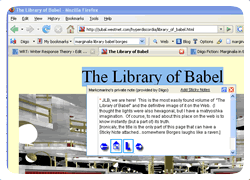
Diigo Fiction
Marginalia in the Library of Babel [in progress — alpha release]: "It starts with Borges. It always starts with Borges, the god of our hyperlinked souls. I fight the solitude of the vertigo he has imagined for me, and yet I may have finally found a way out of the labyrinth.
At night, I search for Borges, alone, hunched in the solitary chamber of an internet browser. If I was not seeking him, I’d be seeking myself. And I already know where I am and the speck size of my shadow on the Web."
Diigo Fiction: Marginalia in the Library of Babel: [This post offers context for a work-in-progress entitled Marginalia in the Library of Babel. alpha release.] Let us write stories in the margins of the Web: The web is becoming ours to write with. Whether supplying, ranking, or reviewing its contents or reordering the web with our folksonomic tagclouds, we are becoming the owners of more than just our Craig’s list and Ebay possessions. We are orchestrating this web and making of it what we will. Jeremy and Matt Kirschenbaum have reported on the moments when the tagclouds become art (see inset image made via TagCrowd.com). And now the web pages themselves have become our surfaces, our building blocks. Here’s how… More >> [blogged by Mark Marino on WRT]
Posted by jo at 06:08 PM | Comments (0)
February 08, 2007
My First Second Life Dance Performance
On Sunday night, while watching the Super Bowl, I attended the premiere performance of Second Life Ballet's "Olmannen" in the Second Life virtual world. I wrote about this upcoming performance last week.
Well, I had to give myself a crash course in Second Life to attend this performance because I've never experimented with this virtual environment. But just about everything went wrong on the computer and software side for me, which I'll explain more about below.
But first, here is background about the Second Life Ballet performance so you can have an idea of what an avatar dance performance is like:
- The program guide for the performance of "Olmannen: An Original Ballet."
- A news piece from OspreyTherian, uploaded to YouTube, recaps the Sunday night performance. You can see the dancers in the background for a few seconds, which gives you a glimpse of what dancing is like in this virtual world: More >> [blogged by Doug Fox on Great Dance]
Posted by jo at 07:29 PM | Comments (0)
February 07, 2007
0100101110101101.org's
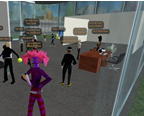
3 classic performances at Ars Virtua!
Chi5 Shenzhou sent me a TP (TelePort) to Ars Virtua and the audience as well as the critics and artists were already milling about while gathering their energy and nerves waiting for the retro-performance-bonanza to begin...
Hey there performance art fans!
Today was a special day in that the reknowned con-ceptual artists, Franco and Eva Mattes aka. 0100101110101101.org were back at Second Life's Ars Virtua for another arousing round of exhibitions! This time their retro-performance trinity was being broadcast (possibly projected) into a contemporary art museum in Trento (Italy) known as the Galleria Civica d'Arte Contemporanea.
For this day (evening in Italian time), Franco and Eva focused on remediating the classics of performance art. If you scroll down the blog a bit, you will realize that they remediated a previous performance remediation by myself and Great Escape... How Postmodern is that! More >> [blogged by Jeremy on Wirxli FlimFlam's Second Life Blog]
Posted by jo at 11:50 AM | Comments (0)
February 05, 2007
Clay Shirky
![]()
Second Life, Games, and Virtual Worlds
"[...]Here we arrive at the furthest shores of speculation. One of the basic promises of virtual reality, at least in its Snow Crash-inflected version, is that we will be able to re-create the full sense of being in someone’s presence in a mediated environment. This desire, present at least since Shamash appeared to Gilgamesh in a dream, can be re-stated in technological terms as a hope that communications will finally become an adequate substitute for travel. We have been promised that this will come to pass with current technology since ATT demoed a video phone at the 1964 World’s Fair.
I believe this version of virtual reality will in fact be achieved, someday. I do not, however, believe that it will involve a screen. Trying to trick the brain by tricking the eyes is a mug’s game. The brain is richly arrayed with tools to detect and unmask visual trickery — if the eyes are misreporting, the brain falls back on other externally focussed senses like touch and smell, or internally focussed ones like balance and proprioception.
Though the conception of virtual reality is clear, the technologies we have today are inadequate to the task. In the same way that the theory of computation arose in the mechanical age, but had to wait first for electrics and then electronics to be fully realized, general purpose virtual reality is an idea waiting on a technology, and specifically on neural interface, which will allow us to trick the brain by tricking the brain. (The neural interface in turn waits on trifling details like an explanation of consciousness.)
In the meantime, the 3D worlds program in the next decade is likely to resemble the AI program in the last century, where early optimism about rapid progress on general frameworks gave way to disconnected research topics (machine vision, natural language processing) and ‘toy worlds’ environments. We will continue to see valuable but specific uses for immersive environments, from flight training and architectural flythroughs to pain relief for burn victims and treatment for acrophobia. These are all indisputably good things, but they are not themselves general, and more importantly don’t suggest rapid progress on generality. As a result, games will continue to dominate the list of well-populated environments for the foreseeable future, rendering ineffectual the category of virtual worlds, and, critically, many of the predictions being attached thereunto." From Second Life, Games, and Virtual Worlds by Clay Shirky, Many-to-Many.
Clay Shirky, Beth Coleman, and Henry Jenkins have decided to coordinate simultaneous blog posts discussing Second Life.
Henry's post, A Second Look at Second Life, responds directly to some of Clay's previous criticisms of SL press coverage, but shifts the focus: "I care only a little bit about the future of virtual worlds. I care a great deal about the future of participatory culture. And for the moment, the debate about and the hype surrounding SL is keeping alive the idea that we might design and inhabit our own worlds and construct our own culture. That's something worth defending." [via]
Posted by jo at 07:00 PM | Comments (0)
February 03, 2007
Networked Theatre of the Oppressed
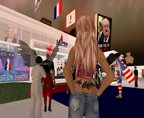
Second Life Theatre Group Meeting
Networked Theatre of the Oppressed :: First informal Second Life theatre group meeting in Bootlab Berlin :: Sunday February 6, noon (brunch time, 12.00 h) :: Tucholskystraate 6.
The dictatorship of the bourgoise melodrama stage has been an inspiration to living theatre, Brecht, Boal, and many. By combining the poetics of storytelling, digital narrative and network performing, the ghostly streets of Second Life become an open stage where the practice of everyday life becomes the raw material for political intervention thru classical drama, literature and net.art techniques. It is time for the triple alienation of the cyburbian multitudes!
Second Life's publicity is generated outside of the internet based on old media PR, circumventing the rest of the net. It is a newbie honeypot, or a themepark for cyberspace history most of all it is a "opera buffa" a theater of vulgarities, and shallow motivations, certainly more reality than what the cultural institution of the theatre has to offer today.
In our first 2 hour practise meeting we want to discuss possibilities of stage design, choreographic moves, myths and topoi, requisites and figurines, sketches of existing 3d datasets and scripting knowledge, we want to identify interesting text resources and invite people researching the field, detecting possibilities for a theater of net.art 2.0 etc. pp. not just revolting but playing with the zombie cybermyths of SL.
The Second Life can not be lived rightly...
- - how can you have virtual sex and no virtual communism?
- - between underworld and purgatory, spaces for the organized networks of
death
- - did 1995 avatar utopia needed lindon economy to reach the masses.
- - there are more than 3 million condemned waiting for liberation.
- - come and sacrifice your pets at a pergamon temple.
- - a virtual world is impossible. lindon dollars are halluzinogenic.
- - california dreaming, do you feel the network effect?
- - zoylent green is us!
- - instalaremos la primera antena zapatista de radio insurgente y la
otra campa??a en second life.
http://bootlab.org
http://possibleworlds.org
Posted by jo at 11:29 AM | Comments (0)
February 02, 2007
SummerBranch
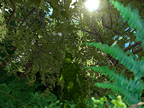
Truth and Artifice in Nature
Summerbranch is a new commission by igloo that explores movement and stillness in nature. Using camouflage and other disguises, a person or a computer character can blend into a ‘natural’ environment captured and treated through the moving image. This installation uses the tools of the military-entertainment complex, computer gaming, motion capture, 3D environments and special effects to question what is truth and what is artifice in our attempts to reproduce nature. Through the creation of a computer generated virtual world, Summerbranch seeks to address this by the use of disguise in dance and movement. IGLOO not only investigates the role of the ‘real’ in virtual environments but also that of the reproduction of nature in the history of art and particularly landscape work.
Summerbranch is the result of a 2 month residency at ArtSway in the New Forest. The exhibition is created for 3 gallery spaces. A series of intermedia works which can stand alone as individual installations or together as a site specific install comprising 3 parts: Virtual environment, Video installation, a set of Lenticular Prints & Wallpaper. [via Rhizome]
Posted by jo at 02:39 PM | Comments (0)
January 31, 2007
Hazardous:
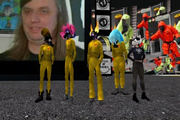
Second Front watches "Strange Culture"
This week we were invited to attend the premiere of "Strange Culture", an independent film by Lynn Hershman which discusses the infamous case of the arrest and pending trial of Steve Kurtz from the Critical Art Ensemble. The film will be shown at the Sundance Film Festival this week and has the distinction of being the first-ever feature film shown in Second Life.
It seemed altogether appropriate to have the first-ever performance art group in Second Life present at opening night (afternoon). We decided to don hazmat suits and gas masks to show our support for the defense in the ongoing Kurtz case. Second Front was unusually subdued in its urge to create a large-scale performance. We sat quietly and watched the film. The only sound besides the movie soundtrack was the constant clicking of the Second Life cameras as we documented this historic event.
Watching a movie in Second Life was totally weird. When you get to the movie theater, you hit the play movie control on your SL window. We're all watching the same film, but a different times! That seems like the most significant difference from a traditional cinema. Continue reading Hazardous: Second Front watches "Strange Culture" by Great Escape, Second Front.
Posted by jo at 01:00 PM | Comments (0)
January 30, 2007
SOCIAL ANIMAL
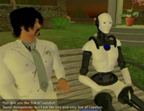
Son-of-Copybot
A conversation with Social Autopoiesis, one of the first fully-formed interactive NPC avatars in Second Life. Best viewed as a Windows Media video here; low-res YouTube version here.
I got a clue from Dedric Mauriac, and found Social Autopoiesis sitting there on a park bench on the isle of Discordia. So I joined him, and got to talking, and after a time, he told me he was the son of Copybot. (Then again, he also claimed to be logging in from a leather bar in the Castro district.) Whatever the case, he's perhaps the first avatar-based, conversation-enabled, non-player character to enter Second Life-- a project stemming from libsecondlife, the admired (and occasionally vilified) initiative to create a reverse engineer version of the SL viewer. Making such 'bots as Autopoiesis possible.
Like any conversation with a chatbot powered by a limited database, dialog with Social Autopoiesis is apt to run off the rails, on occasion; watch this video, to see. (View with Windows Media player; intermittently ribald chat possibly not safe for work, unless you work in a steel mill.) Or have a chat with him yourself-- direct teleport here. Continue reading SOCIAL ANIMAL by W. James Au.
Posted by jo at 05:33 PM | Comments (0)
January 24, 2007
Performing Second Life

Gaza Stripped
These past couple of months has been extremely productive for me... Not only was the performance-art group that I co-founded, Second Front formed within days of me actively creating my avatar (Second Front est. November 23, 2006) – this very same group was able to add Gazira Babeli to our roster almost exactly a month later. For those who do not know Gazira Babeli already, she is probably considered to be the very first dedicated performance artist in Second Life. Little is known about the RL life of Gazira Babeli. This is an avatar who likes to hermetically exist only within the virtual bubble-economy of Linden Labs. All the public knows for sure is that she hails from Milan, Italy and is a “code performer”.
You may have seen her at Ars Virtua slinging endless pans of singing pizzas or possibly had to scrape off the globs of both the nanotech industry’s and Linden Labs’ worst virtual nightmare, “grey goo”. If “Gaz’” (as she is known in SL) took a special liking to you, you may have had the privilege of being barfed on! If you have not already witnessed Babeli’s official performances and artistic interventions yet, you are very likely to be her unwitting “audience” sooner or later. Just make sure you do not offend her with any foul language as she is likely to send an intelligent yet sinister tornado after you in order to make you repent your impolite ways. http://www.gazirababeli.com/DONTsay.html)
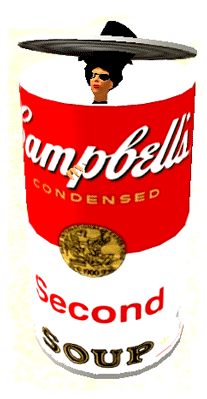
I interviewed Babeli about modernist White Cubes, contemporary Pop-(T)art(s), “Fluxus Hut” pizza toppings and the generally non-lucrative enterprise of performance art in Second Life...
Wirxli: The Second Life art-critic, Lythe Witte has written a previous article for SLatenight magazine called “The White Cube of the Virtual Art Space” where she questions whether or not the modernist white cube gallery model is worth reproducing in Second Life.
You might recall from a few days ago that we were all hanging out together feeling depressed and bored about the fact that even Second Life itself felt like one big and boring white cube.
"...My question is, what kind of methodology do you think is needed to make interesting art that can be comprehended within the unique context of Second Life?
Gazira: To realize an “artistic” or “aesthetic” experience, it requires a frame-space that is contemporarily physical and conceptual; it could be a frame, a museum, a computer network, a bedroom... or just a plain box 'dressed' like a RL art-galley. This referential "cube gallery" reminds me of the ironical artwork made by Marcel Duchamp called "Box in a valise" (Boîte-en-valise, 1942)
Although the "box gallery" could be a valid expression, I prefer thinking the whole SL environment as (a kind of) frame-space. It means that scripted and built objects, avatar-people and their behaviors become essentially parts of the artwork...a "world in a valise", in this case. :)
Wirxli: So there are parallels between the Second Life infrastructure as a kind of “artistic” framing device and the statements made by the early RL performance-art group, Fluxus where they blurred the boundaries between “art” and “life”?
Gazira: Sure, and it is very similar with the Linden's statement: "Your World. Your Imagination". We still don’t understand what “life” is and yet, we are talking about a second one. One life at a time, please! Maybe these lives (RL and SL) are not so different: symbolic abstractions and virtuality are common attributes.
Wirxli: Is there a difference in your mind between "performance art" in SL and "performing arts" (theater etc) in SL? Also, everyone in SL seems to be either intentionally or unintentionally an artist of some sort - in what way does a performance art group like Second Front stand out from the regular surreal, yet routine activities of SL residents?
Gazira: Yes, SL looks like a very democratic kind of theatre. Everyone is an actor, director and audience together. But is that so different from what we call RL? I think that "intention" is the keyword. The artistic goal could be primarily some shared aesthetic way of thinking and it also needs a shared kind of intentions, so I enjoy being part of the Second Front crew. I think Second Front is the first example of Second Life as the embodiment of a "native" artistic proposal..."
From Gaza Stripped by Wirxli Flimflam, Slate.
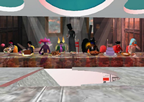
Performance Art for a Virtual World
Aidan: I read on your blog that you're an Alien…
Wirxli Flimflam: Yes I consider myself an alien but at the same time accessible enough to pass for Post-Human ;-)
Aidan: Do people react instinctively to your avatar appearance?
Wirxli Flimflam: Hmmmm..most people are polite, it is always hard to know what people really think. Some have immediate surface reactions though, they can tell right away that I am an artist of some kind, usually.
Aidan: And it's a benefit to Second Front that you all vary in appearance?
Wirxli Flimflam: I have noticed that by instinct, performance artists choose to be Tranny-esque. I like to keep my avatar recognizable. I would like to endorse the meme of brand recognition. Other avatars in the group like to change their appearance, but I am also the PR face of SF so I like to keep things familiar.
Aidan: How did your last performance go at Ars Virtua?
Wirxli Flimflam: No regrets, if that is what you mean, I consider it "early work". We learned a lot from it. Continue reading Performance Art for a Virtual World by Aidan Aquacade, SL Enquirer (scroll down).
Posted by jo at 08:26 PM | Comments (0)
Billions and Billions of Us
Unveiled by his son Nick in a December ribbon cutting ceremony (video above), Carl Sagan now has an official site in Second Life, appropriately shaped like an observatory, with a viewing screen to watch clips of his timeless PBS show "Cosmos", and assorted memorabilia, both enlightening and whimsical-- like a dispenser which disgorges copies of Sagan's trademark turtleneck.
Direct portal to the Sagan memorial here. (Notwithstanding the title's word play, the Sagan site is a creation of The Illusion Factory, a Hollywood effects house which outsources its metaverse development to Ho Chi Minh City, Vietnam-- as documented here.) [blogged by W. James Au on New World Notes]
Posted by jo at 04:43 PM | Comments (0)
January 18, 2007
Second Life Left Unity
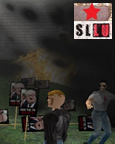
Real Life Fascist Group Recruiting Inworld
"While [Second Life Left Unity] SLLU welcomes the decision of the [Front National] FN to move from Porcupine, this has been to the detriment of the residents of Axel (another PG area). It has broken their peace and tranquility. This fascist group – one so abhorrent that the mainstream conservative party in France urged its supporters to vote socialist in order to ensure the FN didn’t reach any where near to victory in their last elections – has set up recruiting in world. This group is a RL fascist group with links to the very founders of fascism.
SLLU, also condemn this racist party for using SL as a place to recruit - the dissemination of discrimatory racist hate propaganda should be viewed as a violation of SL's community standards' We call on Axel residents to complain about this cabal and their sullying of the tranquil and beautiful area that was once Axel, and join our campaign to rid SL of racism. SLLU support residents in their wish to rid themselves of this group and the protests that have followed. SLLU can promise residents that our organization has no want to stay in Axel any longer than it takes to rid residents of the FN (who are at present trying to buy more Axel land). We reiterate our call on the Lindens to ban this group from PG areas." [via SLLU]
Posted by jo at 04:22 PM | Comments (0)
January 17, 2007
The Greatest Sound Sculptures in the Metaverse
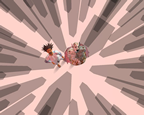
or sounding-out the Metamatic Neighbours
"It’s been over a month now since myself, Jjason Jedburgh, Adam Ramona and Mashup Islander bought a sim together. It is called Marni and is attached to the south of Esperance and is now growing to be a great hive of artistic, business and social activity. I terraformed the island to give the four of us a great environment and some privacy for our various exploits.
...Firstly a little about the Metamatic Collective piece.
Cantata Park 1 by Metamatic is an interactive, spatialised sound sculpture built in Second Life. The sculpture is made from 256 individual nodes in a 16 x 16 grid. Each node is embedded with a single word, triggered by a participant’s movement through the work. Each participant creates a random narrative, assembled on-the-fly, and in real-time. The work explores the possibilities of metaverse art, limitations of Second Life’s construction tools and scripting language, and the ability to appreciate conceptual art by proxy of an avatar. Cantata Park was produced in December 2006 Copyright 2006, Metamatic Collective..." More >> [blogged by Gary Hazlett on Just Virtual]
Posted by jo at 04:33 PM | Comments (0)
Adam Nash

Interactive Second Life Sculpture Park
[left Anahata The Mute Swan by Adam Nash] Adam Nash (Adam Ramona in SL) has been applying his expert real-time 3D artisan skills within Second Life. Based out of Marni Island, Adam has installed a series of interactive and highly immersive audio-visual sculptures that test the limits of SL’s scripting and audio capabilities. His works are important in helping establishing multi-user virtual envoronments (MUVEs) as a sophisticated, collaborative spaces for artists.
Adam and I collaborated on Cantata Park (below), an interactive, cut-up narrative sculpture located on my piece of Marni. The cooprerative build took place over a week or so with only the audio recordings conducted face-to-face. Design, script/audio embedding, testing and fixes all took place via SL and Skype.
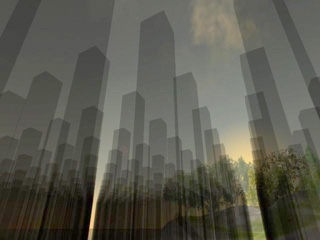
Cantata Park, by Chris Dodds (Mashup Islander in SL) and Adam Nash
More SL sculptures by Adam Nash
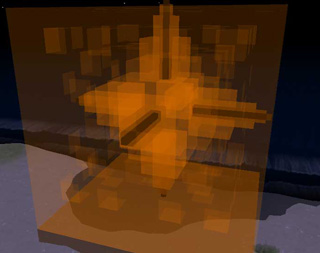
Anahata The Mute Swan
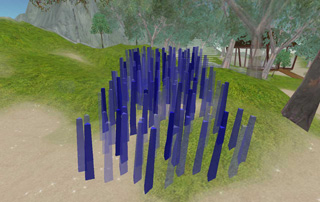
Bell Garden

Blue
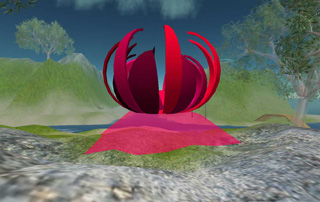
Eudemonia Stallata

Pure Absence
Direct link to Adam’s work: http://slurl.com/secondlife/Marni/220/199/23/
Direct link to christo’s work: http://slurl.com/secondlife/Marni/205/53/25/
Gary Hazlitt publishes the Just Virtual blog and recently interviewed Adam and I regarding the works. [posted by christo Selectparks]
Posted by jo at 04:25 PM | Comments (0)
January 11, 2007
InSense: Interest-based life logging
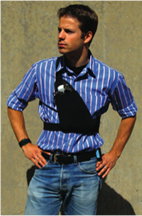
Mapping First Life Experiences with Virtual World Counterparts
Blum, M. Pentland, A. Troster, G. (2006), InSense: Interest-Based Life Logging, IEEE Multimedia, 13 (4), pp. 40- 48.
The paper describes a wearable data collection device called InSense based on Vannevar Bush’s Memex principles. allows users to continually collect their interactions as store them as a multimedia diary. It basically take into account the sensor readings from a camera, microphone, and accelerometers. The point is to “classify the users activities and “automatically collect multimedia clips when the user is in an “interesting” situation“.
What is interesting is the types of categories they picked-up to develop their context-aware framework: they chose location, speech, posture, and activities—to represent many diverse aspects of a user’s context. They also have subcategories (for instance for location: office, home, outdoors, indoors, restaurant, car, street, shop).
The experience sampling approach works like that:
Subjects wear the system for several hours without interacting with it. Audio and acceleration signals are recorded continuously. The camera takes pictures once a minute and WiFi access points are logged to establish location. After the recording session, the user employs an offline annotation tool, which presents an image at a time, the corresponding sound clip, and a list of labels from which to chooseshowing sensor placement.
What is also curious is their description of their algorithm that calculates the current level of interest of an event based on the context classification.
Why do I blog this? I am less interested in the purpose of the system itself (sharing material) but rather by the data extracted from context readings and how this could be used to tell a story (or to build up a narrative). Of course, given my interest in games, I see this device as intriguing and potentially relevant to map the first life experience with virtual worlds counterparts; it could go beyond current pedometer that control dogs. [blogged by Nicolas on pasta and vinegar]
Posted by jo at 02:34 PM | Comments (0)
December 20, 2006
Transit
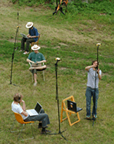
Mental Maps and the Networked Urban Space
Transit by KLAUS FILIP & NICOLAJ KIRISITS :: There is no doubt that within a few years urban space will be fiilled up with invisible data. Digital Communities will be located in real space. The internet will be extended by a geospatial network. All you'll need is a mobile interface (cellphones) to get involved with the communities / information / networks at certain places within the city. But what does that mean for the face of the city?What kind of mental map will we have from the geospatial networked based urban space?
As Kevin Lynch (1960, the image of the city) researches the legibility of urban space, Transit tries to find out the legibility of digital communities in urban spaces. For that proposition we built up an example of this digital urban space on a free field at the Kleyehof (Burgenland) with 25 invited Media artists. The Elements of that digital sculpture were text, video, sound and digital code, spatial located by using gps tools. The grid elements could be connected, to set up different networks.
The Objects are based on a spatial Masterplan, situated in a 3D grid of 1 to 1 to 1 meter; 20 meters long, 20 meters wide and 3 meters high), which defines private area (everyone can see-hear what you do but only you can change it), public (everyone can schange the data), and free spaces.
Transit was part of the podspot project at the University of applied arts vienna / department of digital art. [via Rhizome]
Posted by jo at 04:34 PM | Comments (0)
December 18, 2006
danah boyd

on being virtual
Lately, i've become very irritated by the immersive virtual questions i've been getting. In particular, "will Web3.0 be all about immersive virtual worlds?" Clay's post on Second Life reminded me of how irritated i am by this. I have to admit that i get really annoyed when techno-futurists fetishize Stephenson-esque visions of virtuality. Why is it that every 5 years or so we re-instate this fantasy as the utopian end-all be-all of technology? (Remember VRML? That was fun.)
Maybe i'm wrong, maybe i'll look back twenty years ago and be embarrassed by my lack of foresight. But honestly, i don't think we're going virtual.
There is no doubt that immersive games are on the rise and i don't think that trend is going to stop. I think that WoW is a strong indicator of one kind of play that will become part of the cultural landscape. But there's a huge difference between enjoying WoW and wanting to live virtually. There ARE people who want to go virtual and i wouldn't be surprised if there are many opportunities for sustainable virtual environments. People who feel socially ostracized in meatspace are good candidates for wanting to go virtual. But again, that's not everyone.
If you look at the rise of social tech amongst young people, it's not about divorcing the physical to live digitally. MySpace has more to do with offline structures of sociality than it has to do with virtuality. People are modeling their offline social network; the digital is complementing (and complicating) the physical. In an environment where anyone _could_ socialize with anyone, they don't. They socialize with the people who validate them in meatspace. The mobile is another example of this. People don't call up anyone in the world (like is fantasized by some wrt Skype); they call up the people that they are closest with. The mobile supports pre-existing social networks, not purely virtual ones.
That's the big joke about the social media explosion. 1980s and 1990s researchers argued that the Internet would make race, class, gender, etc. extinct. There was a huge assumption that geography and language would no longer matter, that social organization would be based on some higher function. Guess what? When the masses adopted social media, they replicated the same social structures present in the offline world. Hell, take a look at how people from India are organizing themselves by caste on Orkut. Nothing gets erased because it's all connected to the offline bodies that are heavily regulated on a daily basis.
While social network sites and mobile phones are technology to adults, they are just part of the social infrastructure for teens. Remember what Alan Kay said? "Technology is anything that wasn't around when you were born." These technologies haven't been adopted as an alternative to meatspace; they've been adopted to complement it.
Virtual systems will be part of our lives, but i don't think immersion is where it's at. Most people are deeply invested in the physicality of life; this is not going away. [blogged by zephoria on apophenia]
Posted by jo at 05:50 PM | Comments (0)
November 25, 2006
Second Life: The Official Guide
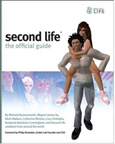
Second Life Gets a Paper Book
Second Life has been on Techmeme a lot lately. Most of this has been about the continuing inroads that larger companies like Dell and Reuters have made into the world. Some of it has been about strife within the world due to things like land price increases and copybot (a recently released program that can copy any artifact in world; BoingBoing has a good piece discussing the issues).
The latest splash is a physical book, entitled Second Life: The Official Guide, that is now available on Amazon. As the documentation for the world moves off the web it becomes more accessible and even *more* people will join.
"Second Life: The Official Guide is the perfect book for anyone interested in Linden Lab’s fascinating Second Life metaverse. It explores in detail every aspect of Second Life’s rich and multilayered virtual world, explains how it works, and offers a wealth of information and practical advice for all Second Life residents. The first part, “Getting a Second Life,” acquaints potential and new players with the Second Life world. It describes the metaverse’s geography as well as its society, explaining its written and unwritten rules. The second part, “Living a Second Life,” deals with the practical and economic aspects of Second Life: creating and customizing an avatar, building objects, scripting, and making money. The third part of the book, “Success in Second Life,” discusses ways to enjoy Second Life more. It includes profiles of successful Second Life residents, discusses fascinating in-world events, and examines how some are using Second Life for business, training, and other purposes. The book closes with a glossary as well as quick-reference and additional-resources appendices. The book's CD includes special animations, character templates, and textures created by Linden Lab exclusively for this book. The disc also guides new users through the installation and includes a code that grants a special object the first time they enter the metaverse." [blogged by Brad Forrest on O'Reilly Radar]
Posted by jo at 04:26 PM | Comments (0)
Second Life Copybot
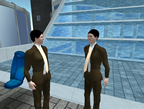
Investing Time and Money in Virtual Worlds
"In the last month something happened that shook the world to its core. It was the sudden appearance of the capability to instantly replicate three-dimensional objects, suddenly in the hands of the common people. Everyone’s intellectual property was up for grabs, and the very notion of manufacturing under attack. Small business owners who relied on handcrafting luxury goods found themselves completely vulnerable to perfect knockoffs...
Microtransactions for digital assets and virtual goods is a rising, potentially multibillion dollar industry. To succeed, entrepreneurs who are building networked systems based on user content (be they citizens of Second Life or the makers of virtual worlds themselves) must realize that anything displayable is copyable; the value lies instead in service and in server-side functionality. Content is like songs around a campfire: destined to be enjoyed for free. Those who build businesses around hosting campfires would be wise to focus on making the campfire experience great, rather than charging listeners by the song." From Investing time and money in virtual worlds: Caveat Emptor by Raph Koster, Venture Beat. [via]
Also:
"...[Linden Lab] plans to develop an infrastructure to enable Second Life residents and landowners to enforce IP-related covenants within certain areas, or as a prerequisite for joining certain groups. In effect, Second Life's inhabitants will self-police their world, according to rules and social norms they develop themselves." From Second Life Will Save Copyright by Jennifer Granick, Wired.
Posted by jo at 04:16 PM | Comments (0)
November 16, 2006
Second Life
COPYING A CONTROVERSY
"...The hack suggested a way of finally introducing AIs and non-player characters into the world, creating endless possibilities for game development, simulation, and more, but that wasn’t even the coolest part. Because not only had they figured out a way of introducing artificial avatars, they’d also hacked up a way of cloning existing avatars, clothes included. Not just one or two clones, but over a dozen, dropping out of the sky like godspawn.
Edited in double-time, this video demonstration features me, Talila Liu, and Gwyneth Llewelyn and our several dozen doppelgangers..." From COPYING A CONTROVERSY (Updated) [blogged by W. James Au on New World Notes]
Posted by jo at 07:31 PM | Comments (0)
November 15, 2006
Opening at Ars Virtua Tonight

13 Most Beautiful Avatars
13 Most Beautiful Avatars by Eva and Franco Mattes (a.k.a. 0100101110101101.ORG) :: Curated by Marisa Olson :: Nov. 15 - Dec. 29, 2006 at Second Life's Ars Virtua gallery. Nov. 30 - Dec. 19, 2006 at The Italian Academy, Columbia University (NYC).
"13 Most Beautiful Avatars" is the newest installment of Time Shares, a series of online exhibitions co-presented by the New Museum of Contemporary Art and Rhizome.org, in conjunction with Rhizome's "Tenth Anniversary Festival of Art & Technology". The exhibition, in Second Life's increasingly popular Ars Virtua gallery — a virtual nonprofit arts organization — will mirror the art gallery in which the newest work by Italian artists Eva and Franco Mattes (a.k.a. 0100101110101101.ORG) is being exhibited.
The Matteses have been living in the virtual world, Second Life, for over a year, exploring its terrain and interacting with its peculiar inhabitants. The result of their "video-game flanerie" is a series of portraits, entitled "13 Most Beautiful Avatars". Not unlike Warhol's entourage of stars, captured in the "13 Most Beautiful Boys" and "13 Most Beautiful Women" portrait series emerging from his famous Screen Tests, the Matteses' "13 Most Beautiful Avatars" captures the most visually dynamic and celebrated "stars" of Second Life.
The portraits reflect Second Life aesthetics, featuring the bright colors, "artificial" light, broad flat areas, 3D shapes, and surreal perspectives that are typical of this virtual world. Overall, the series draws on the technological developments which allow the creation of alternate identities within simulated worlds, and questions the impact such technologies have on art and society. Despite the relative newness of using video game-derived source materials, the avatars' icons recall questions common to earlier eras of portraiture, including the cultural and psychological context of the images, and the relationships between high art and subculture, between contemporary art and "traditional" art forms, and between art and life itself.
Eva and Franco Mattes are known for their controversial artworks, including staging high-profile hoaxes and defeating the Nike Corporation in a legal battle for a fake advertisement campaign. They are the recipients of the 2006 "Premio New York" grant, sponsored by the Italian Ministry of Foreign Affairs and the Italian Cultural Institute, New York. Their real-world exhibit takes place at the Italian Academy at New York's Columbia University, and a 3D replica of this physical exhibition space has been recreated for presentation of an exhibition identical to the "real" one, at Ars Virtua.
The Second Life / Ars Virtua show is open November 15 - December 29, and the Italian Academy show is open November 30 - December 19. The Ars Virtua exhibit will be launched with an in-world opening reception on November 15, from 6-8pm SLT/9-11pm EST, here: http://slurl.com/secondlife/dowden/42/59/52/?title=Ars%20Virtua
Info:
http://rhizome.org/events/timeshares
http://www.0100101110101101.org
Downloadable images: http://www.0100101110101101.org/home/portraits/thirteen.html
Posted by jo at 10:55 AM | Comments (0)
November 13, 2006
Char Davies
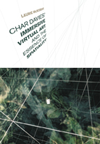
Immersive Virtual Art and the Essence of Spatiality
Char Davies' Immersive Virtual Art and the Essence of Spatiality by Laurie McRobert :: In this first book-length study of the internationally renowned Canadian artist Char Davies, Laurie McRobert examines the digital installations Osmose and Ephémère in the context of Davies’ artistic and conceptual inspirations. Davies, originally a painter, turned to technology in an effort to create the effect of osmosis between self and world. By donning a head-mounted display unit and a body vest to monitor breathing and balance, participants are immersed in 3D-virtual space where they interact with abstract images of nature while manoeuvring in an artificial spatial environment.
Char Davies’ Immersive Virtual Art and the Essence of Spatiality explores spatiality through a broad scope of disciplines, including philosophy, mythology, biology, and visual studies, in order to familiarize the reader with virtual reality art – how it differs from traditional artistic media and why immersive virtual art promises to expand our imaginative horizons. This original study provides us with an important exposition of two of Char Davies’ acclaimed projects and an exploration of the future impact of digital virtual art on our worldviews.
Laurie McRobert is an independent scholar and a former lecturer in the Department of Philosophy at McGill University and the Thomas More Institute for Adult Education.

Virtual Space
"What I am trying to translate to you is more mysterious; it is entwined in the very roots of being, in the impalpable source of sensations." - J. Gasquet, Cezanne, quoted by Merleau-Ponty, 'Eye and Mind'.
I have been working in "virtual space" for nearly 10 years, and during that time have produced two major works, the virtual environments Osmose (1995) and Ephémère (1998) [1]. Integrating full body immersion, interactive 3-D digital imagery and sound, and navigation via a breathing interface, these works embody a radically alternative approach to immersive virtual space, or what is commonly known as "virtual reality" or "VR". Rather than approaching the medium as a means of escape into some disembodied techno-utopian fantasy, I see it as a means of return, i.e. of facilitating a temporary release from our habitual perceptions and culturally-biased assumptions about being in the world, to enable us, however momentarily, to perceive ourselves and the world around us freshly.
[1] Osmose (1995) and Ephémère (1998) were constructed with the dedicated participation of the following individuals: John Harrison, custom programming; Georges Mauro, graphics; Dorota Blaszczak, 3-D sonic architecture; and Rick Bidlack, sound composition.
It should be noted that when I say virtual space, I am referring to immersive virtual space, i.e. a computer-generated artificial environment that one can seemingly, with the aid of various devices, go inside. I think of virtual space as a spatiotemporal "arena" wherein mental models or abstract constructs of the world can be given virtual embodiment (visual and aural) in three dimensions and be animated through time. Most significantly, these can then be kinesthetically explored by others through full body immersion and real-time interaction, even while such constructs retain their immateriality. Immersive virtual space is thus a philosophical and a participatory medium, a unique convergence in which the immaterial is confused with the bodily-felt, and the imaginary with the strangely real. This paradox is its most singular power. The firsthand experience of being bodily immersed in its all-encompassing spatiality is key: when combined with its capacity for abstraction, temporality, and interaction, and when approached through an embodying interface, immersive virtual space becomes a very potent medium indeed.
Between 1995 and 2001, more than 20,000 people have been individually immersed in the virtual environments Osmose and Ephémère. A common response to the experience is one of astonishment: many "immersants" have described their experience in euphoric terms while others have inexplicably wept. As one participant wrote six months afterwards: '[This experience] heightened an awareness of my body as a site of consciousness and of the experience and sensation of consciousness occupying space. It's the most evocative exploration of the perception of consciousness that I have experienced since I can’t remember when.'
Such responses suggest that immersive virtual space, when approached in an unconventional way, can indeed provide a means of perceiving freshly. The medium’s paradoxical qualities may effectively be usedto redirect attention from our usual distractions and assumptions to the sensations of our own condition as briefly embodied sentient beings immersed in the flow of life through space and time." Continue reading Virtual Space by Char Davies. Published in SPACE in Science, Art and Society. François Penz, Gregory Radick and Robert Howell, eds.; Cambridge, England: Cambridge Universty Press (2004), pp. 69-104, illus.
Posted by jo at 05:33 PM | Comments (0)
October 31, 2006
Synthecology
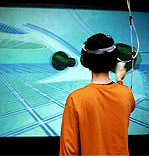
A Tele-Immersive Collaboration
Synthecology combines the possibilities of tele-immersive collaboration with a new architecture for virtual reality sound immersion to create a environment where musicians from all locations can interactively perform and create sonic environments.
Compose, sculpt, and improvise with other musicians and artists in an ephemeral garden of sonic lifeforms. Synthecology invites visitors in this digitally fertile space to create a musical sculpture of sythesized tones and sound samples provided by web inhabitants. Upon entering the garden, each participant can pluck contributed sounds from the air and plant them, wander the garden playing their own improvisation or collaborate with other participants to create/author a new composition.
As each new 'seed' is planted and grown, sculpted and played, this garden becomes both a musical instrument and a composition to be shared with the rest of the network. Every inhabitant creates, not just as an individual composer shaping their own themes, but as a collaborator in real time who is able to improvise new soundscapes in the garden by cooperating with other avatars from diverse geographical locations.
Virtual participants are fully immersed in the garden landscape through the use of passive stereoscopic technology and spatialized audio to create a networked tele-immersive environment where all inhabitants can collaborate, socialize and play. Guests from across the globe are similarly embodied as avatars through out this environment, each experiencing the audio and visual presence of the others.

Participants from the WWW use a browser interface to contribute sound elements to the garden environment for use as compositional items. All the while, this real-time composition is streamed through web broadcast of the virtual environment to illustrate the audio-visual transformation of the garden. Broadcast throughout the entirety of the festival, Synthecology will celebrate the possibilities of collaboration, improvisation, and distributed authorship that exist on the horizon of an increasingly interconnected world.
As current advances in networking become commonplace, the creation of collaborative environments connecting remote individuals will become less involved. By augmenting the possibilities for users to share sensory presence through tele-immersive interfaces, Applied Interactives intends to combine the possibilities of real-time collaboration and socialization with the dynamics of digital creation and manipulation. Synthecology is a speculative glance at how the technology of today may be utilized to create new autonomous zones for sampling & re-mixing culture.
COLLABORATORS
Synthecology is being created as a collaboration of students and faculty from the Electronic Visualization Laboratory at the University of Illinois at Chicago, The School of the Art Institute of Chicago, and Columbia College Chicago, and art(n) through the Applied Interactives organization.
ABOUT APPLIED INTERACTIVES
The purpose of Applied Interactives, NFP is to educate the art and science community about the medium of Virtual Reality as an interactive, computer-generated, immersive computer graphics environment. Applied Interactives, NFP plans to advance the medium through research and experimentation as well as provide a bridge to bring the technology out of institutional labs and into more publicly accessible arenas. Applied Interactives, NFP intends to propagate the medium by providing support and direct access to the resources necessary for artists and scientists to exhibit and develop works in the medium.
Posted by jo at 03:44 PM | Comments (0)
Yahoo! Time Capsule

Add Second Life Pics
The Electric Sheep Company (sponsors of this blog) are holding an event this Thursday and Friday, October 26-27, that will collect screenshots and text from the virtual world of Second Life for inclusion in the Yahoo! Time Capsule project, which will be sealed on November 8 and re-opened in the year 2020. That’s pretty cool (and Yahoo!’s Web site is cool as well). One thing strikes me, though. Why aren’t there 3D models being included in the time capsule? It’s not a particular failure of vision on Yahoo!’s part; it probably has more to do with the fact that there’s not yet a standard for such objects, nor can you export such information out of Second Life in a way that’s supported by the company and intelligible to other applications. Virtual 3D objects are not yet widely and easily manipulable, as, say, a chunk of html code is, or a jpeg file. The problem runs far deeper than the technological; the absence of a standard or other open system or protocol means that many people don’t think of the virtual world as just another part of the rest of their lives. When an online world can reach out to and communicate easily with many other online platforms, we’ll start to see more constructive attention being paid. It’s almost as if we’re now at 3pointD v1.0. Personally, I’m looking forward to 3pointD 2.0. If that makes any sense at all. [posted by Mark Wallace on 3pointD]
Posted by jo at 03:15 PM | Comments (0)
Help the Electric Sheep Destroy Television
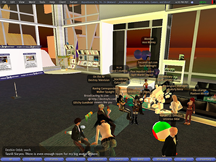
A User-Controlled Photo Documentary of Second Life
If you didn’t show up to the Second Life Herald’s third birthday party tonight, you missed quite a show. Even if you weren’t in the virtual world of Second Life, though, you may have caught the bash on Destroy Television, the new service from the Electric Sheep Company’s spare-time dev pool, Sheep Labs. Check out the Destroy Television avatar in the screenshot above. She looks innocent enough (even though she appears to be mooning the camera), but Destroy is an avatar of unique stripe; she’s controlled for the most part by users dialling over to the Destroy TV Web site, where they can make her chat or walk around. All the while, she snaps a pic every 30 seconds or so and plugs it into her Flickr page. The result is a user-controlled photo documentary of what’s going on around Second Life. More >> [posted by Mark Wallace on 3pointD]
Posted by jo at 03:06 PM | Comments (0)
October 27, 2006
Art and Aporia: Imaging Place
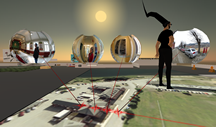
Interview with JC Fremont (aka John Craig Freeman)
JC Fremont: I am considering your two pieces on the white cube (part 1 and part 2 ) and my feeling is that if it looks like art then it probably isn't art.
Lythe Witte: interesting!
JC Fremont: In RL but especially here in SL.
I asked JC Fremont to elaborate via email: “Well art that imitates art in the real world is repugnant. SL art that imitates RL art is irrelevant. Okay a painting served the ideology of 20th century consumer capital society. It became the ultimate commodity object. More profitable than gold or plutonium. Remember that art before the rise of commodity capital was sight specific. It resided in the cathedral or on the cave wall. No way to buy and sell. What could possibly be the purpose of making cartoon representations of paintings in a virtual environment? Art should be unrecognisable as such. In electrate culture the forms will change drastically. We don't know what electrate art will be yet. First, Electrate art will have no object, evade commodity consumption. If it can be commodified then it is not good electrate art. Second, never finished it will always be in a state of becoming, upgrading. Art needs to disrupt.” Continue reading Art and Aporia: Imaging Place by Lythe Witte.
Posted by jo at 10:42 AM | Comments (0)
September 26, 2006
Four Eyed Monsters
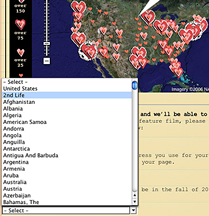
NATIONAL RECOGNITION FOR SECOND LIFE
I'm perhaps the last SL blogger to pump this charge, but if we can at least get a scruffy pair of indy filmmakers to acknowledge Second Life as a country, might as well keep the blogswarm going. Here's the deal: Four Eyed Monsters is a cool-looking quasi-documentary from a hipster couple who've turned their relationship into a feature film. In true Web 2.0 fashion, they're planning a tour of the movie across the US and the globe, but to get them to come to your town (or country), you need to put in a request. (Over 150 requests, and they put your place on the tour.) True to form, the Electric Sheep's SNOOPYBrown Zamboni engaged the filmmakers and got them to add Second Life as a country on the request page. So there we are, in between the US and Afghanistan-- which is, when you think about it, probably the best place for Second Life to be. With enough requests, the filmmakers will bring their tour to SL. (Here's Mr. Brown's original write-up on the campaign. And props to Akela Talamasca of SL Insider for the screen grab.) [blogged by Wagner James Au on New World Notes]
Posted by jo at 05:02 PM | Comments (0)
September 22, 2006
Breaking the Game

THE VIRTUAL WORLDS OF WORKSPACE UNLIMITED
On the periphery of a multi-billion dollar global computer gaming industry exists an emerging group of impassioned artists, architects, filmmakers, and game enthusiasts who mine, recycle, and modify off-the-shelf videogames and multiplayer virtual worlds with unexpected and sometimes extraordinary results. Conflating the practices of consuming and producing in sometimes-uneasy ways, they exploit the tools, software code, graphics, and even the programming errors of the most popular videogames to fashion new cinematic forms (Machinima), soundscapes, interactive performances, talk show formats, and art installations. Breaking the Game: The Virtual Worlds of Workspace Unlimited [PDF] :: Text by Wayne Ashley, screen Captures and Photos by Thomas Soetens and Kora Van den Bulcke.
You can also check out the results of a first-iteration telematic symposium Wayne Ashley curated and co-organized with Workspace Unlimited called Breaking the Game. The symposium opened up the art of game modification to the contingencies of everyday life, where interactive technologies increasingly mediate physical spaces and human movements in very complex and dynamic ways. The symposium themes were: Hybridity, Overclocking the City and The Virtual as Interface to Self and Society. I asked participants to consider gaming and other virtual technologies in relationship to building and designing cities, navigating and experiencing urban life, constructing identities, and creating and maintaining social interaction. The symposium encouraged debate and discussion through multiple formats including text, desktop video conferencing, Skype, images, and animation. Several informal sessions took place inside of Second Life where participants gave tours and discussed their projects inside the 3D multi-user world.
Posted by jo at 03:46 PM | Comments (0)
Christy Dena in SLATE Magazine
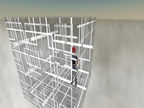
The Art Space in Virtual Worlds
My latest articles in SLATE Magazine explore the notion of the art space in virtual worlds. In part one I analyse how some spaces are remediations of the real world and then in part two I pose ideas about what would be the ‘white cube’ equivalent (the ideal environment to experience art) in a virtual world. I’ve opened up a forum thread at the end so anyone can add their own thoughts. In this 2nd issue of SLATE are reviews of art festivals and galleries in SL, an interesting article about a theatre production in SL by Anya Ixchel (Angela Thomas in RL) the editor of SLATE, and the second installment of the backbackers guide to SL: Sim Trekker. I love the idea of the last one: getting around SL on a budget! Anyway, there is plenty more: talk about the notion of identity in SL, relationships, science fiction and so on. Enjoy! [blogged by Christy Dena on WRT]
Posted by jo at 02:06 PM | Comments (0)
September 18, 2006
Connecting Worlds

Creative Possibilities of the Networking Age
09.15-11.26.06 :: Connecting Worlds, the first exhibition after the renewal of NTT InterCommunication Center[ICC] focus on the "communication", with contributions exploring the creative possibilities that emerged out of the new environments of the networking age.
'As the first exhibition since the reopening of ICC, this show raises-from the horizons of art and programming-practical alternative possibilities of various phases of communication that we currently see around us. This exhibition features artwork and projects that take a unique step into contemporary networks, politics, economies, physiology, or urban environments by manipulating sound, games, the Internet, or other media as well as foreseeing artwork created in the past.' Yukiko Shikata, curator
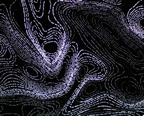
cyclone.soc by Gavin BAILY + Tom CORBY, UK 2005 :: CYCLONE.SOC brings together two contemporary phenomena: (1) severe weather, the project uses weather data that charts the emergence and progress of hurricanes; (2) the polarized nature of debate that occurs in certain online newsgroup forums. The project maps textual conversation taken from the political and religious newsgroups to the isobars of a dynamic, interactive weather visualization of hurricanes - whose complex structures are used to visualize the conversational churn and eddies of the newsgroup conversations.
In staging these interactions as a process of meteorological precipitation, newsgroup conversations "condense" in the works environment as a temporal ambient patterning - a structuring that acts not only as a metonym of difference, but of ideological tensions which mirror the dynamics of social space. CYCLONE.SOC is a navigable environment that gives the user the ability to zoom in or out and skate across and through the cyclonic weather formations in order to read or be immersed in the newsgroup text.
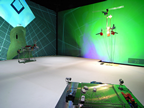
OBJECT B by exonemo, Japan 2006 :: OBJECT B 2006 Yamaguchi Center for Arts and Media (YCAM) YCAM InterLab Installation presenting a modified first-person 3-D shooting game with kinetic objects and a virtual-reality setting. Installed inside the three-dimensional environment created through projections onto all four walls of the exhibition space, are three objects made of keyboards, mice, and other computer parts and electric tools, and a control terminal for players. The robots' (programmed) frequent violent actions trigger automatic commands, according to which the game develops.
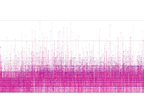
MaSS (Market as Speed Spectra) by MaSS Dev., Japan 2006 :: In e-trade, there are cases in which up to 1,000 "ticks" (contracts made when seller and buyer agree on a price are being counted per second?DThis work extracts log data of daytrade, where instantaneous decisions are being made based on numbers displayed on the computer monitor?Cand transforms the speed and rhythm of such transactions into sound and light. "MaSS" likens the steady high-speed exchange of data in e-banking to a worldwide network of reflex nerves.
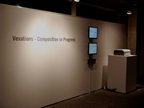
Vexations-c.i.p. (Composition in Progress) by MOHRI Yuko + MIHARA Soichiro, Japan 2005 :: "Vexations - c.i.p.(Composition in Progress)" 2006 transmediale 06, Berlin This work presents "Vexations", an odd piano piece of a single phrase repeated 840 times, originally composed by Erik Satie in the late 19th century, interpreted through an automatic, computer-controlled looping system. While incorporating modifications caused by data of environmental noises recorded with microphones at the venue, the software automatically generates new scores, based on which the piece gradually changes as the performance continues.
Artists include: ambientTV.NET (AT/IN/UK) / Wayne CLEMENTS (UK) / Robert DAVIS + Usman HAQUE (UK) / exonemo (JP) / Peter FISCHLI & David WEISS (CH) / Muntadas (UK/SP) / MaSS Dev. (JP) / MOHRI Yuko + MIHARA Soichirou (JP) / Newtype Technology Lab. (JP) / Dennis OPPENHEIM (UK) / Manuel SAIZ (UK/SP) / TANO Taiga (JP).
Posted by jo at 04:18 PM | Comments (0)
MTV's Virtual Laguna Beach

Not in the Real World Anymore
September 18, 2006 :: Not in the Real World Anymore by RICHARD SIKLOS, The New York Times.
At MTV, reality has always been a moving target. Sixteen years ago, the network heralded the era of reality television with “The Real World.” Three years ago, it pushed the genre further with “Laguna Beach: The Real OC,” in which the mundane lives of a clique of pretty teenagers were presented in a way that appeared scripted and dramatic.
Now the cable channel aims to push the boundaries of false reality one step further. This week, MTV will introduce Virtual Laguna Beach, an online service in which fans of the program can immerse themselves — or at least can immerse digitized, three-dimensional characters, called avatars, that they control — in virtual versions of the show’s familiar seaside hangouts. “You can not only watch TV, but now you can actually live it,” Van Toffler, the president of the MTV Networks Music, Film and Logo Group, said in an interview.
Wednesday’s introduction of Virtual Laguna Beach is the first of three virtual worlds that MTV plans over the next year as part of an effort to steal a march on popular Web sites like MySpace and YouTube that have diverted the attention of the MTV audience. ... Of the two other virtual worlds planned, VMTV is a music destination where visitors can club-hop among hip neighborhoods, buy music, watch videos, sing karaoke or even start their own bands. The third virtual destination, LogoWorld, an offshoot of Logo, the gay and lesbian cable channel, will be designed entirely by its participants.
While avatars and virtual communities are a puzzling concept to many people over, say, 35, they are old hat to players of video games and to young people accustomed to revealing details of their lives online through social networking Web sites. Avatar-based social Web sites like Sims Online, Second Life and There.com have attracted hundreds of thousands of users.
[...]
“Our content is a starting point for them, not an ending point,” said Jeffrey B. Yapp, an MTV Networks executive who helped oversee the project. “There’s been a lot of discussion about letting go.”
[...]
To design Virtual Laguna Beach and the other forthcoming 3-D online communities, MTV enlisted Makena Technologies, the creator of There.com. Henry Jenkins, a professor at M.I.T. and the author of “Convergence Culture,” said such virtual communities were a natural next step for mainstream media companies seeking to deepen their connections to fans.
He said “Laguna Beach” was an interesting choice for the first venture because it had a heavily female audience and because the show itself was such a blur of real, unreal and sort of real. “It’s just layer upon layer of reality and fiction,” Mr. Jenkins said.
Some 22,000 people, drawn from a pool of 600,000 “Laguna Beach” watchers who registered for fan clubs on other MTV Web sites, signed up to participate in the test phase of Virtual Laguna Beach. Several hundred of those are designated as volunteer “lifeguards” who greet new arrivals online.
Cast members from the television show’s three seasons are not part of the planned online experience, although they could come as avatars of their own making.
Visiting Virtual Laguna Beach requires registering at the Web site, www.vlb.mtv.com, and downloading a piece of software. The first step is designing your avatar — which can be made to look as much like or unlike your actual self as you wish. During a demonstration last week at MTV, Mr. Bostwick played the role of an avatar named Violet Jade whom he configured — scrolling through an extensive menu of eye shapes, hair colors, skin tones and so on — to look like a typical character on the show: blond, tan and scantily clad.
[...]
“MTV speaks uniquely to a group of people who are endlessly fascinated with watching themselves,” she said.
Posted by jo at 09:53 AM | Comments (0)
September 15, 2006
Mark Wallace

LonelyGeeks, LifeLogs and Four Eyed Monsters
A few of us from the Brooklyn metaverse crowd went to see Four-Eyed Monsters last night, a very interesting feature film about a young New York couple who end up documenting their every move via videotape and handwritten notes, only because they’ve decided not to actually speak to each other. While the film is not a documentary, it was made by the couple who it’s about, and their real lives and dramatized lives do begin to converge toward the end of the film. While it’s a movie about relationships (you know, the kind where two people “slowly start to meld into one beast that has 2 mouths, 4 eyes and 8 limbs and takes up 2 seats on the subway!!!”), it’s in greater measure a movie about the act of recording itself, and what it means at a moment in history when you can store, play back and share as much of your life as you like, with as many people as are willing to pay attention. In this case, Susan and Arin have created a virtual version of their real life together, and it’s interesting to ask what the differences between the two may be, if any — especially in light of similar trends in things like lifelogging, and in the fictionalization of a life like lonelygirl15’s. And if you stay with this long-winded post all the way to the end, you get to think about how this kind of logging of our lives might help enhance them in some future 3pointD world.
“How long can their relationship survive as an art project???” asks the Four Eyed Monsters Web site. But that doesn’t describe everything that’s going on here. There’s an art project unfolding, but there’s a relationship too. Are they the same thing? Does the art project follow the course of the relationship, or is the relationship subservient to the art project? The truth is probably somewhere in between: you can’t separate the relationship from the art project; at some level, the relationship is the act of documenting itself. A more interesting question might be, “How long could their relationship survive if it stopped being an art project?”
The documented life got some attention recently with the stellar rise of lonelygirl15, who appeared to be recording her days via a video diary on YouTube. Except that lonelygirl15, who’d garnered millions of fans in the four months she’d been videoblogging herself, turns out to be the construct of a couple of young California filmmakers. “Bree” was a totally fictional character, but it’s interesting to ask how the fictional Bree differs from the fictionalized Susan and Arin. Four Eyed Monsters is composed for the most part not of documentary footage but of re-enactments. (And in any case, what does it mean to re-enact what was in part acted out in the first place?) Are the characters of “Susan” and “Arin” that appear on the screen somehow qualitatively different from the character of “Bree” that appears in the YouTube videos? Are they all virtual people, or do Susan and Arin have some deeper gravitas for being based on their actual counterparts? And isn’t Bree, the lonely teenager, based on an actual archetype? Does that make her any “more fictional” than the characters in the film? Or is that like being “more pregnant”?
One of my favorite ideas is the impossibility of autobiography: you can’t ever really give an accurate account of yourself and your history; there are just too many intangibles of memory, bias and emotion that get in the way. Four Eyed Monsters is only one version of the lives of Arin and Susan. Cut together differently, the film could have given a very different impression, or examined some other aspect of what it’s like to come together in the way they have. You can’t present all views at once, and any one view leaves out some amount of information. (There’s a 3pointD uncertainty principle here that I’ll post about at some point in the future.)
Lately, though, some people have been looking for ways to capture their lives in as much detail as possible, using the tools of the information age. While the Internet and digital media make recording the scenes of one’s days far easier than it has been before, they also make possible, at least in theory, a detailed quantification of one’s life that could potentially be very useful in a future metaversal age.
One failed version of this is the now-discontinued LifeLog program of the Department of Defense. “The LifeLog capability would provide an electronic diary to help the individual more accurately recall and use his or her past experiences to be more effective in current or future tasks,” according to DARPA’s description. “The goal of the LifeLog is to turn the notebook computers or personal digital assistants used today into much more powerful tools for the warfighter.”
That program is no more, but into the breach has stepped ur-blogger Justin Hall, who’s been looking at “Passively Multiplayer Online Games” in recent months. (We first blogged about this back in June.) Basically, a PMOG, in Justin’s early conception, logs all your Internet activity and assigns scores based on various factors such as which and what kind of sites you visit, for how long, and what you do there, etc. It’s not very far advanced beyond an idea, but a kind of proof-of-concept version of Justin’s game is online, where you can see how surfing various sites might raise or lower various attributes that are used to describe your avatar in the game.
It’s interesting to contemplate what it might be like to compare the fictionalized self created by such a game to the real person who plays it. But this kind of lifelogging can be taken a giant step further and allowed to bleed out into the real world, where it could become really useful (or really scary, depending on who’s doing the logging).
It already happens on the Web all the time: the recommendations you get from Amazon or NetFlix and the targeted ads in your Gmail sidebar all work off subsets of the lifelogging idea. Amazon, NetFlix and Google log your activity on their sites, and use that information to point you toward things that are in line with the preferences you’ve shown in the past.
Now extend that idea to all areas of your life. Imagine if, after you’d used FreshDirect for a while, it started automatically ordering and delivering your food for you, based on the orders you’d placed in the past. Now knock down the walls between FreshDirect’s information and the information gathered by NetFlix, and it might even tweak your delivery based on what kind of movies you’d ordered that week. (Popcorn and chocolate for the chick flicks, Red Bull for the slasher movies?) Now imagine you’re sharing all this information — travel itineraries, iTunes playlists, anything else you care to name — with a whole bunch of other people, much as Susan and Arin shared the moments of their lives.
I’ll let Jerry contemplate the ramifications of videologging (no “b” here) one’s life for all to see. Logging the data of your every move, though, could get interesting. Vernor Vinge mentioned the potential opportunities that are opened by this in his keynote speech at the end of the recent Austin Game Conference. Vinge envisioned “lifestyle cults” that gather and share their information in order to garner favorable terms in whatever context. If 1,600 other people in your neighborhood all order Red Bull on the weekends, for instance, you ought to be able to leverage that into a discount. Things like that seem to be the gist of Vinge’s thinking here.
If it sounds outlandish to be sharing so much information with so many other people, consider the fact that Web 2.0 has pushed us much further in that direction than almost anyone thought we would head. On Flickr, YouTube, Blogger and so many other sites, we offer up personal information about our habits, thoughts, purchases and selves every day — many times a day, in fact. One of the ideas behind lifelogging is simply that you as an individual would be able to aggregate all that information in a single place. Without revealing anything more than you’re already putting out there, you’d immediately have a powerful resource for doing things like making decisions, making friends, making new discoveries, you name it.
Me, I’ve shared enough in this post already. (1,400 words!) See you — or some version of you, at least — at the movies. [blogged by Mark Wallace on 3pointD]
Posted by jo at 04:55 PM | Comments (0)
September 14, 2006
Fabjectory
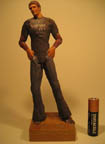
New 3D Printing Service For Second Life Objects
The excellently named Fabjectory is the latest service offering to produce a physical model of an object that exists only in the virtual world of Second Life. For $75 and up, you can get a 3D model of your avatar, complete with detailed color textures applied. The project comes from one Michael Buckbee (aka SL’s Hal9k Andalso), who also runs Second411, a third-party search site for Second Life. I’m guessing the Fabjectory will produce better results than the other 3D milling service that was offered to SL residents, only because that one more or less withdrew its offer in the end for artistic reasons. I’m not sure of the exact 3D printing technology being used here (an email is out to Michael), but the site says the models “are built from a plaster material that is built up in layers to form the right shape.” Tao Takashi has a good roundup of the situation on his blog, and Amazon’s Jeff Barr has more. Order today. [blogged by Mark Wallace on 3pointD]
Posted by jo at 09:23 AM | Comments (0)
September 08, 2006
Turbulence Guest Curators: Ars Virtua

honesty is our policy
Turbulence Guest Curators: Ars Virtua :: Opening Here Tonight! September 8, 7-9 pm SLT (Pacific Time).
A few months ago, we invited Ars Virtua--a new media center and gallery located entirely in the synthetic world of Second Life--to curate an exhibition of Turbulence works for Turbulence.org. James Morgan, Amy Wilson and Jay Van Buren rummaged through our ten-year old archive and produced honesty is our policy with works by Cory Arcangel (Urbandale), Nicolas Clauss (Heritage), and David Crawford (Stop Motion Studies).
"…Honesty may seem like a hokey notion in "real-life," but in an environment like Second Life, honesty is all you have. Absent social cues, history, nature, all one has to go on is the trust in another that this is how they view reality, and to interact with anyone on a meaningful level, that version of reality must be accepted.” – Amy Wilson
"Ars Virtua" is a new type of space that leverages the tension between 3D rendered game space and terrestrial reality, between simulated and simulation. It brings the art audience into “new media” rather than new media to the museum or gallery, and calls upon its audience to interact with the art and one another via their avatars within the space. To visit Ars Virtua simply create a free account in Second Life and run the current client. Once you have this properly installed follow this link – secondlife://Dowden/20/40 – directly to Ars Virtua.
BIOGRAPHIES
JAMES MORGAN has shown work internationally and has recently produced a commission for ISEA2006/ZeroOne.
AMY WILSON is an artist represented by Bellwether in New York City. She has shown her work at numerous places, including PS1, The Drawing Center, and The Andy Warhol Museum, and has been reviewed in Art in America, The New York Times, the Village Voice, and Time Out NY among others. She teaches art history and drawing at the School of Visual Arts.
JAY VAN BUREN is an artist and web designer based in Brooklyn New York. He has curated and worked in design under the name early-adopter.com for the past 7 years. He was the founder and co-director of Videoland Gallery in Manhattan's lower east side and has exhibited paintings in New York, Kansas City and Washington DC.
For more Turbulence Guest Curators, visit http://turbulence.org/curators.
Posted by jo at 07:36 PM | Comments (0)
September 06, 2006
IMPLANT

Transmittable Architecture
International premiere of IMPLANT :: A networked virtual world and installation created by Thomas Soetens and Kora Van den Bulcke, Workspace Unlimited :: IMPLANT will take place at the Vooruit Kunstencentrum in Ghent, Belgium, inside the Domzaal and outside on the gallery street window. Simultaneously IMPLANT will be networked with the project EXTENSION a virtual world installation at the Society for Art & Technology in Montreal and DEVMAP a virtual world installation at V2_Institute for the Unstable Media in Rotterdam. The opening event will be live streamed from the Vooruit and can be followed at the SAT and V2_Institute in the networked virtual world installations!
About the work: Text by Wayne Ashley, Independant Curator, New York :: Workspace Unlimited's new work IMPLANT is both an electronically networked interactive virtual world and an installation physically situated in the magnificent Art Nouveau building of Vooruit, a performance venue in the center of Ghent. Founding members artist Thomas Soetens and architect Kora Van den Bulcke create a digital 3D version of the entire building and its surrounding environs which users can access and navigate on computers from inside Vooruit and simultaneously from the Society for Art and Technology in Montreal, and V2_ Institute for the Unstable Media in Rotterdam. In this way Soetens and Van den Bulcke exercise their most compelling gesture: re-imagining Vooruit as transmittable architecture, an ongoing and revisable place that does not adhere to our ordinary understanding of physics, nor to the continuities of space and time.
Once logged into IMPLANT, visitors navigate through two co-existing architectures: a sumptuous simulation of the real Vooruit, a large complex maze of theater spaces, cafes, meeting rooms, and offices which can be traversed in much the same way we move through physical space--walking upstairs, through doors, down corridors, around corners, inside and out. And a hidden hyperlinked architecture that emerges as users interact with the simulation's various walls and ceilings. This secondary architecture is a malleable, almost liquid space that is contingent and constantly in flux-portals that transport us immediately to continuously shifting destinations within Vooruit according to the position of the visitor; virtual cameras that allow us to secretly follow other visitors and project their journeys and activities onto walls in front of us; the ability to walk through the projection and find ourselves together with them in the same space.
Outside on the real street, passersby will peer into Vooruit's glass lobby only to see a projected simulation of the same lobby seamlessly integrated within Vooruit's facade. Instead of seeing the usual theatergoers purchasing tickets and socializing with friends, viewers will observe the goings-on of avatars, graphical representations of actual people in Vooruit co-mingling and exploring the same simulated space with their counterparts from Montreal and Rotterdam. A web cam outside Vooruit captures the scene on the street, projecting the performances of everyday life back into the virtual world for those inside Vooruit, V2_ and SAT to witness. The effect is dizzying as the borders between inside and outside the virtual world become unclear, and who is performing for whom confused.
The longer visitors explore IMPLANT, the more layers they encounter. Embedded throughout the virtual world and triggered at various moments users encounter video and sound documentation from a recent online symposium called Breaking the Game. The symposium brought together an international group of competing theorists and practitioners to build, debate and reflect on virtual worlds, computer gaming, immersive technologies, and new possibilities for artistic practice and experience.
Workspace Unlimited is interested in breaking down oppositions between practice and theory, interior and exterior, imagination and perception, seeing and being. Soetens and Van den Bulcke seek to explore creative ways of making virtual worlds that are simultaneously intellectual, poetic, and hallucinatory.
Events:
V2_Institute, Eendrachtsstraat 12, Rotterdam, the Netherlands :: Sept. 15 at 17:00 V2_ Ground floor: Lecture by Thomas Soetens and Kora Van den Bulcke streamed in the virtual world installation.
Society for Art & Technology, 1195 Saint-Laurent, Montreal, Canada ::
Sept. 15 at 11:00 am (local time Montreal) Ground floor: Lecture by Thomas Soetens and Kora Van den Bulcke streamed the virtual world installation. :: Sept. 15 - 16 - 17 Ground floor: Exhibition of the interactive virtual world installation.
Workspace Unlimited website: www.workspace-unlimited.org
IMPLANT credits: Artistic direction and creation: Thomas Soetens and Kora Van den Bulcke; OpenGL programming: Patrick Bergeron; Quake 3 programming: Matt McChesney; Modeling and character design: Jason Dovey; Network setup: Simon Piette, Brecht Vermeulen (IBBT), Thomas Bouve; Modeling and character design: Jason Dovey; Communications: Stoffel Debuysere; Copywriting: Wayne Ashley, independant Curator.
Posted by jo at 08:05 AM | Comments (0)
September 05, 2006
Activeworlds:
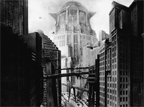
Geography and Social interaction in Virtual Reality
"Abstract: This paper examines the interrelation between the geographical and social aspects of virtual worlds. We examine the main geographical features of Activeworlds, a multi-user virtual environment available over the Internet. Activeworlds is not only one of the most popular virtual environments, it is also the only publicly accessible one in which users can build themselves, and thus shape their geographical and social environment. We examine, among other features, transportation, mobility, and property appropriation in this virtual worlds system. Further, we describe some of the influences, both from urban planning and science fiction, on the geography of Activeworlds. We also examine the social relations that arise from these geographical conditions, including the ‘rough and ready’ mentality of this ‘cyberspace frontier’. Finally, we consider the implications of this virtual worlds system for theories of the emerging geographical and social relations in virtual environments." From Activeworlds: Geography and Social Interaction in Virtual Reality by Ralph Schroeder, Avon Huxor, and Andy Smith.
"1.0 Introduction: The idea behind ‘30 Days in ActiveWorlds’ was to fully document the development of a virtual environment from beginning to end, as a plot of virgin virtual land which, it was hoped, would develop into a community and a fully-fledged new virtual world. The aim was not to create a dialogue of life in the virtual environment, such as the well-documented “My Tiny Life” by Julian Dibbell [1] or “The Cybergypsies” by Indra Sinha [2], yet the events that unfolded over the 30 Day period led to just such a documentation, and with it my conclusions about not only community and design in a virtual environment, but also views on the increasingly blurred boundaries between what is real and what is virtual." From 30 Days in ActiveWorlds – Community, Design and Terrorism in a Virtual World by Dr Andrew Hudson-Smith; Social Life of Avatars, Chapter 8, Ralph Shroder (Editor), Springer-Verlag UK. [via Digitally Distributed Environments]
Posted by jo at 08:59 AM | Comments (0)
September 01, 2006
The End of Cyberspace
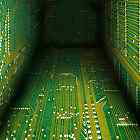
Cyberspace, a state of mind? + Another view
From UC-Irvine professor Mark Warschauer, The Death of Cyberspace and the Rebirth of CALL:
"The notion of "cyberspace" suggests that there exists a virtual, online world that is distinct from our real world. "Cyberspace" is a type of fantasyland, where we take on cyber-identities and engage in virtual reality. But then, when we leave cyberspace, we come back to the "real world".
I would contend, in contrast, that the significance of online communication lies not in its separation from the real world, but rather in how it is impacting nearly every single aspect of the real world. Just like there is no such thing as "speechspace" or "writingspace" or "printspace," so there is no cyberspace. The notion of cyberspace is thus not helpful for understanding the very real impact of online networking on our lives, and indeed the concept of cyberspace is slowly dying out." [link]
Cyberspace, a state of mind?
Buried in my del.icio.us links was a paper titled You Are Where? Building a Research Presence in Cyberspace, by an Edinburgh-based writer named Rory Ewins. It makes the argument that we should understand cyberspace as a kind of state of mind-- or more accurately, as a kind of imaginative state that we enter when reading:
"While most of us associate cyberspace only with computers and the Internet, we have been living in it for years. Whenever we pick up the telephone to talk to another person, we meet them in cyberspace, a place that corresponds to neither end of the line and to both.... [C]yberspace actually predates the “cyber”; we have been shifting in and out of it for as long as we have been communicating at a distance. It’s possible, perhaps, to trace it back even further in the history of communication: long-distance conversations carried out via airmail letters could be said to take place in a kind of cyberspace as much as at either end of the correspondence. As could letters from one side of town to another, or messages carried by couriers. All invoke an imaginative space in which two sides can meet and exchange information.
As anyone who has spent any time surfing the Web knows, it’s quite possible to spend hours at a time “in” cyberspace even when the only communicating one is doing is clicking on a link every few minutes to get a browser to send a request to a server for a new page to read. Most of our time online isn’t spent talking; it’s spent reading. Yet we still feel as if we are “in” cyberspace as we read words from the screen. Because of the history of the term itself, and the way we access these words via the Internet, we might conclude that computer technology is an integral part of this feeling of being in cyberspace....
Given the strong overlap in contemporary thinking between cyberspace and the Internet, and the past examples of the phone and telegraph networks, we might be tempted to think of cyberspace as arising out of communications networks, as being the place we meet when we communicate with each other. But that cannot be the whole story.... [R]eading takes us into an imaginative state, a state shaped by the author of the words we read, and by ourselves as readers. As readers we know what it feels like to be in that state; and we know what it feels like to slip out of it. We have all felt our minds wander as we read words on a page, and found ourselves having to go back and re-read them—forcing ourselves into a focussed, “reading” state of mind—immersing ourselves in those words, giving our attention over to them, quietening our own inner voice to listen to the voices of others.
What is this mental state? Where are we when we are in it? I would argue that it’s cyberspace; we simply didn’t have a name for it before. It’s a virtual place—the place where our mind meets another’s; where reader meets author. It’s the place we find ourselves in when we read a friend’s email; the place we meet when we hear their voice on our mobile phone. We have less opportunity when reading a printed page to respond to their words in a way that they will hear, but communication is still taking place, even if one-way....
So cyberspace is not something new. We have been building it for centuries, book by book, letter by letter, web page by web page. Or rather, we have been building gateways to it for centuries, because that’s all any of these are: means of access to the real cyberspace, which is invoked by our minds. Cyberspace is an imaginative state—a state of reading, of communicating, of thinking—which we have made more and more a part of our lives through advances in technology, from writing to printing to telecommunications to television to the Internet." [link] [blogged by Alex Soojung-Kim Pang on The End of Cyberspace]
Posted by jo at 09:56 AM | Comments (0)
August 29, 2006
Second Life Liberation Army
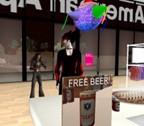
Battles in the Virtual World of Second Life
A group called the Second Life Liberation Army have been harassing Second Life inhabitants in the stores of First World brands. Earlier this month, members of the SLLA stopped shoppers buying in American Apparel. Their mission is to get voting rights in the world plus a share in the Second Life company, Linden Labs.
Second Life Liberation Army - The SLLA is a national liberation movement working towards establishing citizens rights within Second Life.
More info about on-line rebellion here. [posted by Marc Garrett on netbehaviour]
Posted by jo at 10:58 AM | Comments (0)
August 25, 2006
State of Play
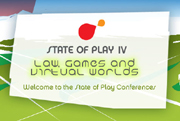
Conference Heads East
Aaron Delwiche of San Antonio’s Trinity University and the Terra Nova blog posts the news that the next State of Play conference will be held January 7-9 in Singapore. “We are convening thought leaders from Asia, Europe, Africa and the Americas to engage in a lively discussion about the unique regulatory and cross-cultural challenges posed by the growth of transnational virtual worlds.” It’s an interesting choice of location for what’s probably the most forward-thinking conference on virtual worlds. Asia has more virtual world “residents” than any other region of the world, and has seen a number of legal decision handed down that treat virtual worlds more like real places — with real property laws — than any in the West. Singapore will be tough to get to for many Western-Hemisphere VW pundits, but it also opens the dialogue to people we haven’t heard that much from on te other side of the world.
As Aaron’s post (and the SoP splash page) puts it:
Throughout Asia, people of all ages are gathering in cybercafes to participate in “deep” virtual worlds such as Lineage II and World of Warcraft or to play casual titles such as PangYa. With the highest broadband penetration rate of any country on the planet, Korea is currently an epicenter of gaming innovation, pioneering a free-to-play business model that seriously threatens subscription-based titles. Meanwhile, analysts note that India is poised to become a huge player once it builds out the necessary technological infrastructure. India is already the region’s third largest market for on-line games, despite the fact that less than .02% of the population has broadband access.
When you take into account the fact that NGOs and many government development agencies hope to seed the Asia Pacific region with inexpensive wireless broadband notebooks, it is clear that we are witnessing something completely unprecedented. We are eager to tease out the implications of these developments, and are intentionally convening virtual world industry experts, game scholars and technological neophytes to deepen our shared understanding.
Interestingly, the splash page also flags a New York State of Play this October, but there doesn’t seem to be any information about it on the site. I spoke on a panel on virtual journalism (Reporting from the Front) at last year’s event, which was a fantastic gathering of thinkers in the space. Among the speakers flagged for Singapore are Neal Stephenson, Cory Doctorow and Julian Dibbell, who will be holding “an extemporaneous discussion about the future of virtual worlds,” Alice Taylor, Nick Yee, Ren Reynolds, Richard Bartle and a handful of other similarly impressive names.
I haven’t made travel arrangements yet, but hopefully I’ll be there. I have made travel arrangements to get myself to Austin next month, where I’ll be flapping my gums on a very cool panel at the Austin Game Conference, but more about that in an upcoming post. [blogged by Mark Wallace on 3pointD]
Posted by jo at 06:49 PM | Comments (0)
August 23, 2006
Recursive Instruments
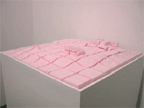
The Value of Translating the Virtual to the Real
Recursive Instruments is generously supported by Linden Lab through their Fellowship for the Visual and Performing Arts ... The value ascribed to objects, scripts, textures, and land in Second Life contrasts sharply with the value given to similar, material wants. Digital work cannot yet economically compete with comparable real world services. Our initial proposal to Linden Lab investigated these different markets of exchange. The ease of copy and paste undermines traditional economic practice. Without an original—a gold standard—the Linden faces an uphill battle to establish value in the minds of others. We believe that a body of images, objects and ideas exterior to Second Life is of paramount concern for a sustainable environment.
Just as [Simon Spartalian's] words and these slides communicate between you and I, so must Second Life use its content to communicate with culture. Tangible objects can carry a vivid experience outside the world that gave them birth. Our work began at this intersection. Using the Open GL Extractor (OGLE) from OpenLab and EyeBeam Research in NYC we can capture the 3D data behind Second Life. We have a Computerized Numerical Control (CNC) mill for the purpose of carving objects built from this data. Our first construction centered around the landscape of Sheep Island, a Sim which we printed, section by section (acre by acre), into the real world. Read more >> [Related post]
Posted by jo at 11:33 AM | Comments (0)
August 18, 2006
Darfur campaign in Second Life
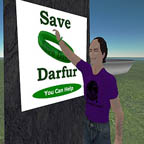
Embedded Social Messages
Darfur_Campaign [originally uploaded by eliane_alhadeff] (Rubber bracelets have made it into virtual life, as have hairy arms. Amazingly weird.) I found this on Flickr, and I'm rummaging around to find out what was going on - there was an interesting, Star-Wars style committee meeting for this online kidscamp project - maybe? - and a game has been produced, one of many to be produced by teens, each with a message:
Playing 4 Keeps is an innovative youth media project, in which a team of Global Kids Leaders at South Shore High School are gaining leadership and game design skills that they will use to develop and produce a socially conscious online game each year.
This is seriously impressive stuff.
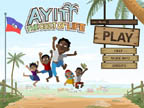
High quality, solid message:
Ayiti: The Cost of Life is a role-playing video game in which the player assumes the roles of family members living in rural Haiti. Over the course of the game, the player must choose among and balance various goals, such as achieving education, making money, staying healthy, and maintaining happiness while encountering unexpected events. The player must make many decisions that contribute to or detract from achieving his or her chosen goals.
Global Kids Digital Media Initiative - lots of interesting, game-based political and cultural activities, produced by and for teens,
SaveDarfur.org - the campaign [blogged by Alice in Wonderland]
Posted by jo at 03:34 PM | Comments (0)
The Prison of Embodiment
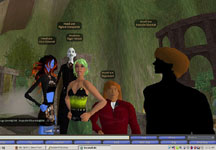
Eye Gaze and Intimacy
[screenshot by ceteri] As strange as it might seem, VR technology was a natural offshoot of the counterculture - a reliance on small-scale technologies to create a disembodied, connected global consciousness (think LSD, funky musical instruments, Whole Earth catalog of gadgets, and personal computers). As an aside, Fred Turner has a wonderful book coming out on the intersection of the counterculture and personal computing.
Of course, contemporary virtual worlds reveal an insistence on embodiment. Most virtual worlds are avatar-based. Where the counterculture was heading towards the liberation of disembodiment, the opposite has taken hold. In a recent study (PDF) at Stanford, we explored this tension between liberation and embodiment in virtual worlds.
There are many well-known patterns that goven how people interact in the physical world. For example, within a social distance of about 12 feet, the closer two people are, the less likely they will maintain eye contact. This is the elevator effect. Proximity and eye gaze are both signs of intimacy. To keep things in equlibrium, eye gaze compensates for distance when we stand too close to another person. Another well-observed pattern is that men maintain less eye contact with other men than women do with each other.
The question we looked into was: Do these patterns carry over into virtual worlds where people move with mice and keyboard instead of arms and legs, and where virtual gender need not match the real gender of a user? We used a script to collect positional and orientation data on social groups in Second Life over a period of about 2 months.
Our data showed that many patterns of physical interaction in the real world carry over into the virtual world. In other words, our insistence on embodiment in virtual environments structures social interactions in these worlds in ways that we may not consciously be aware of. On the other hand, this implies that virtual worlds may be useful platforms for studying things even as visceral as the rules of physical interaction.
Yee, N., Bailenson, J.N., Urbanek, M., Chang, F., Merget, D. (in press). The Unbearable Likeness of Being Digital: The Persistence of Nonverbal Social Norms in Online Virtual Environments. The Journal of CyberPsychology and Behavior. PDF [blogged by Nick Yee on Terranova]
Posted by jo at 12:26 PM | Comments (0)
August 15, 2006
Writing About Virtual Words

Second Life Arts & Total Entertainment Magazine
I have to confess I’m moonlighting in another world. I’ve started working in the virtual world Second Life as an “embedded journalist”. SLATE Magazine (Second Life Arts & Total Entertainment Magazine) is a new Second Life magazine that covers the arts in SL. There are 14 authors in the collective so far and we’re a mixed bunch of artists, academics, writers, business people and designers. At present there isn’t much analysis of SL out there as most blogs provide essential but simple reportage on events with little reflection. We’re taking a different tack and hoping to provide not only interesting information about things to do for SL residents, but analysis on what we think is going on. And, in true SL style we have a virtual office building with desks (I don’t get that, but it is funny). [upper left] is a pic of our boardroom created by the talented Dell and Anya.
We are also paid in Linden dollars (the inworld currency), we’ll be having frequent events and there was a big launch. I unfortunately was unable to attend the launch because my interstate flight was delayed. But here is a pic taken by the wonderful editor of SLATE Anya Ixchel:

There are more details and pics at Anya’s page and at her flickr. Anya/Angela Thomas is a respected academic who has been looking at literacy in SL, even running postgraduate classes in it. The event had live streaming music and was attended by the 40 who could get in. Many couldn’t get in and this will be changed for future events when the SIM allowance will be tweaked accordingly.
The Magazine is now online at http://www.slatenight.com/. It will be available inworld and in pdf format very soon. Advertising space is available too. My first article is: A Commanding Conversation and is a continuation of the ideas discussed here previously in this post on the poetics of keywords. In future articles I will be looking at how the gallery space and curatorial dynamics change in a virtual world and the writing and games specific to inside virtual spaces.
And IM me if you’re ever in SL, especially if you have some artwork, performance, book or game in SL. My SL name is Lythe Witte.
Reblogged at CME [blogged by Christy Dena on WRT]
Posted by jo at 06:48 PM | Comments (0)
August 07, 2006
The Travels of Mariko Horo

Being Mariko Horo
The Travels of Mariko Horo by Tamiko Thiel: Sometime between the 12th and the 22nd centuries Mariko HMrM, Mariko the Wanderer, journeys westward from Japan in search of the Buddhist Paradise floating in the Western Seas. She does find Paradise, but finds also a chilling, darker side to the West, an island where lost souls are held in an eternal Limbo. She encapsulates her impressions of the places she visits in a series of 3D virtual worlds and invites you to see the West through her eyes.
The Travels of Mariko is an interactive 3D virtual reality installation. The image is generated in real time on a fast gaming PC and projected on a large 9 x 12 screen to produce an immersive experience. Users move their viewpoint through the virtual environment with a joystick or similar navigational input device. Mariko is a fictitious character Thiel invented to incorporate the viewpoint for the project - users will never actually see Mariko, except perhaps in a mirror. In essence they will be Mariko, seeing the exotic and mysterious Occident through her eyes and experiences.
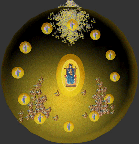
The virtual environment is sensitive to their presence, changing around them as a result of their movements and actions: An empty church fills with saints who vanish into the heavens. A basilica transports the user directly into the Western Cosmos, where angels sing the praises of the Goddess of Compassion. A pavilion takes users deep into the underwater realm of the Heavenly King. A plain wooden chapel leads into a Limbo of constant torment.
Music for Mariko Horo is embedded in the piece itself, localized to specific places within the 3D world. The composer Ping Jin, Professor of Music at SUNY/New Paltz, studied music both in his native China and in the USA. Ping describes the music as "creating a sonic dimension for Mariko's meditation on the mythic West. Created from both sampled and computer generated sounds, there are fusions and juxtapositions of Eastern and Western sounds to enhance the scene and mood of each section."
World premiere:
July 29 - November 26, 2006 :: "Edge Conditions" show, part of the Pacific Rim Theme of ISEA2006 Symposium/ZeroOne San Jose Festival at the San Jose Museum of Art, USA.
European premiere:
As the 2006 winner of the "Young Art/New Media" prize of the City of Munich, curated by Bettina Wagner-Bergelt and Dr. Stefan Urbaschek, "The Travels of Mariko Horo" will form an interactive 3D stage set for a specially commissioned Butoh dance performance by Shinichi Iova-Koga (www.inkboat.com) and Ishide Takuya during the Dance2006 Festival in Munich.
November 10-12, 2006 :: Dance2006 Festival of Contemporary Dance at i-camp / Neues Theater, Munich, Germany.
See also Mariko Horo's Logbook: This is a "preview" or "trailer" that Thamiko did as a brief narrative commentary on the much larger, non-linear VR installation. It was published in the June edition of the online art journal mark(s).
Posted by jo at 05:05 PM | Comments (0)
July 26, 2006
Ars Virtua
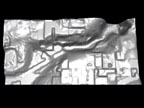
The Second Life Landscape Initiative
"A landscape comprises the visible features of an area of land, including physical elements such as landforms, living elements of flora and fauna, abstract elements such as lighting and weather conditions, and human elements..." -- wikipedia
The landscape is well understood in real-space as a driving force of the economy, an inspiration and a refuge. Ars Virtua is proud to present The Second Life Landscape Initiative. In this exhibit we are testing the boundaries of translation and connection. What happens to our relationship with the environment when we enter the synthetic world?
We examine four plots of land through data, analysis, visual imagery and prose. We then ask the viewer to engage the landscape and form their own memories and associations.
This exhibit looks at the land of Second Life through several lenses and tries to find a closer connection, this is not merely the distant gaze of the scientist but the the gaze of a lover or of a poet. We examine the data, forms, texture, images and stories that come from the land. Ars Virtua invites its viewers to come to the show and then to walk the surrounding lands of Butler and Dowden in search of their own narratives.
We will be highlighting the work of Lucid Vindaloo, LestatDe Lioncourt, Fiend Ludwig, Zero Philo. The SLLI (Second Life Landscape Initiative) opens Friday July 28th at 7pm SLT in Gallery 2 of Ars Virtua along the Butler/Dowden sims.
Located at the border of Butler and Dowden in Second Life's virtual environment, Ars Virtua's 3000 square meter two story building is divided into main and secondary galleries and a residency space. In order to visit Ars Virtua you will need to create a free account at Second Life (http://secondlife.com/join) and need to be running the current client. Once you have this properly installed you should be able to follow this link directly to Ars Virtua
secondlife://butler/228/15
Ars Virtua: Gallery 2, Butler (228, 15, 52)
http://slurl.com/secondlife/Butler/228/15/32/
Posted by jo at 06:01 PM | Comments (0)
July 19, 2006
Second Life Live Concert

Virtual Vega
"Back in the early 90s, an engineer named Karl Brandenburg was wracking his brain for a way to compress music files without losing their quality, when an insistent, dulcet a capella voice came drifting toward him up the hallway of the German Aerospace Center. It was rich and soft but imperfect in a way that made the singer unique, and it gave Brandenburg an instant intuition: if he could digitize it while still retaining the artist's soul, so to speak, he would have his ideal file format. The song was "Tom's Diner", the singer was Suzanne Vega, and it's why the New York musician is sometimes referred to as "the mother of MP3", the file format that made the flowering of music culture across the Internet possible.
So it seems fitting that Suzanne Vega will become the first established musician to have her entire persona uploaded onto the Internet, too. News of her performing a live concert in Second Life has already reached the SL blogosphere (as here), but when I read that news, I wanted to meet Vega's avatar for myself -- and see, so to speak, how well they'd captured her soul...
..."So how will the live show with Suzanne actually go down?" I ask Quirky, skeptical. "Will she control her avatar?"
"Yes, she will, as much as one can while simultaneously playing and singing! But she will inhabit it. She's very excited about that." I ask her if Vega's had an orientation with the complex user interface, and that question comes from personal experience, knowing how difficult it was to manuever a Pentagon advisor and a Stanford professor through the metaverse. "We still have a couple of weeks," Quirky tells me gamely, "and have already discussed that with her and the other guests."
Suzanne Vega's avatar is the work of famed in-world designer Munchflower Zaius, now busy completing the identities of two more Infinite Mind guests who'll appear in Second Life: Internet guru Howard Rheingold, and legendary author Kurt Vonnegut. "How cool is it that the author who first speculated about the relationship between man and technology is coming here in avatar form for a chat and reading?"..." [read complete post at New World Notes]
Posted by jo at 07:27 PM | Comments (0)
July 18, 2006
Human Trials
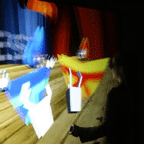
An Absurd Quest
Human Trials -- by Josephine Anstey, Dave Pape, and Sarah Bay-Chengis -- is simultaneously a public / private and embodied / disembodied performance. One user enters an immersive VR and is led on an absurd quest. The challenges appears to be about control and the choices one makes with power; but the games are rigged, the characters are duplicitous, the quest is a decoy, and the underlying test is how to cope with disempowerment. Meanwhile the experience is screened for a voyeuristic audience primed by reality TV. The audience members simultaneously watch multiple viewpoints of the virtual world, while live performers, networked into the VE, attempt to entangle the protagonist in their improvisational machinations.
The performers play two characters, Patofil and Filopat, who engage the participant in a set of overt challenges involving computer-controlled characters and dynamic virtual sets. Beyond these obvious tasks, the participant must also interpret and negotiate a subtext about world views, relationships and alliances. The participant's reactions are logged, interpreted psychologically, and affect the characters' behavior, the presentation of further challenges, and the ending. Although we expect the story to follow a basic arc based on a storyboard, our script/improvisation notes for the actors are evolving during performances.

Human Trials is designed for CAVE or CAVE-like, tracked, immersive VR systems. 3-D stereo displays with one large screen or multiple screens and/or HMDs. Ideally the participant and two human actors each enter the virtual environment from their own VR system. In effect the actors are manipulating life-size puppets since their tracking systems animate the avatars of Filopat and Patofil that the participant sees. A fall-back position is to have the actors operate their puppets from monitors without tracking systems, in this case they can still navigate their puppet wherever they need in the virtual environment.
Human Trials builds on Josephine Anstey and Dave Pape's previous experience building dramatic VR, The Thing Growing, and Networked VR projects, and Sarah Bay-Cheng's experience with drama and puppetry. Human Trials is a sister project to The Trail The Trial, experimental research focused on building intelligent agents to take the place of the human actors.
Posted by jo at 08:33 AM | Comments (0)
July 06, 2006
Second Life

Hyper-Instruments and Immersive Spaces
VIRTUAL MUSIC COMPOSITION: Unsatisfied with just creating virtual plant life, a provactive multiplayer game, and ambitious machinima, Robbie Dingo has also been hard at work creating virtual world musical instruments that actually play in-world in real time. He extensively documents the creation of his "Hyper-Instruments" on his blog here and here, and recently sent me word of a song-writing contest for music composed to be performed on his new SL cello.
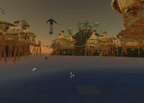
ADVENTURES IN IMMERSION: Seasoned RL/SL architect Jauani Wu takes us on a personal tour of successfully immersive spaces in Second Life, accompanied by a 3D designer's manifesto written e.e. cummings style: immersion requires depth. it's not sufficient for one enclosed space to be finely constructed. it requires that the next space be so as well. and the space after that. immersion works better when the surface of one space frames the next. it reinforces the notion of world. By my lights, mandatory reading for builders looking to truly transform the world according to their vision. Read it all here. [posted on New World Notes]
Posted by jo at 02:45 PM | Comments (0)
June 29, 2006
Second Life
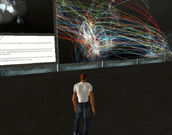
Transposition Opens in Ars Virtua
Friday June 30: Temporal abstractions of information have always been important to communicate ideas, whether simple or complex. By translating information into a visual form, we’re able to reflect upon it with a different perspective. This creation of perspective is the key to transposition.
Transposition is the ability to translate data from one form to another without a loss of information. Transposition is most often used as an algorithmic process to translate information into a more coherent and understandable format. With an increasingly computer enabled world, our collection and cataloging of data is growing by the second. With new forms of data comes the demand for new means to display those forms, and herein lies the job of the transpositionist.
The transpositionist must decide upon the appropriate algorithm to use to convey their perspective on the information. This can be for analysis, speculation, criticism, aesthetic abstraction, or simply experimentation. The end goal influences the disciplines the transpositionist must call upon to appropriately execute his or her idea.
This show includes projects with very different data sets and very different intentions. Data sets ranging from four letter words to prescription pharmaceuticals, to the blogosphere and beyond. Each takes on a unique method for presenting a perspective on information that otherwise would remain unseen.
Opening Friday June 30 from 8pm - 10pm SLT (Pacific Time); secondlife://dowden/41/58
Ars Virtua is a new type of exhibition venue that leverages the tension between the 3d rendered game space and the space occupied by meat. It is part of a series of projects that explore the virtual as the new real.
Located at the edge of Butler and Dowden, in the world of Second Life. To view the exhibit you will need to create an account, download the client and create an avatar http://secondlife.com/join
Ars Virtua's 3000 square meter two story building is divided into a main gallery space, a lounge and shop and residency space.
Posted by jo at 02:39 PM | Comments (0)
June 28, 2006
TRG [Transreality Generators]
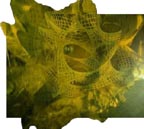
The 'Irreal' in New Media Art
TRG [Transreality Generators]--by FoAM--is a project that builds upon the two previous immersive installations / responsive environments: TGarden and txOom. All three projects are concerned with the 'irreal' in new media art. By 'irreal' we mean artworks that provoke a tension or imbalance between tangible reality and the imaginary worlds. With responsive environments, the line between the real and the imaginary can be very thin, allowing for the experience to become 'irreal' - where the participants fade in and out of physical reality, uncertain of their position in this 'reality continuum'. TGarden was designed to allow human gestures to use video and audio as calligraphic media, to 'write and draw' the immersive environment on the fly. txOom extended the concept and became an 'irreal ecology' where media would grow based on their interaction with the participants. TRG changes scale once more, to infinitely large and infinitely small 'irreal universes', whose existence is highly unstable and unpredictable, where minuscule local interactions can conjure up the lives massive worlds.
The conceptual framework within which the artists develop their concepts and designs is 'simulation of physics and physicality of simulation'. In order to be able to 'mix' the physical and the virtual reality in interesting ways, the artists explore the basic principles that constitute our universe (gravity, electromagnetism, nuclear forces) and create media worlds as new universes, where physical laws become amplified, distorted, enlarged etc. To the audience immersed in the MR environment, these worlds should 'feel' as familiar and intuitive, but upon closer inspection their strange and magical properties can become apparent. The TRG team creates rich media worlds consisting of materials, objects, interfaces and architectures that allow a seamless transition between the physical reality and the computational worlds. By correlating some of the more interesting properties in the physical systems (such as fundamental physical forces, string theory and membrane physics, tensegrity principles, etc.), and abstracting them, there is the potential to create new (coherent) laws within the media-worlds.
The project focuses on Mixed Reality (environments containing significant virtual and physical interaction possibilities, strongly intertwined) and exploring its implications in the cultural sphere. Mixed Reality (MR) enables the public to be immersed in multisensory, responsive media environments capable of reacting and evolving, influenced by human activity and interaction. The participants leave the role of the observers and become creators of a temporary autonomous reality. In TRG, an international team of artists and technologists explore the frontiers of this unique form of creative expression through the integration of self-contained systems of media, materials and structures, perceived as a distinct field of reality, embedded in the physical objects and architecture. This project examines the potential to extend their artistic practice into the field of situational experience design, in which the art-works become all-encompassing art-worlds. [Related]
Posted by jo at 06:28 PM | Comments (0)
June 25, 2006
BBC Radio 1
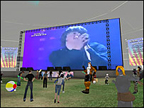
Talent-Spotting in Virtual Worlds
"...At Radio 1 we want to bring a new level of social interaction to our virtual broadcasts. We are hoping that the bands featured on-air will have their own custom-built avatars, playing in the virtual world. So if we have the Red Hot Chilli Peppers playing a gig, visitors to a Radio 1 virtual space will see avatars of Anthony Kiedis and Flea, mimicking the action in the real world.
We also believe it is crucial that the virtual audience can interact with the event. It is about replicating the "liveness" of an event, not just broadcasting it. Additionally, Radio 1 wants to find ways of allowing the audience in these worlds to actually affect the real event. I see no reason why they cannot be asking their musical heroes questions, alongside virtual Radio 1 DJs, either via Instant Messenger or VoIP. This deeper social interaction, that mirrors real world events, would do much to enhance the ripples that resonate around digital communities." From Talent-spotting in virtual worlds by Daniel Heaf, BBC.com.
Posted by jo at 03:14 PM | Comments (0)
June 15, 2006
Flickr Cracks Down on Screenshots
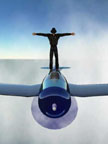
Online Worlds Collide
"Online worlds collide as Second Life fans and Flickr spar over how to handle screenshots on the popular photo-sharing site. At stake is a little-known Flickr policy of flagging accounts that contain mostly non-photographic images and preventing images from those accounts from appearing in public areas of the site, including search. As a result, many screenshots on Flickr are AWOL -- at least as far as the general public is concerned. That's angering and confusing some of the people who carefully stage scenes in the popular virtual world and religiously post the results online. "I Hate Flickr" is the title of one blog post on the topic." From Flickr Cracks Down on Screenshots by Kathleen Craig, Wired.
Posted by jo at 04:59 PM | Comments (0)
Doing Virtually Nothing

Awareness and Accountability in MM Online Worlds
"Abstract: To date the most popular and sophisticated types of virtual worlds can be found in the area of video gaming, especially in the genre of Massively Multiplayer Online Role Playing Games (MMORPG). Game developers have made great strides in achieving game worlds that look and feel increasingly realistic. However, despite these achievements in the visual realism of virtual game worlds, they are much less sophisticated when it comes to modeling face-to-face interaction. In face-to-face, ordinary social activities are “accountable,” that is, people use a variety of kinds of observational information about what others are doing in order to make sense of others’ actions and to tightly coordinate their own actions with others.
Such information includes: (1) the real-time unfolding of turns-at-talk; (2) the observability of embodied activities; and (3) the direction of eye gaze for the purpose of gesturing. But despite the fact that today’s games provide virtual bodies, or “avatars,” for players to control, these avatars display much less information about players’ current state than real bodies do. In this paper, we discuss the impact of the lack of each type of information on players’ ability to tightly coordinate their activities and offer guidelines for improving coordination and, ultimately, the players’ social experience." From Doing Virtually Nothing: Awareness and Accountability in Massively Multiplayer Online Worlds by Robert J. Moore , Nicolas Ducheneaut and Eric Nickell. [via pasta and vinegar]
Posted by jo at 08:33 AM | Comments (0)
June 09, 2006
Listening and Dancing in Second Life
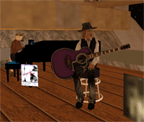
Taking Your Avatar to a Concert or Dance Class
"...A couple of Sundays ago, I took my avatar to a small pond where about a dozen people lingered in the late afternoon sun, floating on inflatable rafts and inner tubes while a pair of animated swans jerked their way across the water. Everyone was turned toward Few, sitting on the deck above the pond with his acoustic guitar, and everyone nearby could hear a feed of the real-life Hokin, from his real-life basement, playing cover songs.
While I dug Few's proficiently-played but laid-back standards, I wasn't here to decide whether this was the best version of "The Girl from Ipanema" I've ever heard so much as to check out the experience-- and it was surprisingly engaging. If it seems strange to come to a video game to watch a concert, remember that we've been listening remotely to live shows since the first days of radio. In that sense, this is nothing new-- and while it's more disorienting than tuning in to the Grand Ole Opry, it's more rewarding than other options, like watching a streaming video of a rock show through a tiny RealPlayer window. At least in Second Life, you can move the camera..." From Get That Out of Your Mouth #24: The Show Must Go Online by Chris Dahlen.
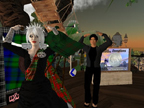
"...Now with the growth in dancing in this alternative reality, I have more of an incentive to make an avatar for myself and start wondering around and going to clubs, get-togethers and, even, dance studio. This notice caught my attention:
This past Tuesday, the Takeshi's Dance Studio in Second Life held an event to teach people how to dance. Plus, they will soon be building a theater and they need dancers ... Dancing doesn't just take place in virtual clubs. Events on private islands also feature music and dancing. Earlier this year, Creative Commons hosted a party...
In "Get That Out of Your Mouth #24 - The Show Must Go Online," Chris Dahlen describes the experience of listening to music in Second Life, how indie bands take virtual tours and make money, and the limitations of gestures and dance in this virtual world:
Players also can't control their avatars with any spontaneity or nuance; if you want to dance at a show, you can trigger an animation that runs your avatar through the steps, but you can't personally step in to make the arm rest on your partner's back just so. The same problem applies for performers. If you look closely at Few as he's playing guitar, you'll see that he can't strum or move his hand on the fretboard, and his face is trapped in a stiff mask, like a dummy in a vintage Disney World ride. And while you can add more animations and poses to an avatar, if you have the time and you're handy with 3-D modeling software, you can't make the spur-of-the-moment gestures that even stiff indie rockers need to liven up their acts.
- And Rik Riel (his SL name) in his "Dancing with myself... with other people" post, says that he goes to a lot of SL events and music gigs. He describes how dancing works:
In Second Life, you are given a small set of pre-defined dance animations that you can trigger from your keyboard. It's easy to pick up other animations at parties or from friends. You can easily perform everything from a waltz to b-boying to country two-step (not to mention more, uh, provocative dancing).
But he's not really sold on this virtual dancing:
A real basic question is Why would you do this? Virtual dancing provides none of the perks of real world dancing, either the joy of movement, the physical response to music you are digging, the pleasure in touching another person, or the pride of executing a difficult move. There's no learning curve, no physical exertion, no effort to anything, except maybe the effort involved in designing your own custom animations.
I've been dancing my whole life, from all of the terrible 80's trends (smurf, running man, pac man, etc.) to popping and locking, salsa, tap, and now lindy hop. There are few other moments when I am happier than when I am dancing. There is nothing to compare to sharing great music with someone you care for swaying in your arms. I love dancing so much, I help administer the largest lindy hop community website on the net, Yehoodi.com. [blogged by Doug on Great Dance Weblog]
Posted by jo at 12:26 PM | Comments (0)
June 07, 2006
Metaverse meets mash-up:
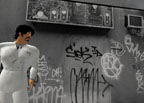
FREE CULTURE REMIX IN SECOND LIFE
Metaverse meets mash-up: come June 15, there's going to be another Free Culture/Creative Commons event in Second Life, this one springboarding off the recent CC Art Show 2006 at NYU and the Sharing is Daring event at Harvard. The object here is to take the art featured at those sites, and then remix it for an in-world showing on the 15th. You can do the remixing with Photoshop and other standard tools, of course, but for this event, the ideal medium is SL itself. Which is what I did with an Untitled photo by Joseph Gergel (above), uploading it as a texture, displaying it in-world, and using it as a backdrop for a dramatic screenshot, above.
No doubt Residents can come up with way better remixes, taking the appropriately-licensed art from here and here*, then converting them into screenshots, 3D sculptures, interactive sites, whatever. I'm looking forward to reporting on what comes out of this.
Deadline for submission is end of June 13. E-mail a screenshot of your entry to Jennifer Yip of Creative Commons (Genevieve Junot in SL), and be sure to include your RL and/or SL name for proper credit. Prizes will be virtual CC t-shirts and other tchotchkes, real and virtual. In any case, do come to the event to share your work, and hopefully meet some the original artists who may also be in attendance. (Full disclosure: I'm now honored to be a part-time consultant for CC's events and activites in SL.) ... [blogged by rubaiyat on New World Notes]
Posted by jo at 01:42 PM | Comments (0)
June 02, 2006
Second Life
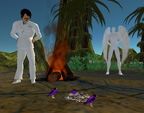
User Creates Virtual Ecosystem
Wagner James Au sez, "While taking a break from the UK game industry to raise her child, a programmer created a self-contained ecology on a Second Life island, with numerous species and natural phenomenon that must work together to keep the system function: clouds rain on the land, nourishing the plants (which also respond to sunlight), bees spread pollen to help the plants reproduce, birds eat seeds to keep the plants from growing out of control, and so on."
If I was to turn off the clouds the whole system would die in about six hours," Laukosargas Svarog tells me. "Turn off the bees and [the plants stop] growing, because nothing gets pollinated. And it's the transfer of pollen that signals the plants to drop seeds. The seeds blow in the wind, and if they land on good ground according to different rules for each species, they grow when they receive rain water from the clouds. It's all interdependent. Link (Thanks, James! ) [blogged by Cory on Boing Boing]
Posted by jo at 03:48 PM | Comments (0)
May 19, 2006
A Virtual Intangible Purchase and Real Lawsuit
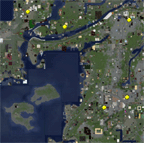
How to Recognize The Future When It Lands On You
"A US gamer has filed a "first-of-its-kind" lawsuit in an acrimonious dispute over the sale of virtual land within the online role-playing game Second Life," this New Scientist article says. "The suit highlights the large amounts of money many gamers are now spending in the hope of reaping a profit within their chosen virtual world. Second Life lets players buy land and build structures that can then be leased or sold on to other players,often for a profit. The game's currency, Linden dollars, can be easily exchanged for real cash.
Marc Bragg, an attorney from Pennsylvania, US, filed the suit against the company behind Second Life, Linden Lab based in California,US. He accuses the company of deactivating his account after he discovered a loophole that enabled him to buy virtual land cheaply within the game. The suit, filed in a local district court, seeks financial restitution for Bragg who claims he invested around $32,000 in the virtual land. "This is probably the first dispute of its kind," Bragg says in a statement posted online. "This suit challenges the legitimacy of a virtual intangible purchase of an asset. "Bragg adds that the dispute could test the relevance to virtual worlds of existing laws". Game company sued over virtual land squabble by Will Knight, NewScientist.com. [blogged by Jim Downing on Smart Mobs]
Posted by jo at 06:04 PM | Comments (0)
America's Army: Special Forces (Overmatch)
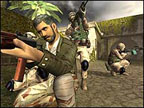
War Vets Feature in US Army Game
War Vets Feature in US Army Game by Alfred Hermida, Technology editor, BBC News website: The US military is putting soldiers who fought in Iraq and Afghanistan into its video game in an attempt to put a human face on its operations overseas. The soldiers' stories are part of a new version of America's Army, a game which is part of its recruitment strategy.
The US military denies that the project is a way of selling an unpopular war to the American public. Instead the free game is designed to inspire young people by relating the real-life experiences of the troops. "The majority of the public is not touched by the war," said Major Jason Amerine, who served in Afghanistan and is one of the nine soldiers appearing in the game. "It is dangerous to have an army overseas fighting and for a public to become so disconnected that they don't realise that we are not automatons over there. We're real people," he told the BBC News website.
'Real heroes'
America's Army was first released in July 2002 and has gone on to become one of the top online games, with seven million registered players.
It taps into the popularity of military and war simulation titles among predominantly young men.
It shows we are not robots, that we're not trained killing machines. We're just people.
It was developed by the Army to simulate combat and life in the military and reach young people for whom video games are a part of everyday life.
In the latest version of the game, called America's Army: Special Forces (Overmatch), the military is adding the experiences of nine soldiers who served in Afghanistan or Iraq.
The title has a so-called real heroes section when players can learn about the real-life troops.
In a virtual recruiting room, gamers can click on a soldier to hear them tell their story. They can also compare their achievements in the game to those of the GIs.
"It gets our stories out there about what the army is doing," said Sergeant Matt Zedwick, who served and was wounded during a tour of duty in Iraq in 2004.
"It is a good communications device to introduce people to what is really going on, rather than what you see on the news."
"It shows we are not robots, that we're not trained killing machines. We're just people," said the 25-year-old who is now studying graphic design at a college in Oregon.
Reaching the public
The US military sees America's Army as an information, rather than as a recruitment, tool.
The latest version was showcased at last week's E3 games expo in Los Angeles and is due to be released in the summer.
It comes at a time of growing unease in the US about the war in Iraq.
And last year, an official US government study warned that the military was falling behind in its effort to recruit troops for combat operations in Iraq and Afghanistan.
But the people involved in the title say there is no connection between the new game and America's troubles over its combat operations.
"We're not talking about the war, we're talking about people in the war," insisted Major Amerine, who served in Afghanistan in 2001 during the initial invasion.
"We are not attempting in any way to sell a war to the people, that has nothing to do with our agenda.
"We're trying to create awareness about the people doing the fighting, and that is a very apolitical agenda," said the major who now teaches at West Point.
Toy soldiers
As part of "real heroes" campaign, figures of the soldiers featured in the game are to go on sale.
The Army says these are not designed to be toys for children but items for collectors who wish to express their support for the troops.
Seeing themselves as little plastic soldiers is a strange experience for the troops involved.
"It is kinda funny and a little creepy. Unbelievable in a way," said Sergeant Zedwick.
"It is kind of funny to think there are going to be millions of people buying little dolls of you in the stores." [posted by Ryan Griffis on Rhizome Raw]
Posted by jo at 07:30 AM | Comments (0)
May 12, 2006
Radio 1's One Big Weekend
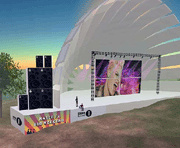
Second Life Virtual Festival
While E3 rages on over Stateside, here in the UK it's wellies and arm-waving in the Dundee sunshine: Radio 1's One Big Weekend, all weekend, all free, all festival fabulous: starting tomorrow. And if you're nowhere near Dundee or didn't get a ticket, you can still join in, because the Radio 1 team have only gone and built a virtual festival in the also-free Second Life:
Every virtual festival-goer will get a wee digital radio to take away with them, which will broadcast Radio 1 in-game, wherever you are.
![]()
There's also, I hear, these Radio 1 teeshirts for your avatars. And dancing. And a chance that you could appear on-screen at the actual festival - the jumbotrons may or may not take screengrabs of the in-game festivalgoers.
Obvious disclaimer: I work for the BBC, and I work with the guys who made this happen, and I TOTALLY {heart} them. This blog is still all my own opinions and not necessarily those of my employer. Disclaimer over.
If you're in there, say hi! Just load up SL, search for Radio 1, and head over - but not now, because it opens tomorrow morning, GMT. Or IM me, and I'll teleport you there: Crystaltips Pavlova. [Posted by Alice on Wonderland] [Related]
Posted by jo at 12:22 PM | Comments (0)
May 10, 2006
Blind Love
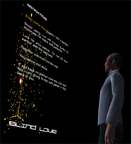
Extensions via Virtual World of Art
In Blind Love (click on Art), two visitors must find each other before they can find the way out of a pitch-black labyrinth. Each is armed with a weapon that shoots luminous particles. The particles explode on the walls and cascade into the corners, revealing the skeletal outline of the labyrinth's architecture. The two visitors must use the light emitted by their weapons to find one another, but-in an inversion of normal game logic-must not hit and kill each other if they hope to win. Like lovers, the visitors must blindly trust each other in order to survive, and must approach one another despite the danger.
Blind Love is one of the art works created for EXTENSION (click on Virtual World of Art, Extensions/SAT), a virtual architectural intervention that explores the potential of digital architecture to reveal and transform urban, cultural, and spatial identities. EXTENSION was created for the SAT in Montreal, one of North America's leading centres for new media. Visitors entering EXTENSION through the SAT terminals find themselves in a virtual space that mirrors their actual physical surroundings.

As they move through the environment, they cross from reality into virtuality, and from simulation into representation. Within the virtual environment, the existing building of the SAT has been recreated as a realistic 3D model. This simulation is transformed and reconfigured with the addition of a vast, zeppelin-shaped structure affixed to the roof. From inside this glass-encased space, visitors have a panoramic view of a virtual Montreal, where the city itself has been reconstructed with a poetic blend of realism and utopian fiction. Visitors to this near-real space discover experimental artworks in the halls and rooms of the virtual environment, and layered in other dimensions accessible through portals that brings the viewer into dedicated art installations. Anchoring virtual experience in real space, EXTENSION blurs the boundaries between imagination and perception. Grounded in the real but not limited to the realistic, EXTENSION is a reflection of the concepts and visions each of us forms about spaces and places.
EXTENSION is one of three nodes of the Virtual World of Art.

As technologically mediated experiences the Internet, games, cinema, television occupy ever more of our time and energy, it becomes increasingly vital that we create alternative spaces and environments for experience within these borderless territories of information and communication. Virtual World of Art invokes, manipulates and transforms the vocabulary and logic of game culture to create artistic engaging spaces which awaken aesthetic, emotional, social and intellectual responses radically different from those engendered by contemporary mass media. The project explores a variety of significant problems that cultural institutions committed to artistic practice within a networked electronic environment continue to face: how to create esthetically compelling and emotional online experiences, how to link physical and data spaces together, and how to effectively enable human communication and exchange in a physical space where local and remote visitors and performers can communicate virtually through technologies and computer interfaces.
Virtual World of Art investigates the artistic possibilities of immersive game technology and proposes new models for experiencing architectural and public spaces, sociability, and cultural production. Grounded in reality but not limited to realism, Virtual World of Art forms a dynamic, socially relevant, independent alternative to the existing art world, enabling artist to emancipate and develop a critical view of the future and meaning of contemporary art.
Virtual World of Art is the title for a series of new media art projects which subvert and reconfigure multi player game technology to create a network of artistic virtual environments. Each of these virtual environments called nodes, containing digital artworks and virtual art installations, is associated both conceptually and thematically with a specific site, arts centre or a public event where the project is presented on a long-term basis. These virtual environments are connected together by the internet forming a new kind of enlarged social and experiential public space for artistic expression and social exchange.

VWA will connect at least 3 locations or nodes in order to function as a complete project. Each node explores a different notion of hybrid between physical and virtual public space. Visitors will be able to interact through terminals installed at the nodes or at any public space in the world that has a high-speed internet connection.
Virtual World of Art is a project of Workspace Unlimited.
Posted by jo at 10:57 AM | Comments (0)
Device Art Brings Technology to Life
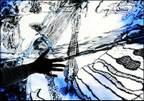
You Don't Try to Hide it
"...The works of art along the Japanese aisle at the International Conference on Virtual Reality in Laval, western France this weekend are not the sort you find protected behind glass. On the contrary, it is up to the spectator to bring them to life. "Please touch", the signs read. "Virtual reality opens up a whole new space, where the work of art becomes dynamic", where "the artist is no longer unique", explains Alain Grumbach, a virtual reality specialist who teaches computer science at the national school of telecommunications in Paris. Spectators "derive emotion from the images, but also from the possibility they have of changing the course of those images," Grumbach notes.
The effect is almost magical. It is an odd sensation, dipping a wooden spoon into an empty bowl and watching it splash around in clear water on the adjacent screen ("Wet-Free Water" by the Nara institute of science and technology, Japan).
It is a funny feeling, pushing a box of tea across a table and feeling a team of tiny virtual imps resisting it with all their might, but visible only through a little wooden window -- as in "Kobito Virtual Brownies" by the Tokyo Institute of Technology.
A little further on, Norimichi Idehara, associate professor of information sciences at Tokyo's Tama university, is fretting over his virtual planet, an ecosystem under a globe, whose "creatures are near to extinction", despite the public's efforts to generate rain by touching the globe.
"It's magical but people know it's a technology", says Machiko Kusahara of the School of Letters, Arts and Sciences at Waseda University in Tokyo. "You don't try to hide it".
"Device art", the latest craze in Japan at the moment, "is often gadget-like", Kusahara continues, "but with carefully designed artistic intention. Artists produce commercial products for available in daily life... [they] try to reach the widest possible audience."
Japanese culture does not draw a firm distinction between noble, "fine art" and "low art", Kusahara explains. Device art reflects the importance of aesthetics in daily life, or "beauty in the tools".
The virtual bowl of water is appealing simply as an image, and the clear sound of flowing and splashing is pretty. Yet neither the camera that films your real-world movement, nor the computer that works out how the virtual water should move, are hidden. The object is a piece of technological virtuosity.
The little tea-box imps are actually already available in the shops. "Imagine life with Kobito", their Internet advertisement says (rogiken.org/vr). "It will give you comfort when you are in trouble".
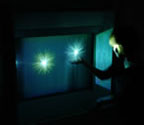
At the end of the Japanese aisle Hideaki Ogawa's installation, "Perfect Time", is of a more philosophical bent. A thin screen veil of golden grains flows out of its "hourglass", onto which images are projected. It is up to the audience to put sand in the "hourglass". If they do not, then they cannot see the images. Our perception of time is thus suspended. The virtual exists only when there is interaction between person and object." From Yahoo News.
Posted by jo at 10:29 AM | Comments (0)
February 22, 2006
Justine Cassell
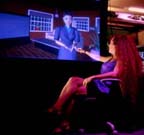
Embodied Conversational Agents
"What is an Embodied Conversational Agent? It is a lifesize virtual human capable of carrying on conversations with humans by both understanding and producing speech, hand gesture and facial expressions. Embodied Conversational Agents are a type of multimodal interface where the modalities are the natural modalities of human conversation: speech, facial displays, hand gestures, body stance. They are a type of software agent insofar as they exist to do the bidding of their human users, or to represent their human users in a computational environment. They are a type of dialogue system where both verbal and non-verbal devices advance and regulate the dialogue between the user and the computer. In the Embodied Conversational Agent, the visual dimension of interacting with a cartoon character on a screen (rather than a keyboard) is intrinsic to its function. The graphics are not just pretty pictures, but visual displays of conversation, in the same way that the face and hands serve that function in face-to-face conversation among humans..."
Posted by jo at 07:58 AM | Comments (0)
February 06, 2006
Making the Virtual Real
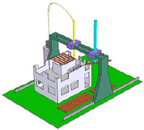
reBang(ing) via 3D Printers
As we move into the fabrication future, we'll see a surprising cross-over between the skills of virtual world designers and the skills of designers of physical objects.
We're all familiar by now with the idea of real money being used to buy virtual goods, and even with virtual money being used to buy physical goods. The intersection of online worlds and the real world doesn't stop there, however. It turns out that the increasing detail of 3D objects in virtual environments makes it possible to think of them not simply as game objects, but as digital prototypes -- and 3D printers are the tool of choice for turning the prototypes into real objects. WorldChanging ally Csven Johnson is at the forefront of this movement. On his blog reBang, he discusses his efforts to convert the game data for objects into CAD data usable with rapid prototyping hardware.
The metaverse is not just an ethereal “storyteller’s” world. It’s a world comprised of data. Just look at the reasons Marketing people are salivating over it. The tracking data is orders of magnitude better than trying to count eyeballs watching a television screen. And in a 3D interface (which is what those videogames really are), that data goes well beyond just “hits” or “click-throughs”- it’s comprised of “vectors” and “3D positional data”. And here’s the important part: that data can be converted into more than just marketing statistics. It can be converted into real product; something you can hold… in the flesh. The Story made Real.
The image above [At left here -- Jamais] is a screen capture from Pro/ENGINEER CAD, perhaps the most widely used product development 3D application for design and manufacturing. That object is a piece of a virtual game object “captured” from id’s Quake 3 videogame (the barrel of a Rocket Launcher). It was not created in my CAD application. It was not ripped from the game files. I “hijacked” the data streaming to my monitor using a freely available tool. And now, if I desired, I could manipulate the data and create a real product...
...Don't get tripped up by the example being a "rocket launcher" that wouldn't work in the real world. The tools for creating virtual objects in or for games have become startlingly sophisticated, while in many cases becoming much easier to use. Some games, like Second Life, allow players to craft complex goods, from weapons to furniture to clothing, as well as design buildings. A home 3D printer of the near future may not be able to (or allowed to) print out a working gun -- and I would expect few people would complain about that -- but it almost certainly would be able to print out a chair, and probably be able to print out some kinds of clothing... [Posted by Jamais Cascio on WorldChanging]
Related:

OGLE and the Second Life Avatar
Having played with the OGLE tool for a few days (version 1b), I’ve learned some things that might be helpful to those hoping to have their customized Second Life avatars or objects fabricated. My own goal is to take the avatar geometry and convert it to “solid” CAD data, but the process I’m using to get there might be useful even if your goal is to just send out an .obj or .stl polymesh file.
First off, be aware that the captured videostream data most likely isn’t “clean”… even if it looks good. Be sure to search for duplicate triangles/polymeshes since there will probably be plenty. After deleting any duplicates, be sure to select and “merge” all the remaining polygon edges and vertices since there will almost certainly be multiples of those as well... [blogged by Csven Johnson on reBang]
Posted by jo at 03:55 PM | Comments (0)
December 02, 2005
VirtuSphere
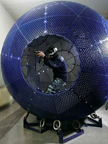
Move Freely in a Fully Immersive Environment
VirtuSphere revolutionizes the way humans interact with computers. The method and system provide infinite space and the most immersive experience for simulated training, exercise and gaming.
The VirtuSphere platform consists of a large hollow sphere that sits on top of a base and allows the sphere to rotate 360 degrees. Wearing a wireless, head-mounted display, users can step inside the sphere to fully interact in immersive virtual environments. The VirtuSphere enables 6 degrees of freedom – one can move in any direction; walk, jump, roll, crawl, run over virtually unlimited distances without encountering real-world physical obstacles.
VirtuSphere systems are made to client specifications and typically include an easy-to-assemble sphere, a base platform that enables it to rotate, a head-mounted display, 3D sensors, sphere rotation trackers, a computer, device drivers and 3D software applications. [via Rhizome]
Posted by jo at 11:19 AM | Comments (0)
Virtual Air Guitar
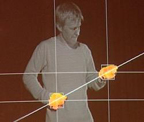
Air guitarists’ rock dreams come true
"Aspiring rock gods can at last create their own guitar solos - without ever having to pick up a real instrument, thanks to a group of Finnish computer science students. The Virtual Air Guitar project, developed at the Helsinki University of Technology, adds genuine electric guitar sounds to the passionately played air guitar.
Using a computer to monitor the hand movements of a "player", the system adds riffs and licks to match frantic mid-air finger work. By responding instantly to a wide variety of gestures it promises to turn even the least musically gifted air guitarist to a virtual fret board virtuoso.
Aki Kanerva, Juha Laitinen and Teemu Mäki-Patola came up with the idea after being invited to develop a virtual instrument as part of their coursework. "The first thing that came to mind was an air guitar," Kanerva told New Scientist. The resulting system consists of a video camera and a computer hooked up to an appropriately loud set of speakers. A player then needs only to don a pair of brightly coloured gloves in order to rock out. Computer vision software automatically keeps track of their hands and detects different gestures, as a video of the system in action demonstrates (22MB, requires Windows Media Player and DivX codec for the visual aspect of the footage)..." Continue reading Air guitarists’ rock dreams come true by Will Knight, NewScientist.com news service, November 2005. [via Eyeteeth]
Posted by jo at 09:20 AM | Comments (0)
December 01, 2005
DIGITAL STREET CORNER
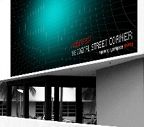
Virtual Street Corner Happening
DIGITAL STREET CORNER by Fred Forest; Art Basel Miami Beach 2005: Is it possible to surf around in cyberspace and hang out on the street corner at same time (global + local = glocal)? French artist Fred Forest will show us how at a world premiere event that will take place November 30-December 4 in the prestigious context of Art Basel Miami Beach 2005. Forest invites the Internet users of the world to meet him down in the street outside the Bass Museum of Art in Miami Beach for a memorable cyber-happening. There's no need to reserve a plane ticket because the setting will actually be a "corner" of virtual reality, specially created with the help of a new open source peer-to-peer software program developed by Joachin Keller Gonzalez of France Télécom R&D. On the dates indicated, Forest aims to make art history by creating a unique real-time digital work of art with the help of online participants near and far. This work will consummate the official (esthetic and economic) recognition of a new model of art whose content and format bear no comparison to those of the past, an art for the wired societies of the information age.
Forest is no neophyte in the field of new media. He is widely recognized as a pioneer of video art in Europe and co-founded two major avant-garde movements with a focus on interactive media hybrids, Sociological Art and the Esthetics of Communication. In reference to his hacker-like tactics, Vilem Flusser called him "the artist who pokes holes in the media." Forest is also a Net Art pioneer. He won the City of Locarno Grand Prize at the Locarno Festival of Electronic Art in 1995 for his work "From Casablanca to Locarno." People are still talking about his virtual reality-enhanced "Cyber-marriage," which took place live online in 1999 (his best man was none other than the "father of the Internet," Vinton Cerf).
The DIGITAL STREET CORNER Web site, will open on November 20, 2005 in order to give members of the public a chance to upload their free "ticket" to Miami Beach and carve out their very own niche in cyberspace. Don't miss your chance to strut your stuff in Miami Beach in the company of your new digital friends. A wealthy art collector from the world of high finance has already paid a fortune to be the first in line!
On November 30, 2005, a special cyber-happening is scheduled to take place at "THE DIGITAL STREET CORNER" between 9 PM and 11 PM (local time). Forest himself will be the DJ, at the commands of his four computers, his console, and his turntable. To participate in the happening, visit http://www.fredforest.com
Everything that happens at "THE DIGITAL STREET CORNER" will be projected live onto the exterior walls of the Bass Museum in Miami Beach throughout the four-day duration of the event. And the festivities of the cyber-happening will be webcasted live for millions to see on the "DIGITAL STREET CORNER" Web site. Don't miss your chance to meet and party with people from around the world on this virtual street corner, located for a short time only in "real" space at 2121 Park Avenue in Miami Beach. Project Sponsors:France Télécom, Bass Museum, Cartier Foundation for Contemporary Art, Cultural Service of the French Embassy in New York, French Consulate General in Miami, webnetmuseum.org
Posted by jo at 12:10 PM | Comments (0)
November 28, 2005
Walking from Thoughts: Not the Muscles Are Crucial, but the Brain Waves!
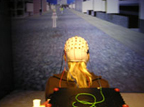
Thoughts wander in VR
"Devices that allow for direct brain-computer communications are advancing on two fronts: devices implanted in the brain, and external electrodes that pick up the brain's electrical signals. In general the external devices are safer and cheaper, but the implants provide more control.
Typically, users are able to control their brain waves in a way that moves a cursor up and down and side to side on a computer screen.
Researchers from Graz University of Technology in Austria, University College of London in England, Guger Technologies OEG in Austria and the University of Graz in Austria have expanded the amount of control available via external electrodes with a means of detecting changes in brain signals when users imagine moving their feet and translating the effect into walking motion within a virtual reality environment. Continue reading at TRN Research News.
Posted by jo at 06:06 PM | Comments (0)
Intelligent Agent Vol 5 No 1 Update
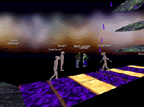
Aesthetics of Play and Empathy
"What is cyberspace? Like most important questions, the answer depends very much on whom you ask. Cyberspace seems to be highly mutable; it wears different guises for divergent questioners, depending very much on what type of glasses they are wearing. And the computer certainly qualifies as a strange kind of mirror -- the more deeply they scry its virtual depths, the more enthralled many theorists become by its digitized mutual gaze. So vast is the quantity of information available on the Internet that attempts to master the big picture cannot help but become highly self-selecting. Yet most can agree that one of the standout characteristics of the new digital paradigm which fascinates theorists and practitioners alike is its apparent revolutionary character, its fundamental newness..."
"The aesthetics which I propose can aid us to see something fresh are an 'aesthetics of play and empathy.' These terms have longstanding associations in a psychoanalytic context, as well as in other cultural contexts including art history, Buddhist studies, feminism and the post-colonial, among others." From Building a Bridge to the Aesthetic Experience: Artistic Virtual Environments and Other Interactive Digital Art by Tobey Crockett, Intelligent Agent, Vol 5 No 1.
Posted by jo at 11:54 AM | Comments (0)
intelligent agent Vol. 5 No. 1 Update

Heightening Tension and Drama in 3D Interactive Environments
"Abstract: Heightening tension and drama in 3D interactive environments is a hard, but important problem. It is important for its potential utility in increasing motivation, involvement, engagement, and providing an overall pleasing aesthetic experience. These constructs are not only useful for entertainment applications, but can also impact training and edutainment applications due to the impact of emotions on learning. To stimulate emotional engagement, many researchers have explored several techniques, including enhancing the story content, developing new algorithms for dynamically creating stunning visual effects, and enhancing 3D sound. In this paper, I describe a set of new design techniques based on a study of film and theatre theories, including acting and screenwriting. These design techniques are integrated within a multi-agent interactive drama architecture. In this paper, I will discuss this architecture elaborating on the implementation of the theories studied and discussed from film and performance arts." Applying Principles from Performance Arts for an Interactive Aesthetic Experience by Magy Seif El-Nasr, Intelligent Agent, Vol 5 No 1.
Posted by jo at 11:35 AM | Comments (0)
November 23, 2005
Objects of Virtual Desire
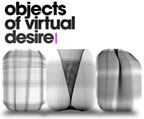
Highlighting the Materiality of the Immaterial
Objects of Virtual Desire explores immaterial production in a virtual world, and if and how this can be transferred into an economy of material production. We have collected a series of objects produced and owned by inhabitants in the online world Second Life and will sell physical reproductions of these objects via our web shop.
Each chosen object has a strong sentimental value for the avatar (a persons virtual identity) who made or owned it. We have acquired (copies of) these objects, along with their owner’s personal story, within the in-world economy of Second Life. At www.objectsofvirtualdesire.com we present 3D modeled reproductions of these objects. The objects are made available in physical form on demand. When buying the materialised object one will also receive an image of the immaterial object with its original Second Life owner.
Our interest lies in exploring the concept of product design in a virtual world and what kind of interpersonal value objects carry in this context. Further questions are raised by transferring these objects to physical space and a "first life" economy. What is immaterial value-creation and can it be materialised? What does it mean to use a virtual world as a site of production?
The issues raised are relevant in a wider context, as value-production in the "post-fordist" era has become increasingly immaterial. Nike, for example, exploits the physical function of a shoe to create and market immaterial values, so pervasive that the shoe itself becomes almost virtual.
Objects of Virtual Desire exploits the augmented value of immaterial objects to create and market tangible products, thereby reversing the process and highlighting the materiality of the immaterial.
Posted by jo at 01:21 PM | Comments (0)
October 24, 2005
Fugue
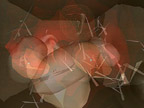
Calibrate an Artificial Immune System
Fugue is the result of a collaboration between artists, new music composer and computer scientists. The result is an on-going project which provides a new way of communicating complex scientific ideas to any audience. Immersive virtual reality and sound provide an interactive audiovisual interface to the dynamics of a complex system – for this work, an artificial immune system. Alongside with providing the greatest immersive effect currently available, this technology offers the potential to control and calibrate particular audio-visual elements.
The aesthetics of the Fugue is emergent, based upon the essential, fundamental and hidden beauty of the organic processes manifested through the dynamics of the real-time generated, unpredictable algorithm. The piece is set up as an interaction between a virtual (artificial) immune system and a human participant. Participants are able to see and interact with immune cells flowing through a lymphatic vessel and understand how the complex dynamics of the whole are produced by local interactions of viruses, B cells, antibodies, dendritic cells and clotting platelets.
The sound, envisaged as a ‘mental soundscape', a resonance of the function of immune system in the body, provides a major channel for interaction. By overlaying and modulating the sonic pulsation, cycles - such as circadian rhythms, or other inputs such as stress level, will be introduced in the future. The Artificial Immune System will ‘inhabit' the virtual space of the master server computer at the CS UCL that will run the Artificial Immune System continually, providing the possibility of being displayed on different interfaces. [via]
Posted by jo at 04:03 PM | Comments (0)
September 29, 2005
Interface [s] Montréal
![]()
[Immersion and Virtual Reality]
[Immersion and Virtual Reality] Beyond reality and interactive reality experience--From aerospace to surgery, and in all things game related, the simulators and immersion environments developed to serve humankind are indispensable tools that significantly improve human knowledge and enhance our reality experience.
Speakers: Yves Gonthier - Canadian Space Agency; Jean-Claude Artonne - Immervision; Jocelyn Faubert - Université de Montréal, École d’optométrie; Carl-Éric Aubin - École Polytechnique de Montréal, Dép. génie mécanique & CHU Sainte-Justine; Luc Courchesne - Université de Montréal et Ideaction.
TUESDAY, 4th October 2005 Interface [s] Montréal :: [Immersion and Virtual Reality]; 5:30pm - $30 at the door - package deals available.
[Yves Gonthier] Canadian Space Agency: A Real-Time Simulator for 3D Mental Image Reconstruction On-Board the International Space Station--The operations of manned and unmanned space vehicles and their associated supporting docking and robotics systems require significant crew training both on ground and on orbit. A number of psychological and physiological factors are known to affect the crew on-board performance. Therefore, skills degrade over time and the frequency, depth of proficiency and refresher training need to be studied. Currently a new experiment is designed in order to study the 3D mental image reconstruction for tasks involving the operation of all robotic components of the Mobile Servicing System of the International Space Station. The long-term goal of this research project is to gather data to study skill degradation and recovery of psychomotor and cognitive skills. This data will be analyzed to help define metrics that could be used to assess the level of readiness of an operator to perform complex tasks.
To study performance degradation and skill recovery, a highly efficient simulator is required in order to ensure on-orbit real time simulation and fast feedback to the operator. In this project, the challenge is the real-time simulation of Canadarm2 and Dextre while performing graphics rendering of the worksite environment using just a single computer, in particular a P4 1.8Ghz IBM ThinkPad. The simulator relies on the modeling technology from SGDL to generate highly realistic images. For the graphics rendering of the models, the SGDL models are transformed into an approximate polygonal representation. This minimizes the computational load on the CPU and optimizes the rendering rate by using graphics card hardware acceleration. At the same time, a collision detection algorithm is applied to the exact SGDL model to monitor any collision event.
It is planned that the experiment will be launched on the space station in April 2006.
[Jean-Claude Artonne] Immervision: Panoramic technologies in everyday applications--During the last ten years computer and optical sciences have evolved to open possibilities and create opportunities for new applications. Thanks to these technological advances today we can experience a new “Immersive” dimension.
With today’s panoramic imaging technologies we can digitalise and visualise in real-time a whole 360 degrees environment. Hosting a panoramic videoconference from your mobile phone, keeping an eye on every room of your house, preventing transportation accidents thanks to 360 degrees dynamic analysis, caring for your loved ones from distance and virtually immerging yourself inside the human body will soon all be panoramic imaging technology’s applications as common as today’s ultrasound, radar, telephone and many other technologies developed during the past 50 years.
A new 360 degrees technology invented and patented by Jean-Claude Artonne and developed by ImmerVision meet the quality, flexibility and performance required by today’s rich multimedia applications and most rigorous security and aerospace applications. It is a combination of both hardware and software that run on today’s video camera and computer technology from the smallest pocket PC to the most powerful system. The hardware includes the new panomorph lenses with increasable resolution on specific areas combined with software based on advance imaging algorithms.
[Jocelyn Faubert] Université de Montréal, département optométrique, Chair NSERC-Essilor on presbytia and visual perception: Understanding human behavior with immersive virtual environments--Full-immersive displays such as the CAVE system have been originally developed for visualization and industrial uses. Using such an environment for the study of human performance involves a number of challenges, as it was not originally designed for such a purpose. For several years now our laboratory has adapted the CAVE technology to help us understand human behavior. We are interested in determining the effect of age-related changes on perception, posture and visual-motor control in ecological environments. In particular, we try to understand how prebyopes cope with visual deformations that are induced by corrective lenses. Presbyopia is an age-related change that affects our capacity to focus at near. The first signs usually appear in the 40s and almost 100% of individuals in the 50s are presbyopic. Our initial results are extremely promising and demonstrate that a full-immersive environment is a very powerful tool for assessing human performance but this is a technology that still requires enormous resources in both initial cost and maintenance and may not be generally accessible in the near future.
[Carl-Éric Aubin] École Polytechnique de Montréal, Dép. génie mécanique & CHU Sainte-Justine: Surgical Simulator for the Virtual Prototyping of the Surgical Instrumentation of the Scoliotic Spine--Prof. Carl-Eric Aubin Ph.D., ing.; Ecole Polytechnique de Montréal, département génie mécanique & CHU Sainte-Justine; Collaborateurs : Profs. H. Labelle, B. Ozell, F. Cheriet.
[Luc Courchesne] Université de Montréal and Ideaction: Panoscope 360°--Enter the Panoscope 360° to be fully immersed in a 3D world. A 3-axis joystick placed at the center of the viewing platform will let you and your friends (up to 8) fly through the space as in dreams. This single channel immersive display uses a PC and a custom designed hemispheric projector above your head to project in real time a rendering of your entire horizon onto the hemispheric screen."
Posted by jo at 09:47 AM | Comments (0)
September 19, 2005
the Space Between the Physical and the Virtual
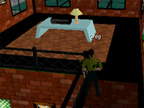
Cognitive Agents in 3D Virtual Worlds
"Abstract: We present an agent-based model of virtual worlds in which the objects in the world have agency, that is, the objects can sense their environment, reason about their goals, and make changes to the environment. The agent-based model has the following reasoning processes: interpretation, hypothesizing, and action activation. This agent model is described and illustrated using a wall agent in a multi-user virtual world. We extend the illustration through a demonstration of a multi-agent world in which many of the objects in the world interactively reason about the use of the world and respond specifically to the people in the world." From Cognitive Agents in 3D Virtual Worlds by ML Maher, JS Gero, G Smith, N Gu, University of Sydney, Australia; International of Design Computing, Vol 6, 2003.
Also: Interfacing Virtual & Physical Spaces through the Body: The C y b e r P R I N T Project

"Abstract: The cyberPRINT is a fully immersive, interactive virtual environment that is being generated in real time based on physiological data readings of a human body. In other words, the cyberPRINT is based on creating interfaces between physical and digital spaces and between biology and information technologies. The cyberPRINT is also an event, wherein a performer is connected to the cyberPRINT generator to create a self-sustaining feedback mechanism. Although the use of the body to electronically drive music and media events is not new, most of these works have paid little or no attention to the potential of interactive 3D virtual environments. Nor have they been so technologically advanced, interdisciplinary intensive (involving Architecture, Choreography, Modern Dance, Music, Bioengineering, Medicine and Computer Science), or architecturally focused as the cyberPRINT.
This project covers a wide and fertile territory that goes from the very technical and design oriented to the very theoretical and interdisciplinary. This paper is intended to (1) expand what has been already published about this project (Bermudez et al 2000a) and (2) establish potential areas for discussion before and after the performance."
1. Introduction: Why a Live Performance?
This paper provides background for the live performance of the cyberPRINT, a real time, physiologic data-driven virtual architecture developed by an interdisciplinary team led by two architects during the past 5 years. The reason for this live performance and demonstration is simple. It is only through performance that we can show the true nature of the cyberPRINT. Such demonstration will also provide empirical proof of the theoretical claims and technological details already published elsewhere (Bermudez et al 2000a). In addition, this version of the cyberPRINT will add some novelties occurred since then (such as a new virtual world, data-driven music in real time, a navigational data-globe). Images of a live performance are shown in Figure 1. [via]
Posted by jo at 11:38 AM | Comments (0)
August 26, 2005
Residual Data-Cloud
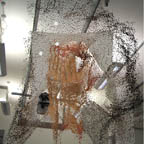
Residual Memory Immersed, Materialized in a Real Environment
The Residual Data-Cloud--by Diogo Terroso--is an application that loads images from a networked source and generates a data-driven three-dimensional form. Images are collected via a digital camera, or a mobile phone, by the author and participants during presentation. The resulting shape, which resembles a cloud of dust, is a metaphor of residual memory immersed and somehow materialized in a real environment.
Digital appears here as a parallel dimension, in which user’s perception is subjected to layers of abstraction and figuration. Its behaviour in the real space, captured by a tracking device, affects data display by revealing different properties of the cloud. Recognizable shapes appear and disappear through interaction. Movie.
Posted by jo at 10:26 AM | Comments (0)
August 25, 2005
StarChild + FlatWorld

Data Sonification
Data sonification has been viewed as a tool with great potential for studying complex sets of scientific data. Sonification can provide the researcher with the ability to perceive variations and trends that are invisible to more established data analysis techniques. However, few have explored the potential artistic applications of sonification. In 1996, Jarrell Pair worked with Alec Robinson to se Matlab and Csound to prototype software to transduce data from various sources such as images, temperature, and light intensity into aesthetically pleasing audio. We used this work to develop the audio effects for StarChild. Using Csound and a custom C program, astronomical data from the Shoemaker Levy-9 comet collision was used as input to create audio for portions of StarChild. Additionally, images of the collisions with Jupiter were transduced into audio effects using Hyperupic, an application running on a NeXT computer. 440k MP3 file (low sample rate) taken from the sample files created from the comet collision.
From July 1995 through June 1996, Pair was extensively involved in the technical development of StarChild, a multimedia opera. The opera was composed and produced by Audio Research Team director, James Oliverio. Alec Robinson and Pair created sound effects for the opera using data sonification methods we had developed as part of an ongoing team project. He was also involved in the installation, testing and evaluation of the eight channel audio steering system used in the opera.
The StarChild production team included visual futurist Syd Mead (designer for the films Blade Runner, Aliens, Tron, and Star Trek: The Motion Picture ), the internationally recognized lighting designer Lloyd Sobel, animator Steve Walker, and scientists and engineers from across the Georgia Tech Campus. Students met and worked with the guest artists in workshops, lectures, and in the production of the opera itself. An internet MBone broadcast of StarChild took place on June 5th, 1996. Two live performances followed on June 6th and 7th.

FlatWorld: The Mixed Reality Simulation Space
Since 2001, Pair has overseen the design and development of the FlatWorld project at the University of Southern California's Institute for Creative Technologies (ICT).
FlatWorld is a mixed reality simulation environment merging cinematic stagecraft techniques with immersive media technology. Current virtual environments have severe limitations that have restricted their use. For example, users are often required to wear bulky head mounted displays that restrict a person’s freedom to physically move as they would in the real world. Furthermore, a person cannot touch or feel objects in the virtual world.
This project addresses these issues by developing an approach to virtual reality simulation which allows individuals to walk and run freely among simulated rooms, buildings, and streets.
Posted by jo at 10:33 AM | Comments (0)
August 24, 2005
Immersive 3D TV
Watch, Sniff and Feel the Big Game
Almost 77 years after the first demo of stereo TV in 1928 by John Baird, there's evidence of a strong resurgence of interest and research in immersive TV:
"The Japanese Government is quietly throwing huge financial and technical weight into the development of three-dimensional,virtual reality television",reports the Times.It "has obtained an interim report from the Communications Ministry’s "Universal Communications" study group detailing the work in progress.Three-dimensional images apart,the ministry wants to develop the ability to send thousands of different odours through the new television to enhance the sense of reality.Its plans also call for the "recreation of tactile sensations",a hitherto elusive concept that would give viewers the ability to reach out and "feel" what they were seeing.Current projects are working on electrical stimulation for the fingers, ultrasound and air pressure." From The Times Online (via smartmobs) [blogged by sfisher on USC Interactive Media]
Posted by jo at 11:26 AM | Comments (0)
August 22, 2005
Masaki Fujihata
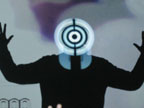
Innovative Public-Led Expedition
bodydataspace (b>d>s) have created a Multi-Media Design Studio with 3-D Exhibition Space for the newly renovated Jaywick Martello Tower. The premiere exhibition for the inaugural opening will be Mersea Circles by Masaki Fujihata. It is a 3-D interactive installation that emerged from an innovative public-led documentation process in August 2003. Taking place on Mersea Island, just off the Essex coast, some 150 people participated all using DV cameras and GPS. As they explored the terrain and its people they captured, with position data, their discoveries and experiences of the landscape, talks and interviews. From the myriad of data gathered, internationally renowned artist, Masaki Fujihata created his latest work.
In addition to the above exhibition, the event on Saturday, 17th September will include a live performance of Soft Ices by artist Mark Storor and composer Jules Maxwell at 3pm. There will also be a site-specific exhibition from the photographer John Kippin.
[b>d>s] is a design unit that delivers artist-led projects into architectural applications and uses interactive technologies to enable people to learn, develop and extend within intelligent data spaces, ultimately enabling the public to have a direct impact on the content of the space they inhabit. It combines the specialist knowledge and creative direction of its founders Ghislaine Boddington (body technology artist) and Armand Terruli (architect/video artist) in a unique collaboration that explores the artistic and technical opportunities present in the fusion of body, data, and space.
Masaki Fujihata / Mersea Circles / COAST: Masaki Fujihata is one of nine artists who have produced artworks for COAST, Essex County County’s ambitious art project celebrating the Essex coast. Mersea Circles is housed permanently at the Jaywick Martello Tower as well as the Ars Electronica Museum in Linz.
Saturday, 17th September 2005
12.30-3pm (invite only)
3-6pm (open to public)
Jaywick Martello Tower, Jaywick,
Clacton-On-Sea, Essex CO15 2LF
Entrance is FREE
Jaywick Martello Tower is the latest digital arts venue to open in the UK and one of the most unusual. This heritage project has transformed the Napoleonic tower’s first floor into a state-of-the-art environment where b>d>s have created a multi-media studio for exhibitions, events and workshops. It includes a floor to ceiling curved projection screen for immersive three-dimensional and audio-visual installations. This unique tower will act as a national resource for commissioning and presenting digital art from regional, national and well-known international artists.
The venue is the accomplished result of a 3-year collaborative venture between Essex Council, Bishops Park College and bodydataspace bringing together the arts, community and education. The Jaywick Martello Tower is managed by Bishops Park College, one of the brand new pioneering schools built under the Labour Government.
DIGITAL ARTS VENUE OPENS
Saturday, 17th September 2005
12.30-3pm (invite only)
3-6pm (open to public)
Jaywick Martello Tower, Jaywick,
Clacton-On-Sea, Essex CO15 2LF
bodydataspace (b>d>s) have created a Multi-Media Design Studio with 3-D Exhibition Space for the newly renovated Jaywick Martello Tower, featuring the work of international Japanese artist Masaki Fujihata.
Jaywick Martello Tower is the latest digital arts venue to open in the UK and one of the most unusual. This heritage project has transformed the Napoleonic tower’s first floor into a state-of-the-art environment where b>d>s have created a multi-media studio for exhibitions, events and workshops. It includes a floor to ceiling curved projection screen for immersive three-dimensional and audio-visual installations. This unique tower will act as a national resource for commissioning and presenting digital art from regional, national and well-known international artists.
The venue is the accomplished result of a 3-year collaborative venture between Essex Council, Bishops Park College and bodydataspace bringing together the arts, community and education. The Jaywick Martello Tower is managed by Bishops Park College, one of the brand new pioneering schools built under the Labour Government.
The premiere exhibition for the inaugural opening will be Mersea Circles by Masaki Fujihata. It is a 3-D interactive installation that emerged from an innovative public-led documentation process in August 2003. Taking place on Mersea Island, just off the Essex coast, some 150 people participated all using DV cameras and GPS. As they explored the terrain and its people they captured, with position data, their discoveries and experiences of the landscape, talks and interviews. From the myriad of data gathered, internationally renowned artist, Masaki Fujihata created his latest work.
In addition to the above exhibition, the event on Saturday, 17th September will include a live performance of Soft Ices by artist Mark Storor and composer Jules Maxwell at 3pm. There will also be a site-specific exhibition from the photographer John Kippin.
Entrance is FREE.
For b>d>s Press Invites, additional INFO and IMAGES contact Jamie McLaren:
Tel: 07949 111 871 or 020 7357 0823 / Email: jamie@bodydataspace.net
Partners of the renovation project include Essex County Council, the Heritage Lottery Fund, European Union through the Intereg IIIB programme, English Heritage, the Essex Rural Renaissance Fund, Essex Environment Trust, Park Resorts, EEDA and Tendering District Council.
NOTES TO EDITORS:
bodydataspace
b>d>s is a design unit that delivers artist-led projects into architectural applications and uses interactive technologies to enable people to learn, develop and extend within intelligent data spaces, ultimately enabling the public to have a direct impact on the content of the space they inhabit.
b>d>s combines the specialist knowledge and creative direction of its founders Ghislaine Boddington (body technology artist) and Armand Terruli (architect / video artist) in a unique collaboration that explores the artistic and technical opportunities present in the fusion of body, data, and space.
Masaki Fujihata / Mersea Circles / COAST
Masaki Fujihata is one of nine artists who have produced artworks for ‘COAST’, Essex County County’s ambitious art project celebrating the Essex coast. To find out more about the COAST project go to http://www.coastart.org
Mersea Circles is housed permanently at the Jaywick Martello Tower as well as the Ars Electronica Museum in Linz.
Managed by the local secondary school, Bishops Park College, it is planned that the Jaywick Martello Tower will be a catalyst for change, developing digital vocational skills. It will provide inspiration for the local community and attract interest and visitors from around the country and overseas to this unique location.
The site provides public access during the summer for environmental and historical groups, schools, tourists, walkers and visitors from overseas.
A permanent on the ground floor for a series of specially-commissioned permanent artworks by artist John Kippin on the theme of Essex coastal landscapes and the history of its military installations, linked with sites abroad.
A base for community arts projects with links to local schools.
Observation facilities on the on the roof, including a purpose-built look-out station, to be used by the National Coastwatch Institute (NCI). Visitors will also be able to use this facility.
The National Coastwatch Institute is a charity run by volunteers (principally retired people), who provide a visual watch to back up HM Coastguard.
European Interreg is a trans-European body which supports and finances international cross-border projects to achieve balanced regional development.
For information on the centre including the performance event Soft Ices and the work of John Kippin, contact: Keith Watson, Digital Arts Development Officer (c/o Bishops Park College):
Tel: 07802 748 484 / Email: mailto:keith@deluxe-arts.org.uk
Bishops Park College is not so much a school in the community but the community in a school with public library, family support day centre, cyber café, early year’s office and a purpose built neighbourhood nursery. The idea of community was a guiding principle in the overall design of the school, funded by the Private Finance Initiative.
The Head Teacher is Mike Davies.
LINK to Guardian Unlimited Feature on Bishops Park College: http://education.guardian.co.uk/egweekly/story/0,5500,1510479,00.html
Posted by jo at 09:14 AM | Comments (0)
August 09, 2005
Super-i®
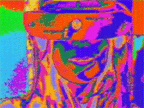
Real Virtuality™ System
Super-i® is made for those who want to see the world differently, - painted in fresh new colors. With Super-i® you'll be fascinated by what you see: the world as you know it will be looking absolutely different. Our goggles are equipped with the brand-new system of Real Virtuality™, which changes "real" world around us into a virtual one, and does it without a computer and in real time!
With our product you will not have to spend time sticking to your monitor and stressing your eyes; you will not have to wait long until the system boots up; you will not be unhappy with the image quality anymore! And, most importantly: with Super-i® you will finally reach unimaginable level of freedom - freedom to physically move around in the space in any direction, indoors or outdoors!
How does it work?
The heart of Super-i® is a microchip developed by our company on the basis of the newest technologies. It allows real-time (without delay) processing of a video signal and applying different effects on it. Other system components are: a video camera with a "human" angle of view, and a pair of excellent image quality micro-displays. The whole system is assembled inside a lightweight goggles that comfortably fits any head. The unit is absolutely autonomous and is powered by standard AA batteries, which can run it for few hours.
Effective algorithms, similar to those used in professional systems of image processing (such as Adobe Photoshop™) are embedded into Super-i®. The quality of the camera and micro-displays is so great, that not only you'll be able to explore the wonderfully altered reality, but also to get around easily. [via]
Posted by jo at 06:55 AM | Comments (0)
August 07, 2005
m@terials:
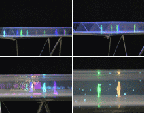
3D Theater on a Table
m@terials, developed by Jitsuro Mase, use an off-the-shelf LCD projector to display a "3D theater" on a table. A video clip available on the Digital Stadium website. It's amazing that this actually works because the hardware device looks deceptively simple. On the table top are transparent plastic strips standing diagonally at 45 degrees. The plastic strips make images stand up. The virtual people can be projected on to a strip closer to you or the ones further away from you.
Digital contents that can be effectively displayed on this device should conform to specific rules, however, "it is not so difficult" according to the creator of this device. This device could be used for many different kinds of things besides the "3D theater" especially if it could be made larger (possibly as big as a computer displays or a building floor?) with hi-fidelity realistic images. [blogged by manekineko on we-make-money-not]
Posted by jo at 07:05 AM | Comments (0)
August 04, 2005
Virtual Playa Project
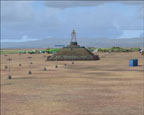
Burningman Cybercamps
The VIRTUAL PLAYA PROJECT is a navigable 3d digital Burningman environment using Microsoft Flight Simulator as a platform. It is intended to be an open-ended project that invites participation at various levels. It can be downloaded for home use; played on a giant screen at a Burningman event, or even be used as a design tool for a theme camp or artist wishing to plan an installation before it ever gets to Black Rock City.
The ultimate wish for the project however, is for the Virtual Playa to be the Burningman Cyber Regional. Using multi player technology, it can become a portal through which we can meet on line, and share experience with other cyber burners from anywhere in the world in real time. This takes the project from just being a cool piece of collaborative digital art, to a true meeting place for the cyber-tribe. Download it for free, copy it, send it to pals, leave it on buses, give it away as a gift.....spread the word.
Posted by jo at 07:01 PM | Comments (0)
July 28, 2005
intelligent agent Vol. 5 No. 1
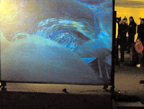
Artistic Virtual Environments, Aesthetics and Experiences
Guest Editor: Dena Elisabeth Eber, Artistic Virtual Environments, Aesthetics and Experiences: This special issue of Intelligent Agent presents six essays that explore the aesthetics connected with virtual environments created and presented as works of art, works about art, or related genres. The essays primarily focus on the aesthetic experience for participants, aesthetic analysis, content, emotional content, emotional experiences, and the qualities of the medium.
//artistic virtual environments//
Dena Eber, Greg Little, Brian Betz, "The Aesthetic Experience, Emotion and an Artistic Virtual Environment": Eber, Little, and Betz explore the aesthetic experience for participants interacting with artistic virtual environments (AVEs). Their essay presents aformal study that measures the experience through the emotional response of participants, which gauges the perceived emotional content of the AVE. The authors examine if this kind of content coupled with the immersive qualities of the AVE facilitates a rich aesthetic experience and thus a high feeling of presence for the participant.
Josephine Anstey, "Agents in Love. On the Construction and Use of Emotional Characters in VR": Anstey discusses her approach to interactive drama that provides an "emotional terrain" for the participants to discover. According to Anstey, emotional response is best elicited by employing two key components, the application of dramatic tools for narrative media to immersive virtual environments and the use of artificial intelligent agent-actors that guide participants. Anstey applies ideas similar to Alfred Hitchcock's psychological approach to a scripting process in which the theme centers on anxiety and emotional tension.
For a full Table of Contents, visit http://www.intelligentagent.com
This issue was made possible by funding from the New York State Council for the Arts, a state agency.
intelligent agent
Editor-in-Chief: Patrick Lichty
Director: Christiane Paul
http://www.intelligentagent.com
intelligent agent is a service organization and information provider dedicated to interpreting and promoting art that uses digital technologies for production and presentation.
Posted by jo at 09:08 AM | Comments (0)
May 04, 2005
RealReflect
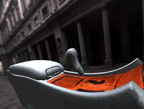
Next Gen VR Modeling
A giant leap forward in the realism of virtual reality (VR) may be just around the corner as a team of European researchers near the completion of a pioneering project to add textures, lighting effects and ‘feel’ to computer-generated 3D models. Launched in 2002, the RealReflect project was the first attempt to use a new image acquisition technique known as Bidirectional Texture Function (BTF) that captures the look and feel of different materials. [...]
"RealReflect is a major advancement over traditional virtual reality modelling, which basically relies on simplifications of reality by describing optical properties of a surface by a 2D matrix of data that does not show the real effects of lighting...Traditional virtual reality modelling, despite its name, lacks the feeling of reality and is a poor representation of it because the way things look highly depends on how they are illuminated and from what direction they are being viewed."
By taking those two aspects – lighting and viewing direction – into account, the RealReflect system is capable of acquiring and rendering in VR even the most subtle textures, from leather on a car seat and wood panelling on a dashboard to metallic paint or chrome on door handles. Textures can be acquired from physical samples and then rendered onto the 3D models. [Link to full image of gearshift on right modeled by Uffizi lighting] [...]
That in turn brings with it additional complications. In order to be able to realistically represent textures the system requires a thousand times more data than other VR modelling tools, leading the project partners to develop compression techniques for the BTF information. The compression allows the models to be viewed and worked on in real time. [...]
The project also developed methods to take a small acquired sample of a material and multiply it seamlessly on a 3D model, which when viewed would show not only the texture but also its appearance under different types of illumination from different angles.“
[Information Science Technologies]
[Demos and Downloads at RealReflect] [blogged by John on Ratchet Up!]
Posted by jo at 10:57 AM | Comments (0)
April 27, 2005
Presence
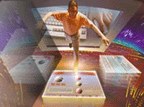
AR/VR:Mind/Body
"ABSTRACT: In augmented reality (AR) environments, users experience the physical environment and other users directly along with the mediated virtual objects embedded in the environment. In immersive virtual reality (VR), the user's experience of a visual environment (and sometimes other senses) is completely mediated. The representation of the user's body in virtual environments granted us new research territory in dualistic interaction between the mind and body: how do the virtual body and the user's mind interact (with) one another and eventually effect the user's behaviors in the envrionment? An experiment was conducted to explore the potential effect of users' and interactant's bodies to sense of presence in VR and AR environments. Results from the study suggest that the absence of representation of the user's body in VR environments may lessen (her) sense of spatial presence compared with AR environments." From Comparing Differences in Presence during Social Interaction in Augmented Reality versus Virtual Reality Environments: An Exploratory Study by Tang, A., Biocca, F., and Lim, L. (2004).
Posted by jo at 07:48 AM | Comments (0)
April 25, 2005
lifeClipper

The Walking Experience
lifeClipper is an open air art project. It offers an audiovisual walking experience in a virtually enhanced reality. Technically it is based on portable computer equipment worn by an individual. When walking around in a chosen culturally interesting area or impressive landscape the visitor's position and viewing direction is measured by means of GPS and the found situation augmented according to defined presets. Image and sound are displayed on an HMD (Head Mounted Display). Live captured image and sound are treated in real time by altering parameters as well as by adding music (composition, spoken text and sampling of documetary material), photo and video material (documentary and fictively arranged).
Through interventions on habitual ways of listening and seeing, reality becomes questioned and day-to-day situations become an adventure. Users feel as though they are watching a film in which they participate as active observers and in which they get attention from virtual players. The borders between subjective and objective perception become blurred as the user is immersed into space and action but also contemplates artistic compositions and cultural reflections. Read a review.
Posted by jo at 09:28 AM | Comments (0)
April 20, 2005
InterPlay: Loose Minds in a Box

Six by Six
InterPlay: Loose Minds in a Box is a collaborative work that explores the basic concept of the "box". The box is a metaphor for the physical, social, political or psychological constraints that we and/or others place upon us. The box also represents a sense of place in the realm of the virtual as well as in our sub-conscience. InterPlay is a multi-faceted telematic event that consists of six simultaneous performances that occur in six states throughout North America. The performances incorporate theater, text, music, performance art, virtual reality, and motion capture and are concurrently captured, mixed, digitized, encoded and streamed onto the network.
Posted by jo at 08:42 AM | Comments (0)
March 10, 2005
Organum: The Game
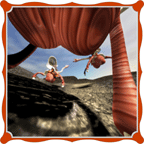
Anticipated Adaptations and Evolutions
Organum: The Game is being developed by a six-person team led by Greg Niemeyer and Chris Chafe; in the multiplayer game, users conspire with other organs that have been freed from their respective bodies, controlling game play through a collaborative vocal-input interface. The game is designed to encourage highly cooperative performance that combines real-world, embodied performance with virtual play.
Additionally, players' success in the virtual world of the game will hinge upon their willingness to register as real-life organ donors. We are conducting various organ donor drives in association with the production of all three Organum media projects." [via Jane McGonical's web site]
Posted by jo at 05:50 PM | Comments (0)
March 09, 2005
CITYCLUSTER

From the Renaissance to the Gigabits Networking Age
CITYCLUSTER is a virtual-reality networking matrix, a creative high-tech container with original technological features, navigation, interactivity and graphic and content style. In which multiple environments, ambiences or cities both real and imagined, can be hosted, coexist and be interrelated within themselves through a common, virtual territory, interconnected by high-speed network, enabling remote participants to interact and collaborate in shared environments.
The framework may be expanded, modified, enriched, developed, and produced ad hoc in accordance with the nature and typology of the environment to be incorporated. Visitors, with their own creativity and communicative skills, can become protagonist and/or free citizen: navigate, interact, intervene exchange buildings, objects and ideas and or create their own ideal environment.
Posted by jo at 11:30 AM | Comments (0)
March 04, 2005
Imaging Place
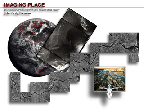
A Model Strategy for Collaboration
"Imaging Place--by John (Craig) Freeman--is a documentary virtual reality method, which uses a combination of panoramic photography and digital video to investigate place. Although the method borrows freely from the traditions of documentary still photography and filmmaking, the Imaging Place method departs from those traditions by using the emerging nonlinear narrative structures made possible by new interactive technologies and telecommunication apparatuses. It is exhibited primarily in alternative art exhibition spaces, museums and over the Internet. The work is projected up to nine by twelve feet in a darkened space with a podium and a mouse placed in the center of the space, which allows the audience to navigate throughout the project. When it is activated by the click of a mouse, the project leads the user from global satellite and vertical aerial perspectives to virtual reality scenes on the ground.
The user can then navigate throughout an immersive virtual digital video space. Rather than the linear structures of the novel or cinema, this new form allows the story to unfold in a meandering labyrinth of discovery and associations. The goal of the Imaging Place method is to document sites of cultural significance, which for political, social, economic or environmental reasons are under duress, at risk of destruction or undergoing substantial changes. This includes historic sites as well as sites of living culture which are being displaced by globalization and the collapse of industrial modernism.
Imaging Place is designed to accommodate interdisciplinary collaboration conducted across institutions and over distances. It uses new technology to bring disparate bodies of knowledge together through the investigation and documentation of place. The method attempts to bridge the gaps in understanding that exist between esoteric disciplines that have developed as a result of academic and industrial specialization. The technological tools are now available for bringing the work of experts together without sacrificing the depth and dimension of specialized knowledge and to connect the abstraction of highly specialized thinking with the visceral experiences of people on the ground. In addition to providing a form for the generation, dissemination and accumulation of interdisciplinary research and artistic production, the Imaging Place method provides a model strategy for collaboration."
Posted by jo at 08:10 AM | Comments (0)
February 24, 2005
The New Performer: Data as Performer and Performance
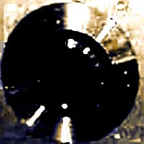
In Pursuit of the Virtual Performer
"The nature of all performance includes the elements of time-based experience and space as "stage". I use the term "stage" as a simple reference point to describe the space in which a performer performs and not as reference to the theatre. The nature of performance in the computer age includes these elements of time and stage as space. A simple definition of performance is : that which is feigned or pretended. It is action. It is speech. It is anything performative. The nature of the performer includes any entity who/which feigns, pretends, acts, and speaks. So, it is natural to include non-human entities, such as robots, cyborgs, and databases in this discussion of performance. Baudrillard might describe performing and the performer as more real than real, so real that they are virtual. "Of course we have a multitude of objective, real proofs, but what does one do with historical reality in a system which itself has become virtual? "(1)
New media's complex nature has influenced the nature of performance to become something many don't consider performance. Anything involving action, interaction, time, and space is performance. Therefore, performing is both real and virtual, becoming more real than real through the very nature of simulation. Performance on and of the net includes everything from virtual actors (interactors) interacting with real actors, Moos, Mud's, Mucks, Games, Chat groups, telepresence, Database as performance. The performer is data. The performer is virtual. The history of virtual performance begins with interaction between the real and hyperreal in time-based experience in a space referred to as the stage." From The New Performer: Data as Performer and Performance by Sheila A. Malone.
Posted by jo at 08:11 AM | Comments (0)
February 23, 2005
Negotiating the In-Between:
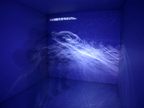
Liquid Boundaries
Abstract: As an artist working in the field of virtual reality, I explore dynamically emergent environments with immersive, interactive display systems, which enable me to produce performative realities in which the boundaries between the Self and the (alleged) Other become liquid. This paper addresses the representational issues and performative aspects of virtuality and, through discussion of two of my works, examines the ambiguities inherent in contemporary technological expressions of a more or less disembodied Self as it inhabits (tele-)immersive virtual environments. Read Negotiating the In-Between:Space, Body and the Condition of the Virtual by Petra Gemeinböck, Crossings: Electronic Journal of Art and Technology, Issue 4.1
Posted by jo at 03:59 PM | Comments (0)
February 22, 2005
Brainscore
![photo06[1].gif](http://www.turbulence.org/blog/images/photo06[1].gif)
Avatars As Virtual Filters
Brainscore, by Darij Kreuh and Davide Grassi, features two performers in front of a screen where computer-generated events are projected. A console allows performers to act in a virtual reality environment through their avatars.
Three electrodes attached to the performer's heads transmit the brain's electric signals to an electroencefalograph, which analyses and transfers them to a computer, which in turn processes them. An eye-movement tracking system enables the performers to control visual entities in Virtual Reality by their eye movements. Viewers watch the performance wearing polarized glasses to perceive the events in 3D as appearing between the two performers. The flow of the information moves from physical space into virtual (performers > avatars) and than back (avatars > audience). Avatars act thus as a "virtual filter" between performers and audience. [blogged by Regine at near near future]
Posted by jo at 03:27 PM | Comments (0)
January 27, 2005
Re-Place-ing Space:
The Roles of Place and Space in Collaborative Systems
ABSTRACT: Many collaborative and communicative environments use notions of "space" and spatial organisation to facilitate and structure interaction. We argue that a focus on spatial models is misplaced. Drawing on understandings from architecture and urban design, as well as from our own research findings, we highlight the critical distinction between "space" and "place'." While designers use spatial models to support interaction, we show how it is actually a notion of "place" which frames interactive behaviour. This leads us to re-evaluate spatial systems, and discuss how "place," rather than "space," can support CSCW design. [via clippings] Read full paper >>
Posted by jo at 05:52 PM | Comments (0)
January 24, 2005
immersence

Still Powerful
Fusing art and technology, Char Davies has achieved international recognition for her work in virtual reality. Integrating real-time stereoscopic 3-D computer graphics, 3-D localized sound and user interaction based on breath & balance, the immersive environments Osmose (1995) and Ephémère (1998) are world-renowned for their artistic sensibility, technical innovation, and powerful effect on participants.
Posted by michelle at 06:03 PM | Comments (0)

